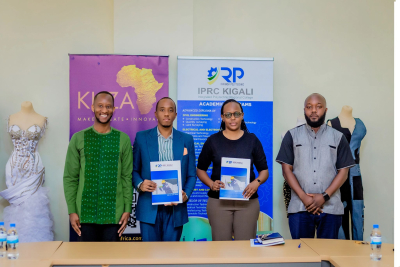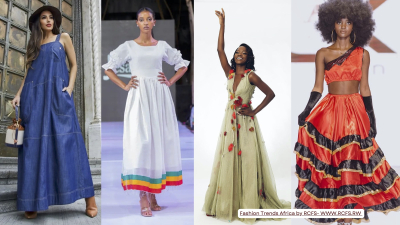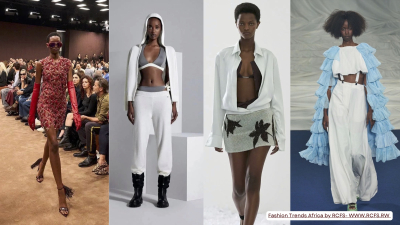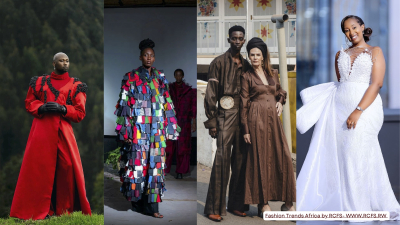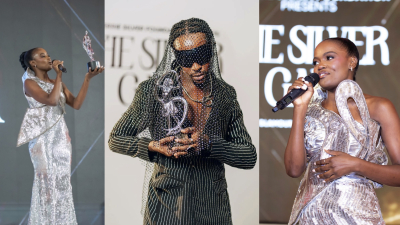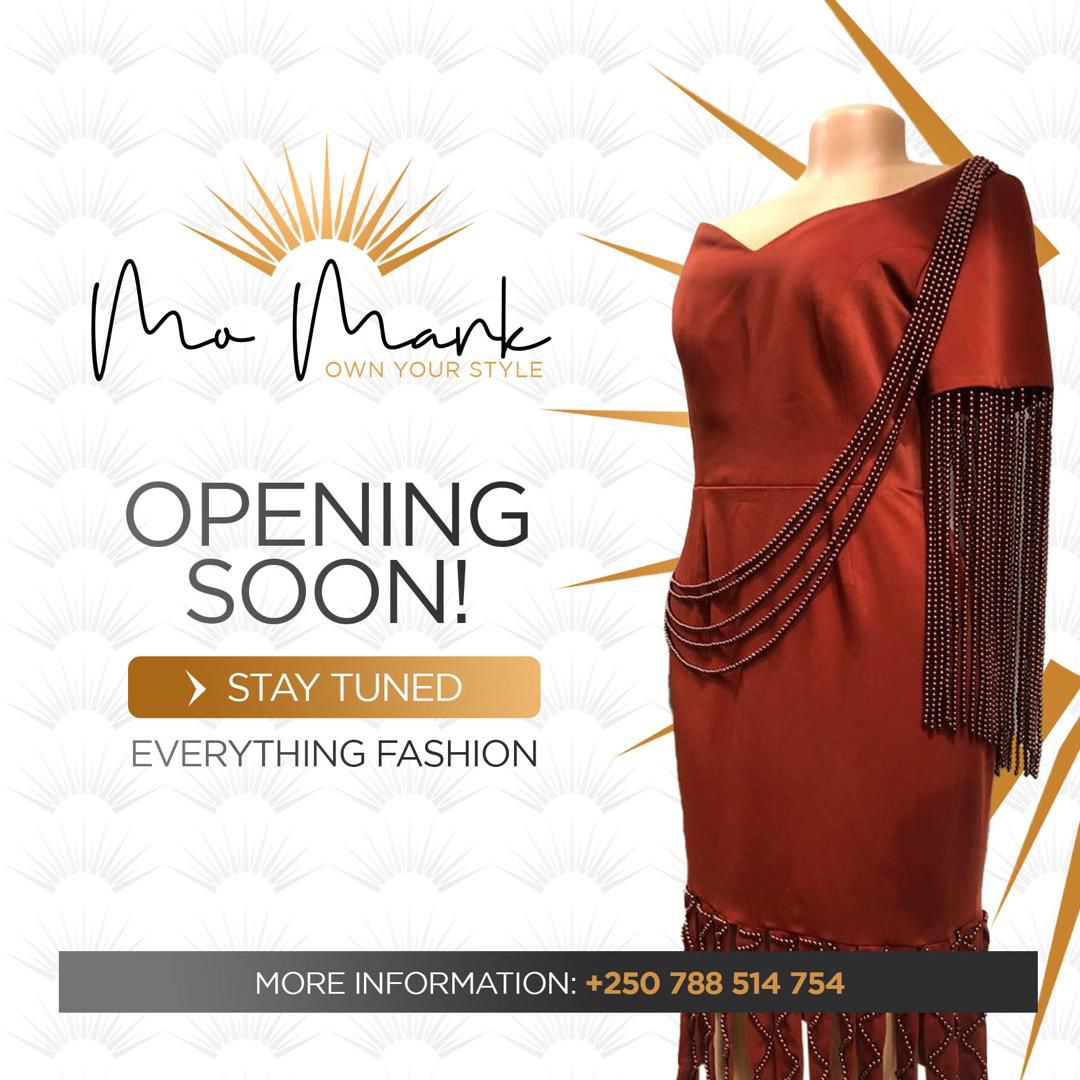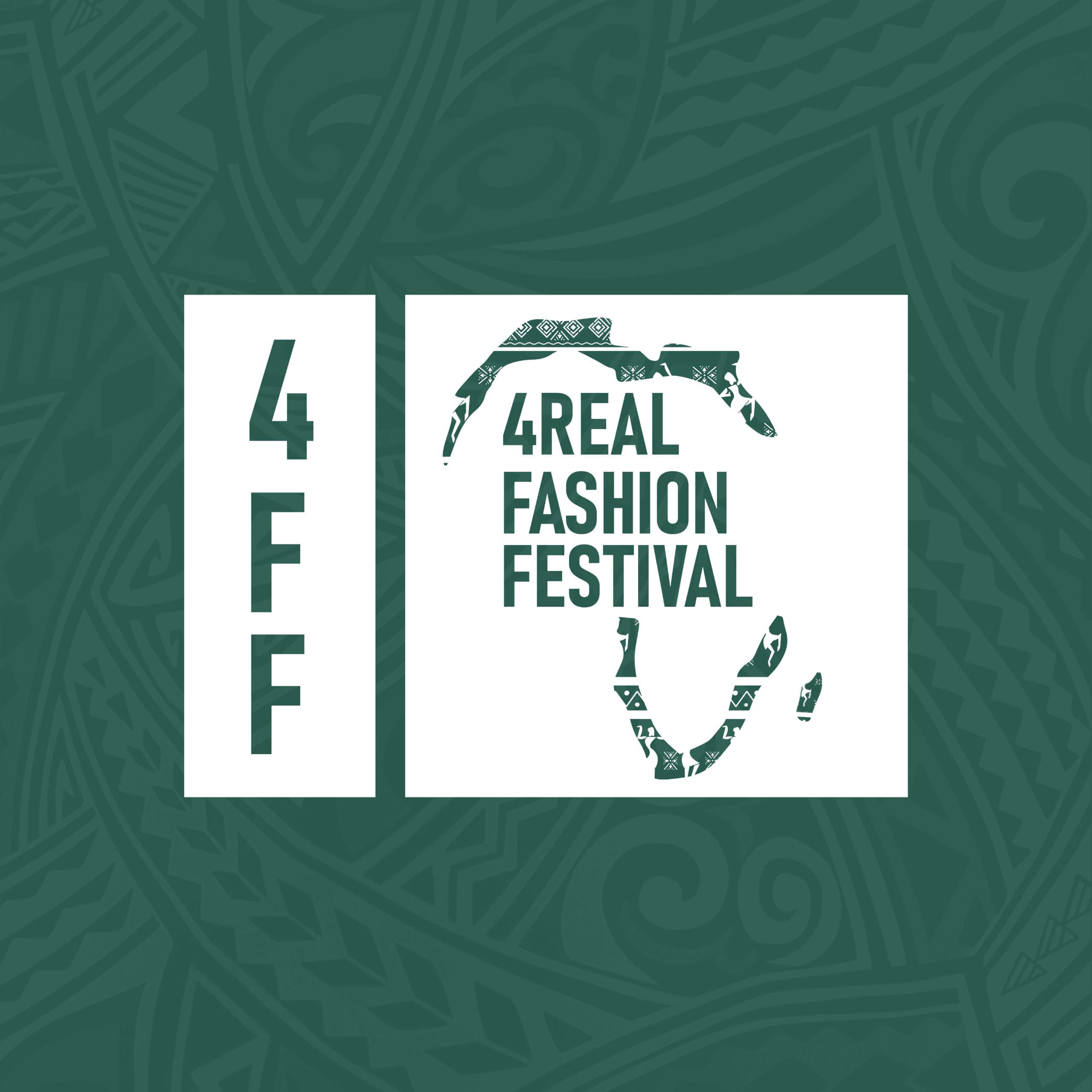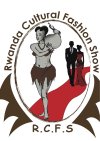
RCFS
Cesta baskets are handwoven of locally sourced, renewable resources, by talented female artisans in Rwanda, Africa who are best in class at their craft. They create consistent, fair-wage opportunities that empower women and drive sustainable income. Each piece is hand-finished in Italy and is a reflection of the brand's thoughtful approach to production.
Meghan Markle has recently garnered attention for her investment in Cesta Collective, a Rwandan handbag brand that empowers female artisans. Known for her keen investment choices and advocacy, Markle has become Cesta Collective's first equity investor and strategic partner, said Courtney Weinblatt Fasciano, who co-founded the luxury bag company with Erin Ryder in 2018.
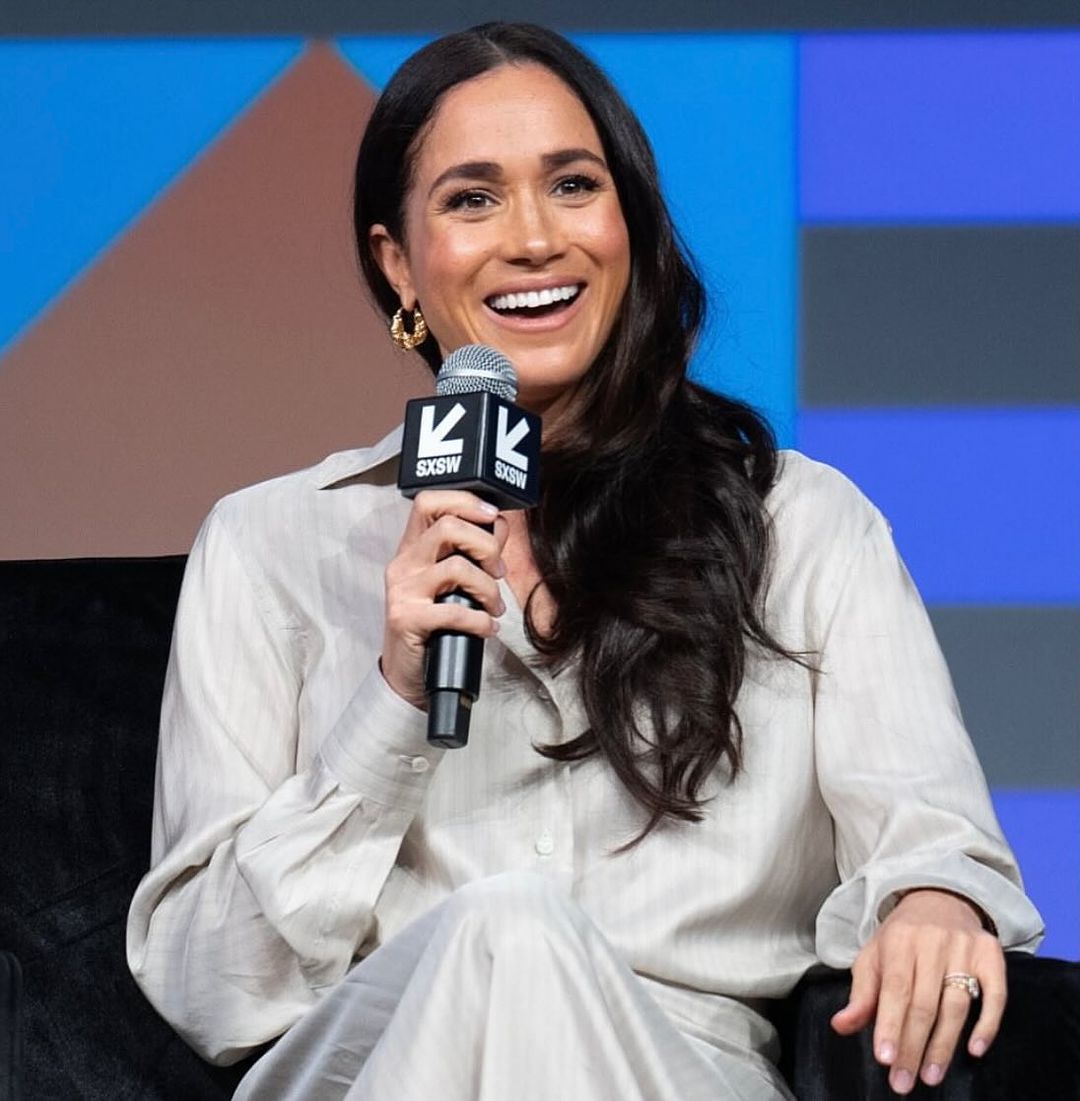 [PHOTO: Meghan Markle speaking during the celebrating Women’s Day in Texas at the SXSW Conference March 2024]
[PHOTO: Meghan Markle speaking during the celebrating Women’s Day in Texas at the SXSW Conference March 2024]
Markle's investment is not merely financial. She expressed her admiration for Cesta Collective's ethos. "Courtney and Erin have a really incredible and strategic business. The quality of a brand's products, the supply chain, ethical standards and practices, these are all things that I consider before making an investment," Markle told The New York Times. "With Cesta, I really started to understand how many women's lives were being impacted and uplifted through their work. That was incredibly important to me."
Cesta Collective, which specializes in basket bags that are handwoven by a collective of women in Rwanda and finished in Italy, caught Meghan's eye while she was online shopping. "I spend a lot of time just Googling, looking for brands, when people are online looking for things or reading things, I'm trying to find great new designers, especially in different territories," she said.
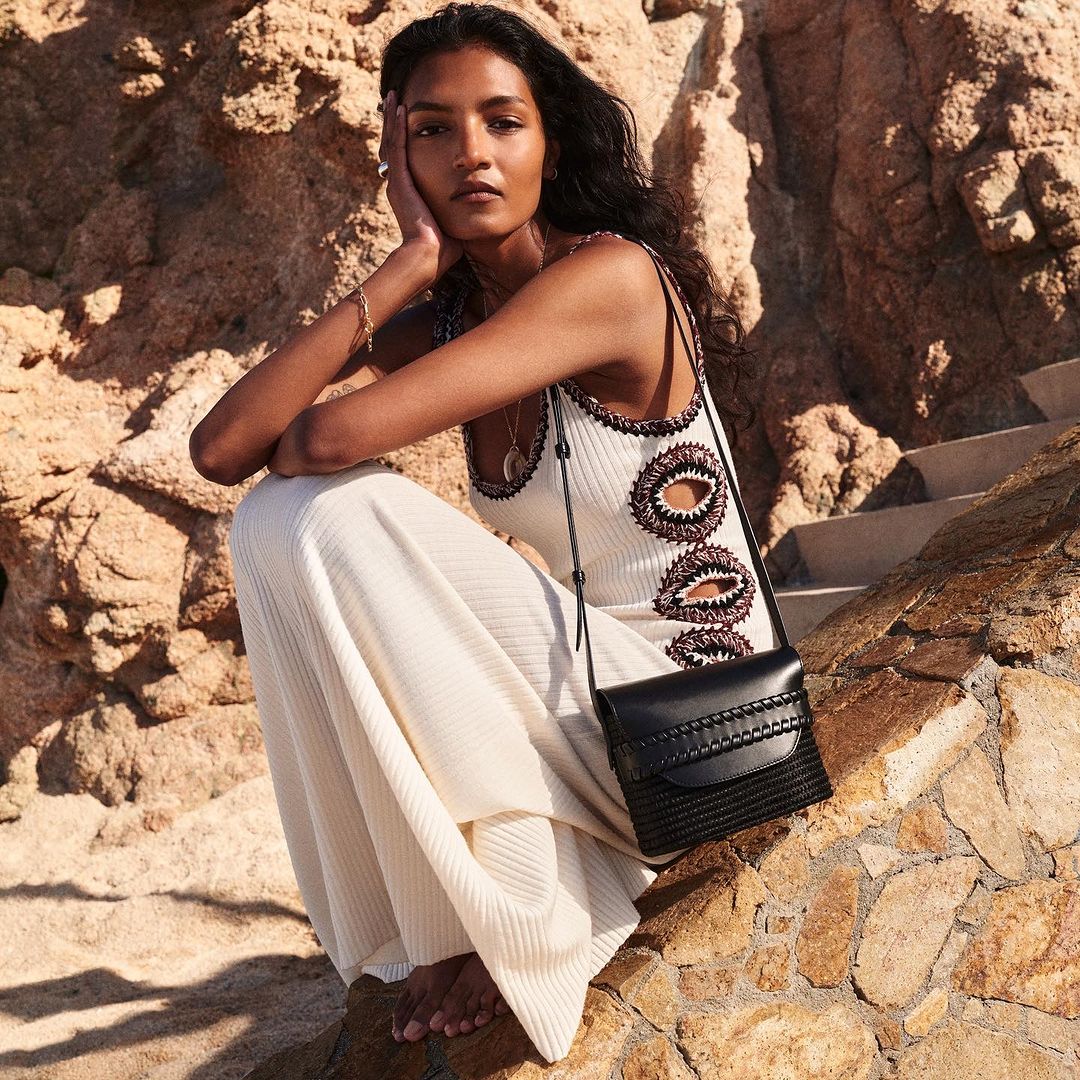 [PHOTO: A bag made by Cesta Collective, the bags are handmade by women in Rwanda, and the finish is made in Italy]
[PHOTO: A bag made by Cesta Collective, the bags are handmade by women in Rwanda, and the finish is made in Italy]
In May 2023, Meghan attended a dinner date with Cameron Diaz, Gwyneth Paltrow, and their spouses, wearing a Cesta bag. Following the event, the bag gained significant attention. Cesta's founders, Erin Ryder and Courtney Weinblatt Fasciano, observed a surge in interest almost immediately.
"We were heading to Mexico for a book shoot," Ryder told The New York Times. "As soon as we landed and connected to the internet, we saw that this previously slow-selling style was completely sold out. We received a flood of 'back in stock' sign-ups. We realized something must have triggered this surge, so Courtney investigated online. We ended up with more sales in one day than ever before."
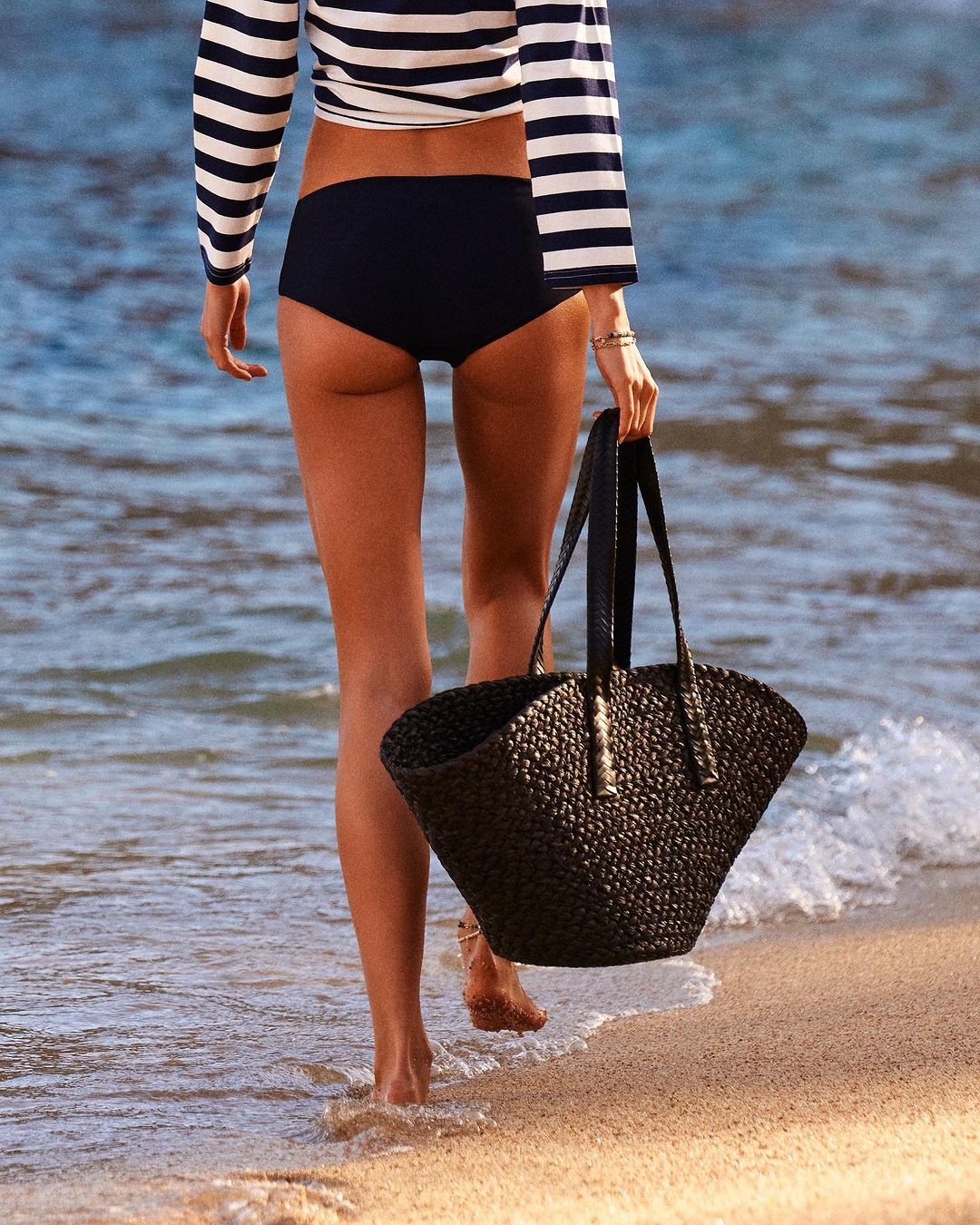 [PHOTO: A bag made by Cesta Collective, the bags are handmade by women in Rwanda, and the finish is made in Italy]
[PHOTO: A bag made by Cesta Collective, the bags are handmade by women in Rwanda, and the finish is made in Italy]
The founders expressed their gratitude by sending Meghan a thank-you note. This led to a budding relationship, and this summer, Meghan agreed to become Cesta's first external investor. While she did not disclose the amount invested or her ownership percentage, Ryder and Fasciano confirmed that Meghan holds a minority stake in the company.
A company dedicated to transforming lives through handcrafted accessories, the brand's handbags are made from organic, vegetable-dyed sisal, not only supporting the local economy but also providing female artisans with consistent, fair-wage opportunities. Each bag takes three to seven days to create, with intricate color-block patterns that highlight the artisans' exceptional skill, raising the price to $750 (Rwf 999,750) and above.
 [PHOTO: A bag made by Cesta Collective, the bags are handmade by women in Rwanda, and the finish is made in Italy]
[PHOTO: A bag made by Cesta Collective, the bags are handmade by women in Rwanda, and the finish is made in Italy]
Cesta Collective's mission is to empower women and drive sustainable income in Rwanda. The brand's partnership with Meghan Markle, a well-known advocate for social and economic empowerment, is a testament to the impact the company is making in the lives of its artisans.
Markle's investment and involvement with Cesta Collective are part of her broader efforts to support ethical and sustainable businesses that prioritize social impact. In recent years, she has invested in and championed various initiatives that align with her values, including a sustainable travel company, a mental health-focused tech platform, and a clean beauty brand.
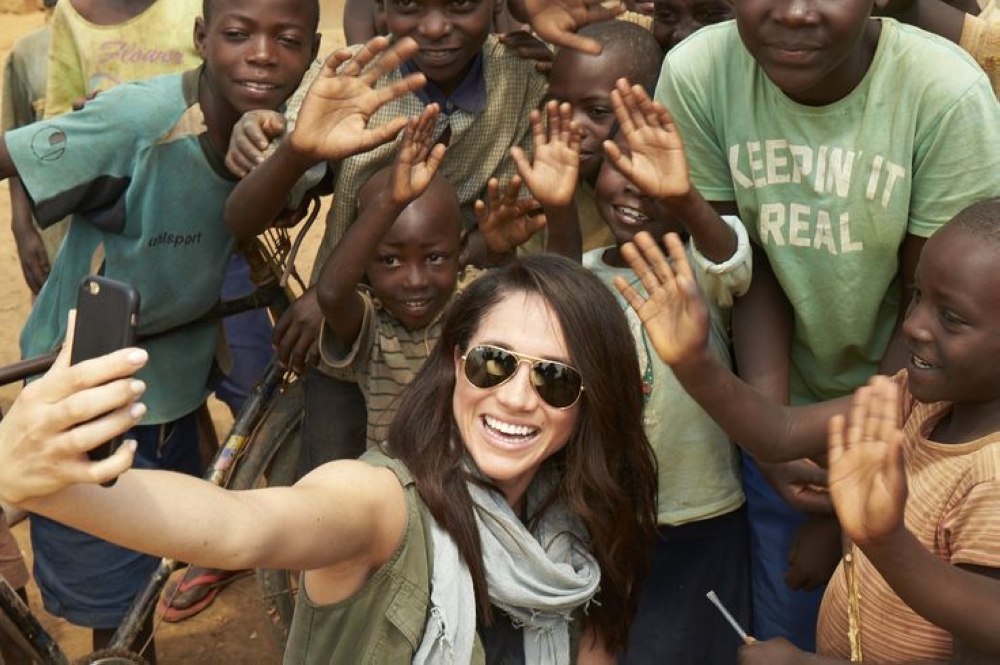 [PHOTO: Meghan Markle takes a selfie with children during her visit to Rwanda]
[PHOTO: Meghan Markle takes a selfie with children during her visit to Rwanda]
"Meghan's investment in Cesta Collective is more than just a financial transaction," said Fasciano. "She genuinely cares about the work we're doing and the lives we're impacting. Her guidance and expertise have been invaluable as we continue to grow the brand and expand our reach."
The partnership with Meghan Markle comes at a pivotal time for Cesta Collective. The brand has experienced significant growth in recent years, with its handwoven bags gaining popularity among fashion-conscious consumers who value craftsmanship and social impact. The investment from Markle is expected to help the company scale its operations, expand its product line, and further solidify its position as a leading ethical luxury brand.
"Meghan's belief in our mission and her commitment to supporting our work has been truly inspiring," said Ryder. "We're excited to continue collaborating with her to create meaningful change and empower even more women in Rwanda."
 [PHOTO: A bag made by Cesta Collective, the bags are handmade by women in Rwanda, and the finish is made in Italy]
[PHOTO: A bag made by Cesta Collective, the bags are handmade by women in Rwanda, and the finish is made in Italy]
As Cesta Collective's profile continues to rise, the brand's impact on the lives of its artisans remains at the forefront of its mission. The company's dedication to sustainable, ethical production and its focus on empowering women have resonated with consumers and industry leaders alike, making it a standout example of how luxury brands can drive positive social change.
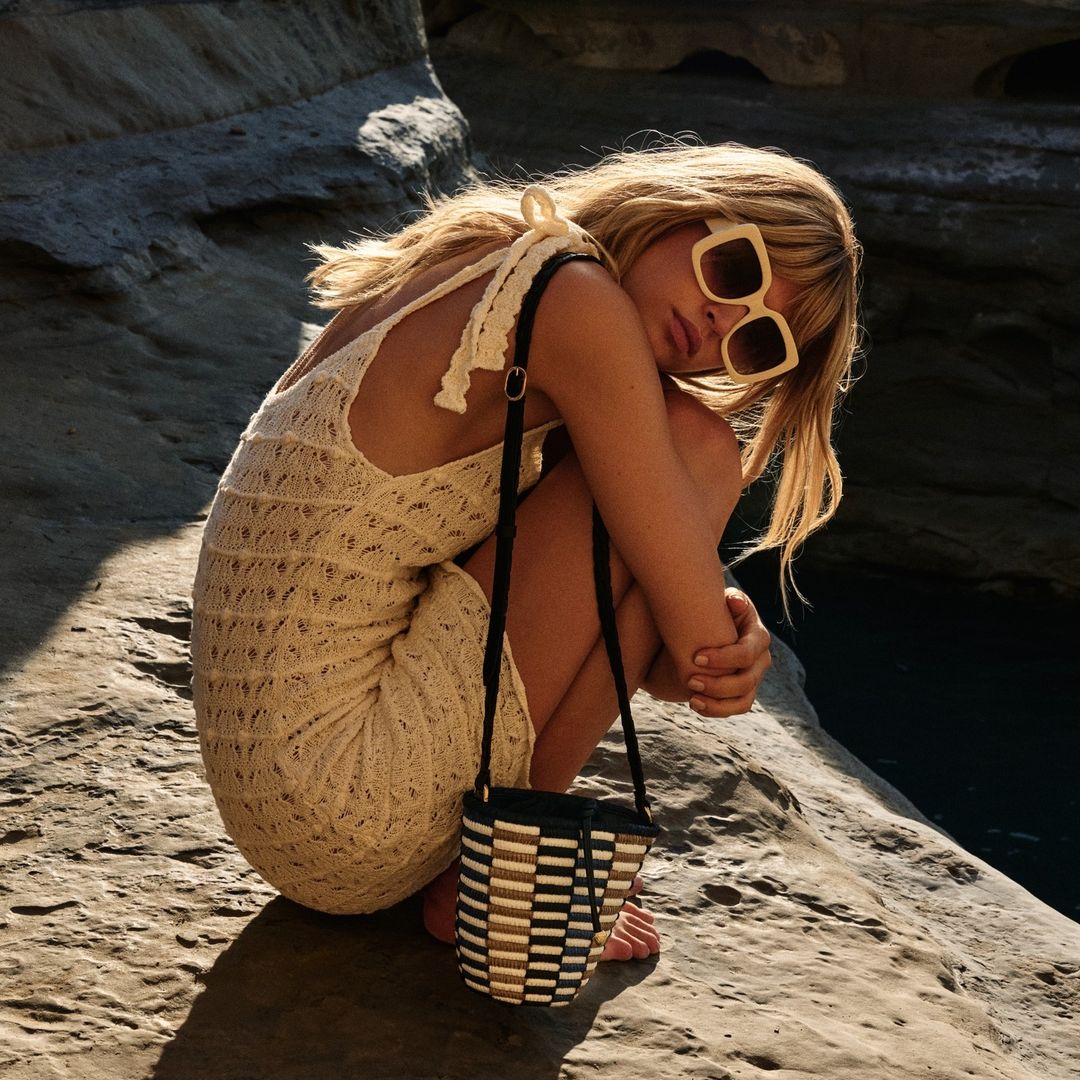 [PHOTO: A bag made by Cesta Collective, the bags are handmade by women in Rwanda, and the finish is made in Italy]
[PHOTO: A bag made by Cesta Collective, the bags are handmade by women in Rwanda, and the finish is made in Italy]
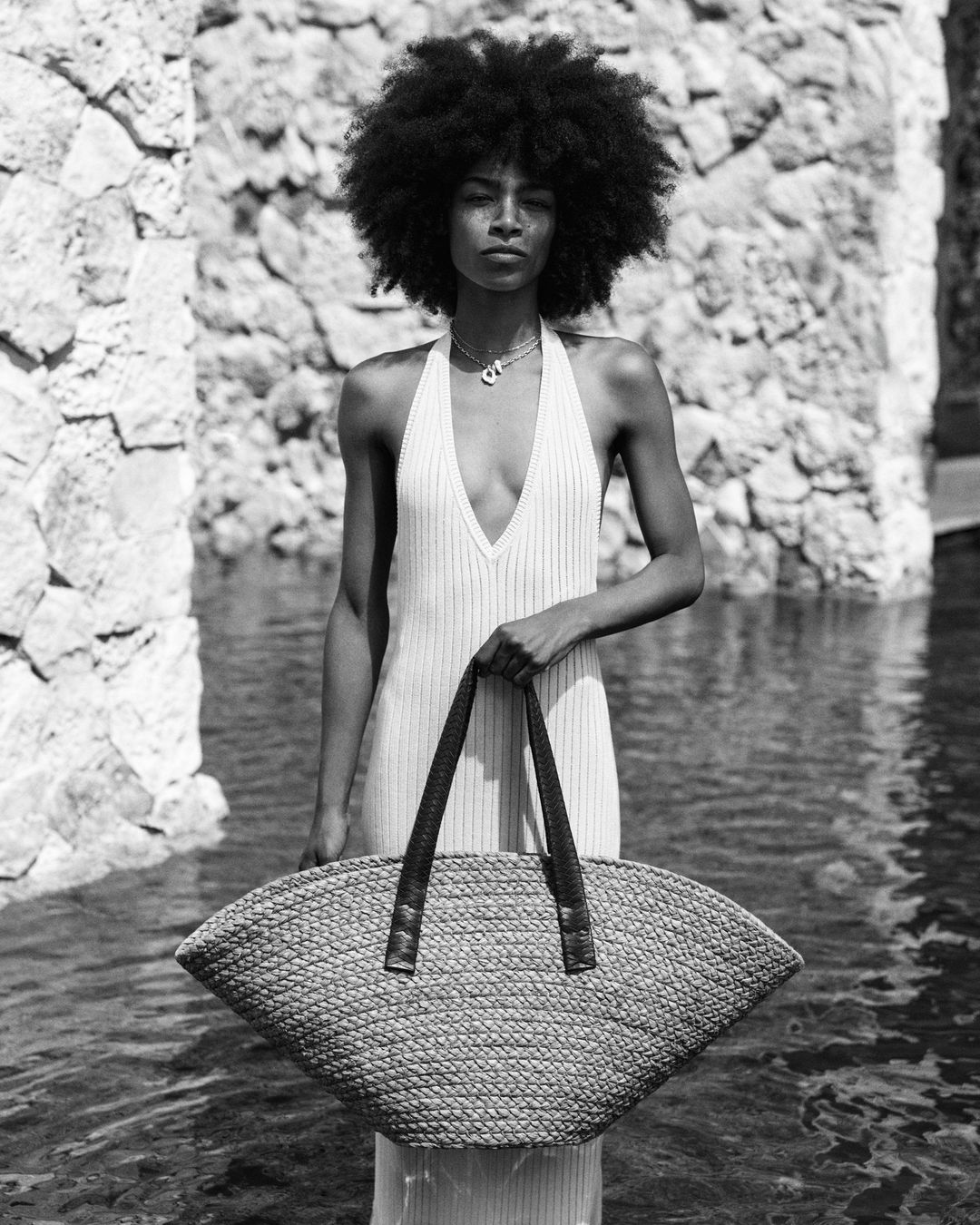 [PHOTO: A bag made by Cesta Collective, the bags are handmade by women in Rwanda, and the finish is made in Italy]
[PHOTO: A bag made by Cesta Collective, the bags are handmade by women in Rwanda, and the finish is made in Italy]
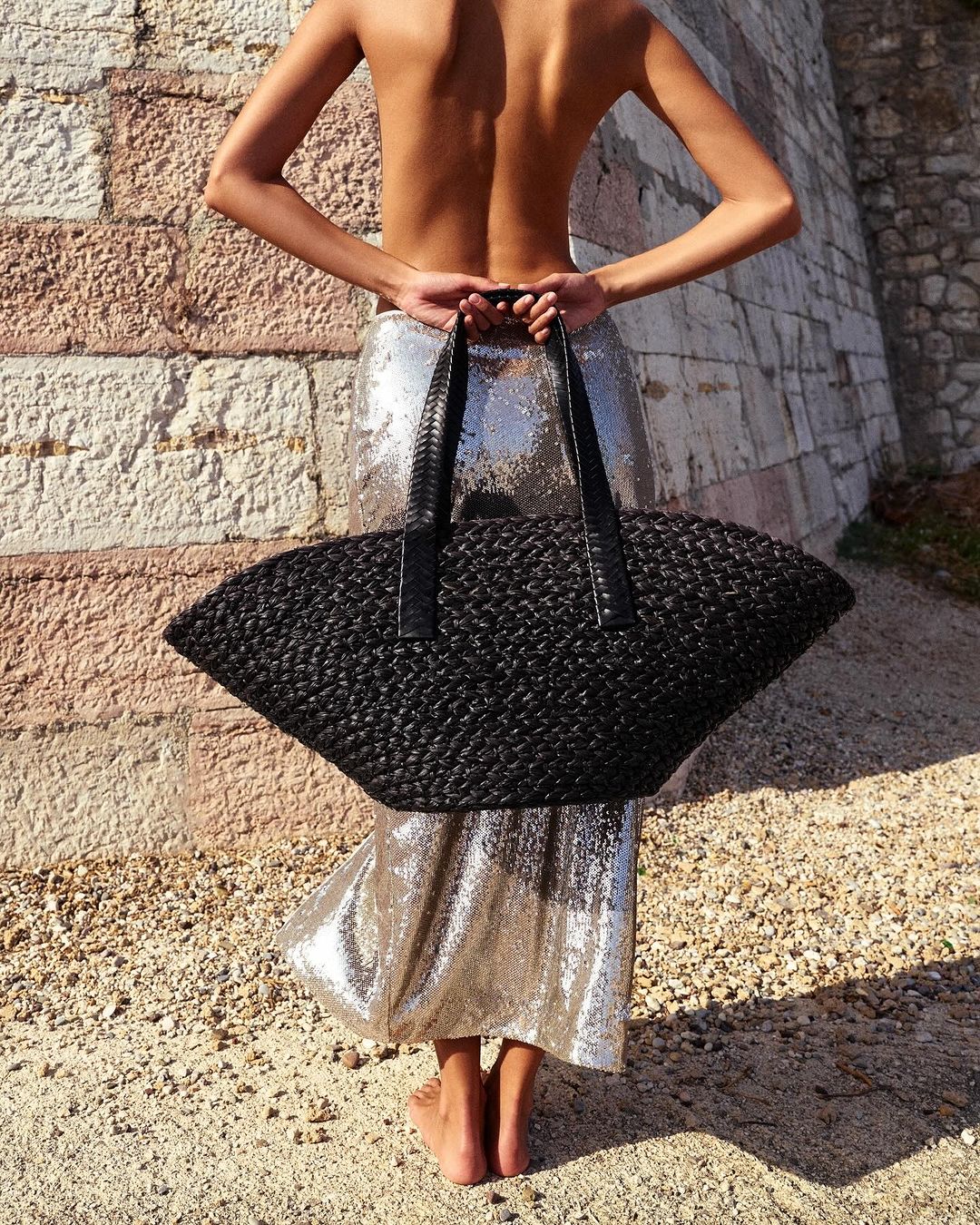 [PHOTO: A bag made by Cesta Collective, the bags are handmade by women in Rwanda, and the finish is made in Italy]
[PHOTO: A bag made by Cesta Collective, the bags are handmade by women in Rwanda, and the finish is made in Italy]
Rwandan Cesta Collective handbag brand Receives Investment from Meghan Markle
Cesta baskets are handwoven of locally sourced, renewable resources, by talented female artisans in Rwanda, Africa who are best in class at their craft. They create consistent, fair-wage opportunities that empower women and drive sustainable income. Each piece is hand-finished in Italy and is a reflection of the brand's thoughtful approach to production.
Meghan Markle has recently garnered attention for her investment in Cesta Collective, a Rwandan handbag brand that empowers female artisans. Known for her keen investment choices and advocacy, Markle has become Cesta Collective's first equity investor and strategic partner, said Courtney Weinblatt Fasciano, who co-founded the luxury bag company with Erin Ryder in 2018.
 [PHOTO: Meghan Markle speaking during the celebrating Women’s Day in Texas at the SXSW Conference March 2024]
[PHOTO: Meghan Markle speaking during the celebrating Women’s Day in Texas at the SXSW Conference March 2024]
Markle's investment is not merely financial. She expressed her admiration for Cesta Collective's ethos. "Courtney and Erin have a really incredible and strategic business. The quality of a brand's products, the supply chain, ethical standards and practices, these are all things that I consider before making an investment," Markle told The New York Times. "With Cesta, I really started to understand how many women's lives were being impacted and uplifted through their work. That was incredibly important to me."
Cesta Collective, which specializes in basket bags that are handwoven by a collective of women in Rwanda and finished in Italy, caught Meghan's eye while she was online shopping. "I spend a lot of time just Googling, looking for brands, when people are online looking for things or reading things, I'm trying to find great new designers, especially in different territories," she said.
 [PHOTO: A bag made by Cesta Collective, the bags are handmade by women in Rwanda, and the finish is made in Italy]
[PHOTO: A bag made by Cesta Collective, the bags are handmade by women in Rwanda, and the finish is made in Italy]
In May 2023, Meghan attended a dinner date with Cameron Diaz, Gwyneth Paltrow, and their spouses, wearing a Cesta bag. Following the event, the bag gained significant attention. Cesta's founders, Erin Ryder and Courtney Weinblatt Fasciano, observed a surge in interest almost immediately.
"We were heading to Mexico for a book shoot," Ryder told The New York Times. "As soon as we landed and connected to the internet, we saw that this previously slow-selling style was completely sold out. We received a flood of 'back in stock' sign-ups. We realized something must have triggered this surge, so Courtney investigated online. We ended up with more sales in one day than ever before."
 [PHOTO: A bag made by Cesta Collective, the bags are handmade by women in Rwanda, and the finish is made in Italy]
[PHOTO: A bag made by Cesta Collective, the bags are handmade by women in Rwanda, and the finish is made in Italy]
The founders expressed their gratitude by sending Meghan a thank-you note. This led to a budding relationship, and this summer, Meghan agreed to become Cesta's first external investor. While she did not disclose the amount invested or her ownership percentage, Ryder and Fasciano confirmed that Meghan holds a minority stake in the company.
A company dedicated to transforming lives through handcrafted accessories, the brand's handbags are made from organic, vegetable-dyed sisal, not only supporting the local economy but also providing female artisans with consistent, fair-wage opportunities. Each bag takes three to seven days to create, with intricate color-block patterns that highlight the artisans' exceptional skill, raising the price to $750 (Rwf 999,750) and above.
 [PHOTO: A bag made by Cesta Collective, the bags are handmade by women in Rwanda, and the finish is made in Italy]
[PHOTO: A bag made by Cesta Collective, the bags are handmade by women in Rwanda, and the finish is made in Italy]
Cesta Collective's mission is to empower women and drive sustainable income in Rwanda. The brand's partnership with Meghan Markle, a well-known advocate for social and economic empowerment, is a testament to the impact the company is making in the lives of its artisans.
Markle's investment and involvement with Cesta Collective are part of her broader efforts to support ethical and sustainable businesses that prioritize social impact. In recent years, she has invested in and championed various initiatives that align with her values, including a sustainable travel company, a mental health-focused tech platform, and a clean beauty brand.
 [PHOTO: Meghan Markle takes a selfie with children during her visit to Rwanda]
[PHOTO: Meghan Markle takes a selfie with children during her visit to Rwanda]
"Meghan's investment in Cesta Collective is more than just a financial transaction," said Fasciano. "She genuinely cares about the work we're doing and the lives we're impacting. Her guidance and expertise have been invaluable as we continue to grow the brand and expand our reach."
The partnership with Meghan Markle comes at a pivotal time for Cesta Collective. The brand has experienced significant growth in recent years, with its handwoven bags gaining popularity among fashion-conscious consumers who value craftsmanship and social impact. The investment from Markle is expected to help the company scale its operations, expand its product line, and further solidify its position as a leading ethical luxury brand.
"Meghan's belief in our mission and her commitment to supporting our work has been truly inspiring," said Ryder. "We're excited to continue collaborating with her to create meaningful change and empower even more women in Rwanda."
 [PHOTO: A bag made by Cesta Collective, the bags are handmade by women in Rwanda, and the finish is made in Italy]
[PHOTO: A bag made by Cesta Collective, the bags are handmade by women in Rwanda, and the finish is made in Italy]
As Cesta Collective's profile continues to rise, the brand's impact on the lives of its artisans remains at the forefront of its mission. The company's dedication to sustainable, ethical production and its focus on empowering women have resonated with consumers and industry leaders alike, making it a standout example of how luxury brands can drive positive social change.
 [PHOTO: A bag made by Cesta Collective, the bags are handmade by women in Rwanda, and the finish is made in Italy]
[PHOTO: A bag made by Cesta Collective, the bags are handmade by women in Rwanda, and the finish is made in Italy]
 [PHOTO: A bag made by Cesta Collective, the bags are handmade by women in Rwanda, and the finish is made in Italy]
[PHOTO: A bag made by Cesta Collective, the bags are handmade by women in Rwanda, and the finish is made in Italy]
 [PHOTO: A bag made by Cesta Collective, the bags are handmade by women in Rwanda, and the finish is made in Ital]
[PHOTO: A bag made by Cesta Collective, the bags are handmade by women in Rwanda, and the finish is made in Ital]
Moshions in Italy: A Journey of Self-Discovery
The INZOZI FASHION EXPERIENCE 2024, organized by Moshions, promises to be a landmark event in the fashion world. Turahirwa Moses, CEO and Creative Designer of the renowned Rwanda-based brand, has recently made cryptic statements that have left many intrigued and speculating about their meaning.
This air of mystery follows a recent incident where Moshions claimed their brand had been compromised, leading to the temporary shutdown of their website and online systems. In an official announcement, the company stated, "We will be back soon on our e-commerce. Our sincere apologies to our online shopping family. MOSHIONS had to pause and reconstruct our online shopping experience due to unexpected high shopping traffic and fraud with fake copies of our styles from the website."
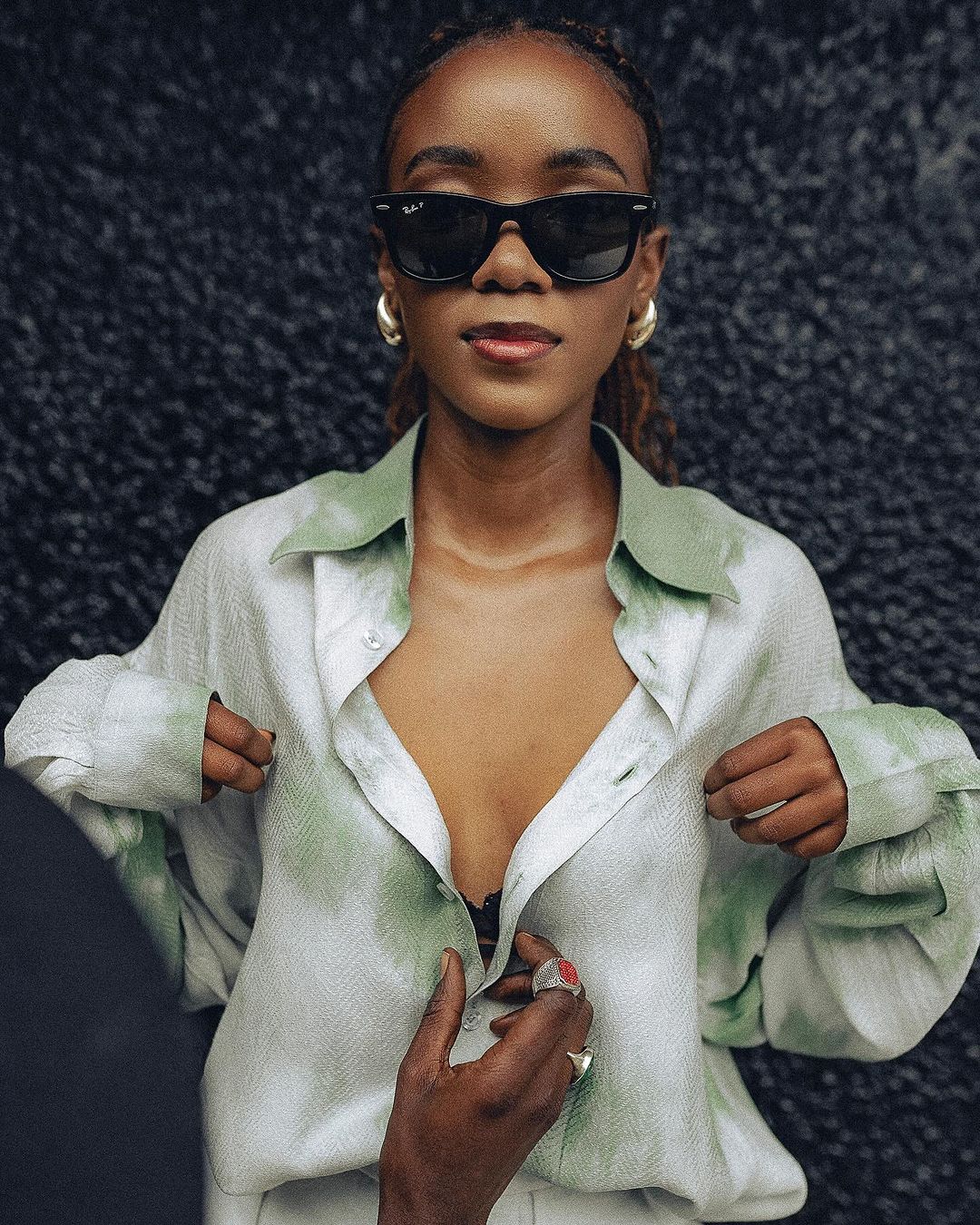 [PHOTO: New collection for the Inzozi Fashion Experience 2024, in Italy by Moshions]
[PHOTO: New collection for the Inzozi Fashion Experience 2024, in Italy by Moshions]
While some observers have expressed confusion over Turahirwa's recent 24-second video posted on the brand's Instagram account, those familiar with Rwandan traditional communication understand the nuanced use of proverbs in conversation. These proverbs often carry deeper meanings, sometimes pointing fingers, speaking indirectly about others, speculating about the future, or serving as subtle reminders or warnings.
The video in question features an actress gracefully blending sexy moves with elements of traditional Rwandan dance. Set against a dark background with wisps of white smoke, the visuals are accompanied by a poetic voiceover: "Then I dreamt of a journey of self-discovery. Many exploring different styles and adopting multiple trends. Who's style is real? The truth lays behind Moshions dream. Dress in your future roots with pride and celebrate your authenticity."
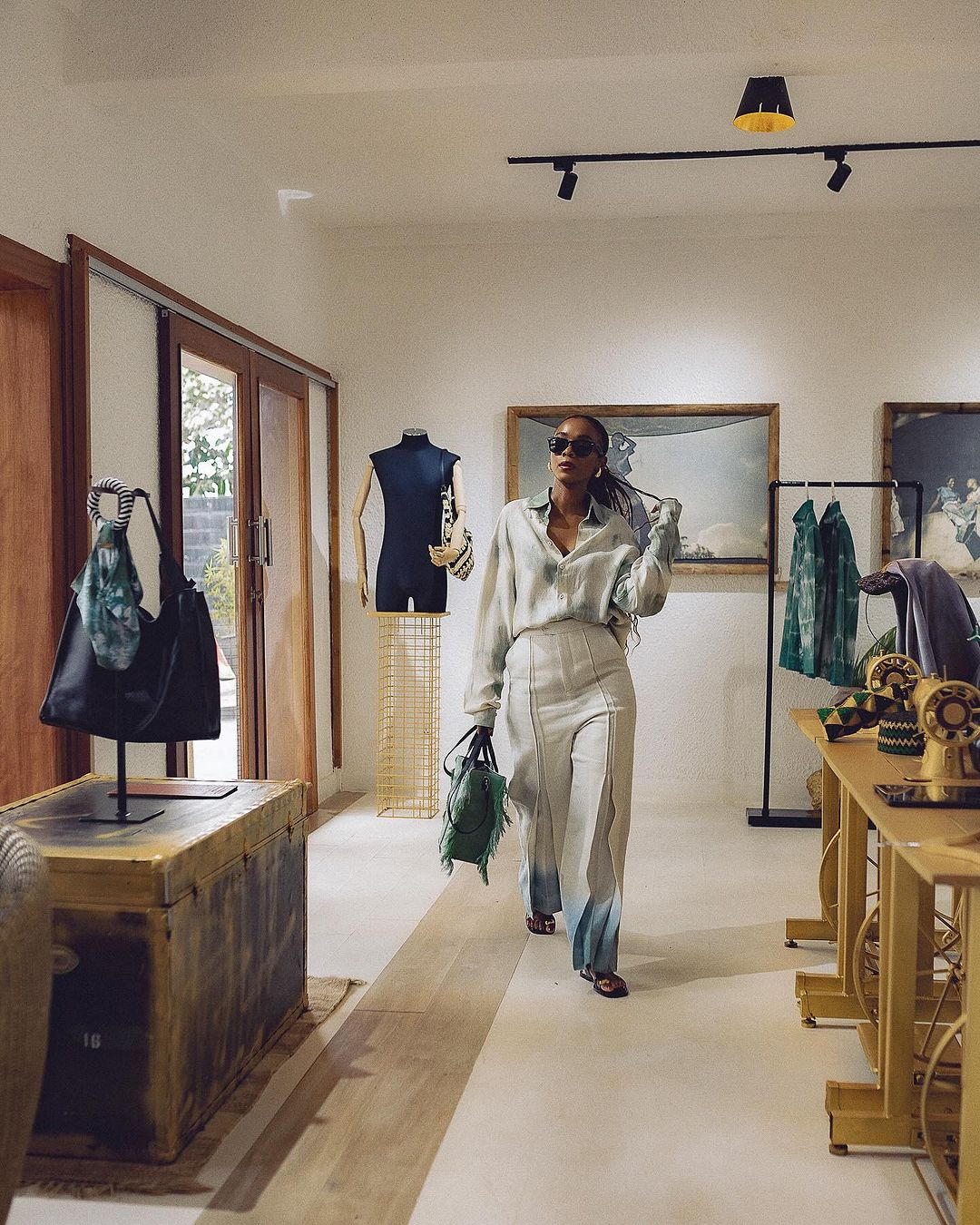 [PHOTO: New collection for the Inzozi Fashion Experience 2024, in Italy by Moshions]
[PHOTO: New collection for the Inzozi Fashion Experience 2024, in Italy by Moshions]
ALSO READ: Moshions Claims Counterfeit Behind Their Brand in Rwanda: Who's to Blame?
This artistic piece, directed by Francesco Tavanti, a freelance Executive Producer and Director based in Italy, showcases the brand's commitment to blending tradition with modernity. The production, a collaboration between Kwanda Hub by Moshions and model Kaya Byinshii, embodies the brand's ethos of cultural pride and authenticity.
Moshions' recent statements and artistic endeavors seem to be addressing the broader context of fashion and identity. In an industry often criticized for appropriation and lack of originality, Moshions appears to be advocating for a return to authentic, culturally rooted styles. The brand challenges both designers and consumers to question the authenticity of current trends and to embrace their cultural heritage in fashion choices.
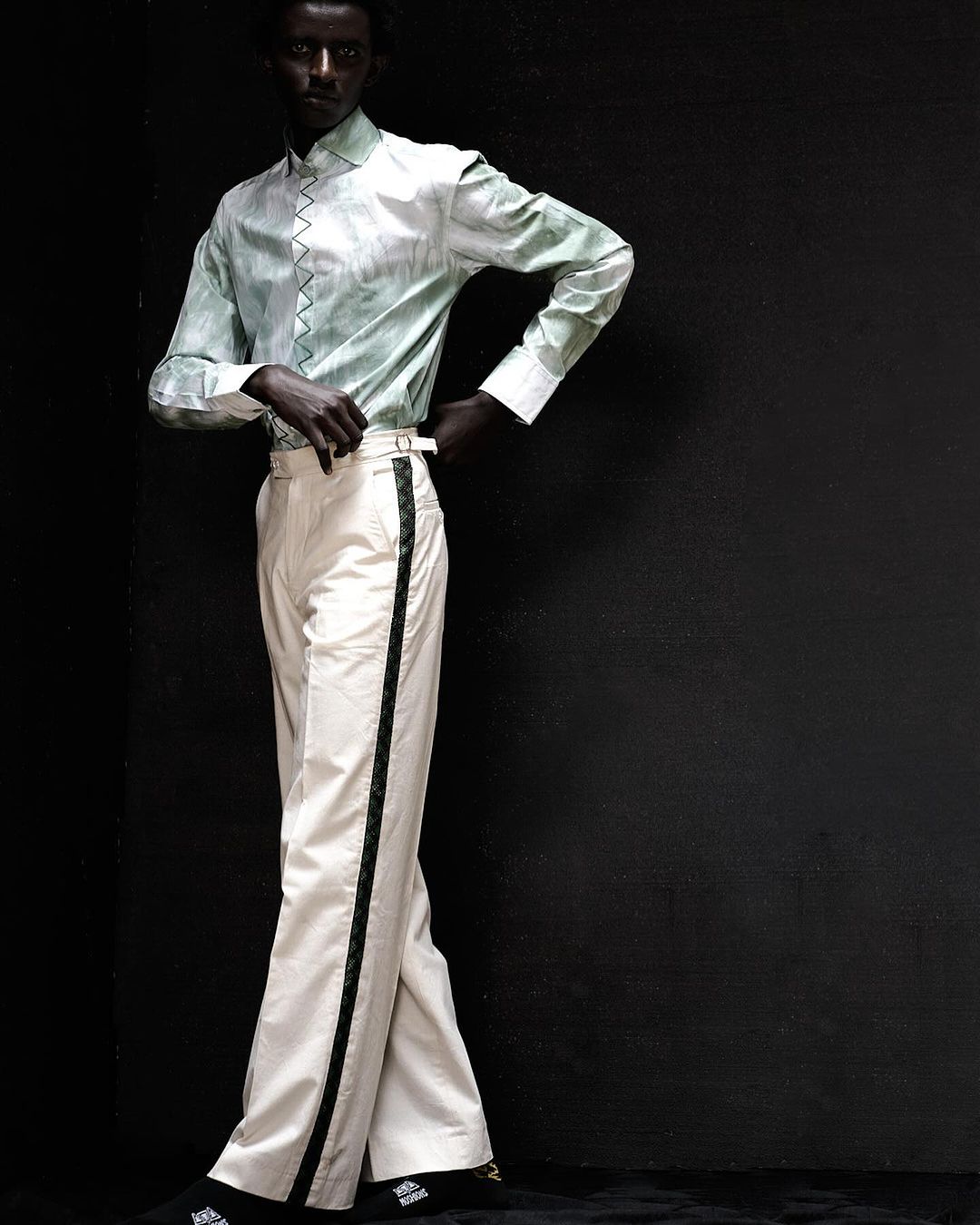 [PHOTO: New collection for the Inzozi Fashion Experience 2024, in Italy by Moshions]
[PHOTO: New collection for the Inzozi Fashion Experience 2024, in Italy by Moshions]
The phrase "Dress in your future roots with pride" encapsulates Moshions' vision – a fusion of traditional elements with forward-thinking design. This philosophy not only sets Moshions apart in the fashion landscape but also resonates with a growing global desire for clothing that tells a story and connects wearers to their heritage.
As the fashion world eagerly anticipates the INZOZI FASHION EXPERIENCE 2024, Moshions continues to intrigue and inspire. Through their enigmatic communications and thought-provoking artistry, they're not just creating clothing; they're sparking a conversation about identity, authenticity, and the future of fashion.
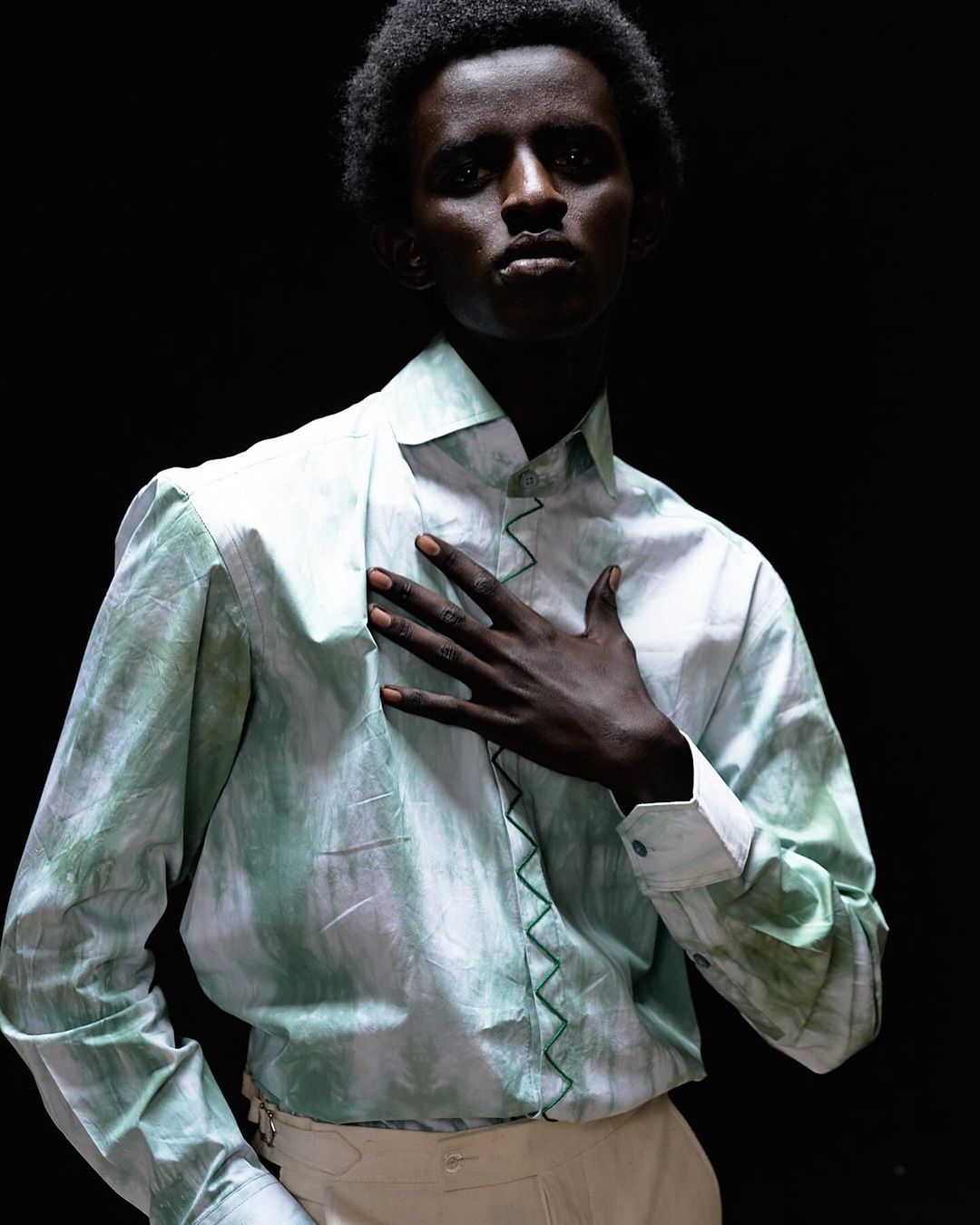 [PHOTO: New collection for the Inzozi Fashion Experience 2024, in Italy by Moshions]
[PHOTO: New collection for the Inzozi Fashion Experience 2024, in Italy by Moshions]
The journey of self-discovery that Moshions invites us on is more than a marketing strategy – it's a call to reflection. In a world of fast fashion and fleeting trends, Moshions challenges us to pause and consider: What is our authentic style? How can we honor our roots while moving forward? As the brand prepares to showcase its vision in Italy, the fashion world watches, ready to be inspired by a narrative that goes beyond fabric and stitches to touch the very essence of who we are and who we aspire to be.
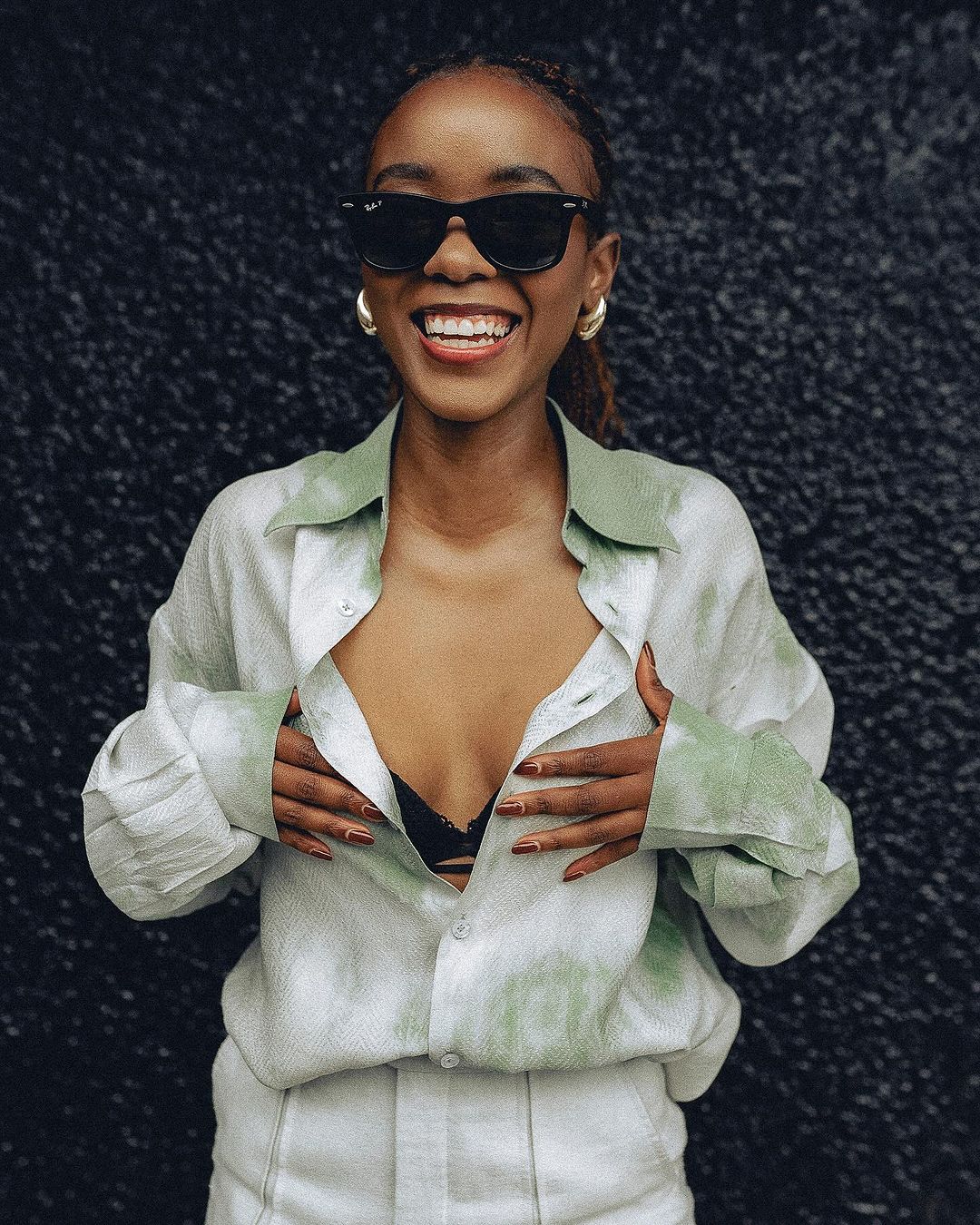 [PHOTO: New collection for the Inzozi Fashion Experience 2024, in Italy by Moshions]
[PHOTO: New collection for the Inzozi Fashion Experience 2024, in Italy by Moshions]
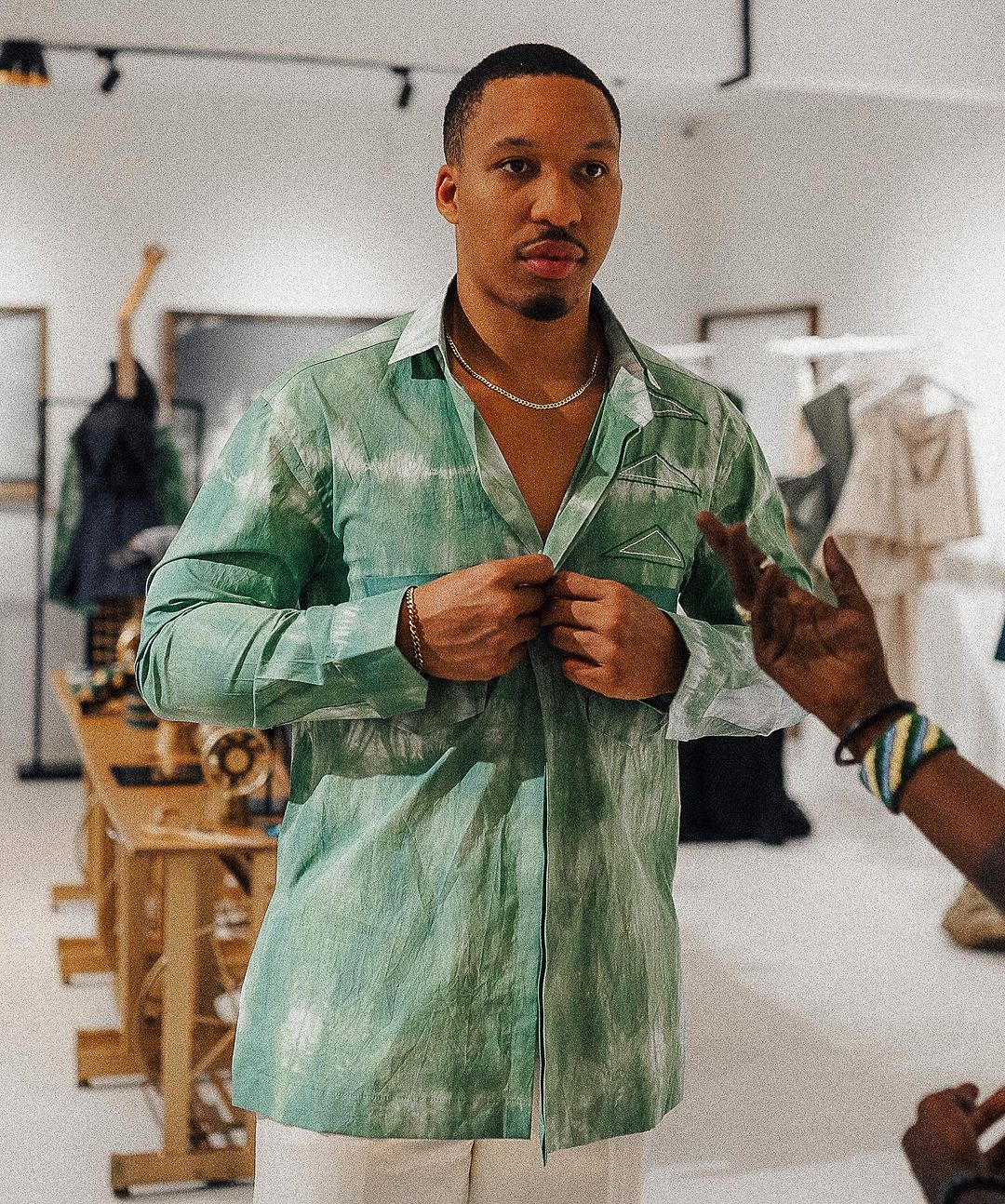 [PHOTO: New collection for the Inzozi Fashion Experience 2024, in Italy by Moshions]
[PHOTO: New collection for the Inzozi Fashion Experience 2024, in Italy by Moshions]
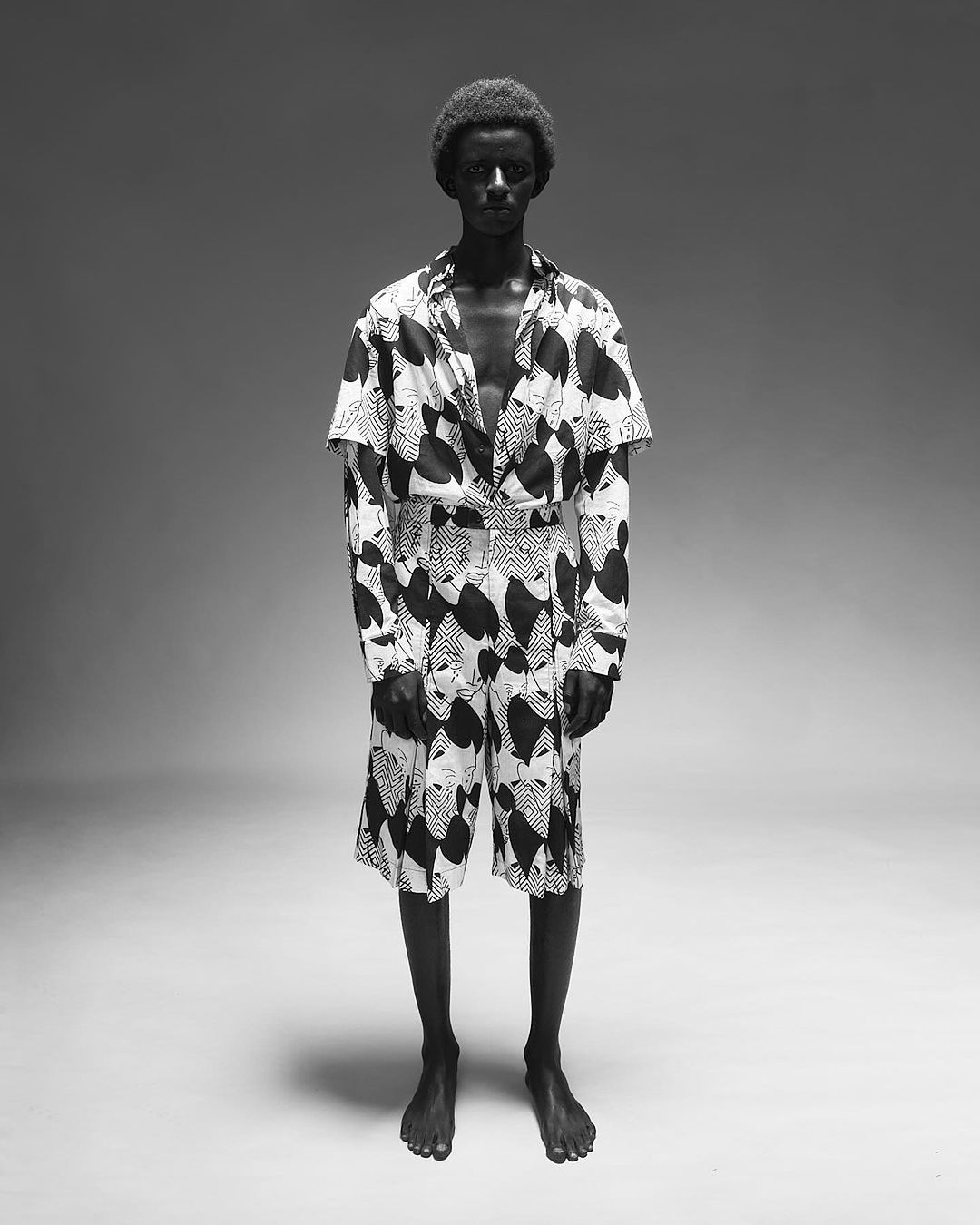 [PHOTO: New collection for the Inzozi Fashion Experience 2024, in Italy by Moshions]
[PHOTO: New collection for the Inzozi Fashion Experience 2024, in Italy by Moshions]
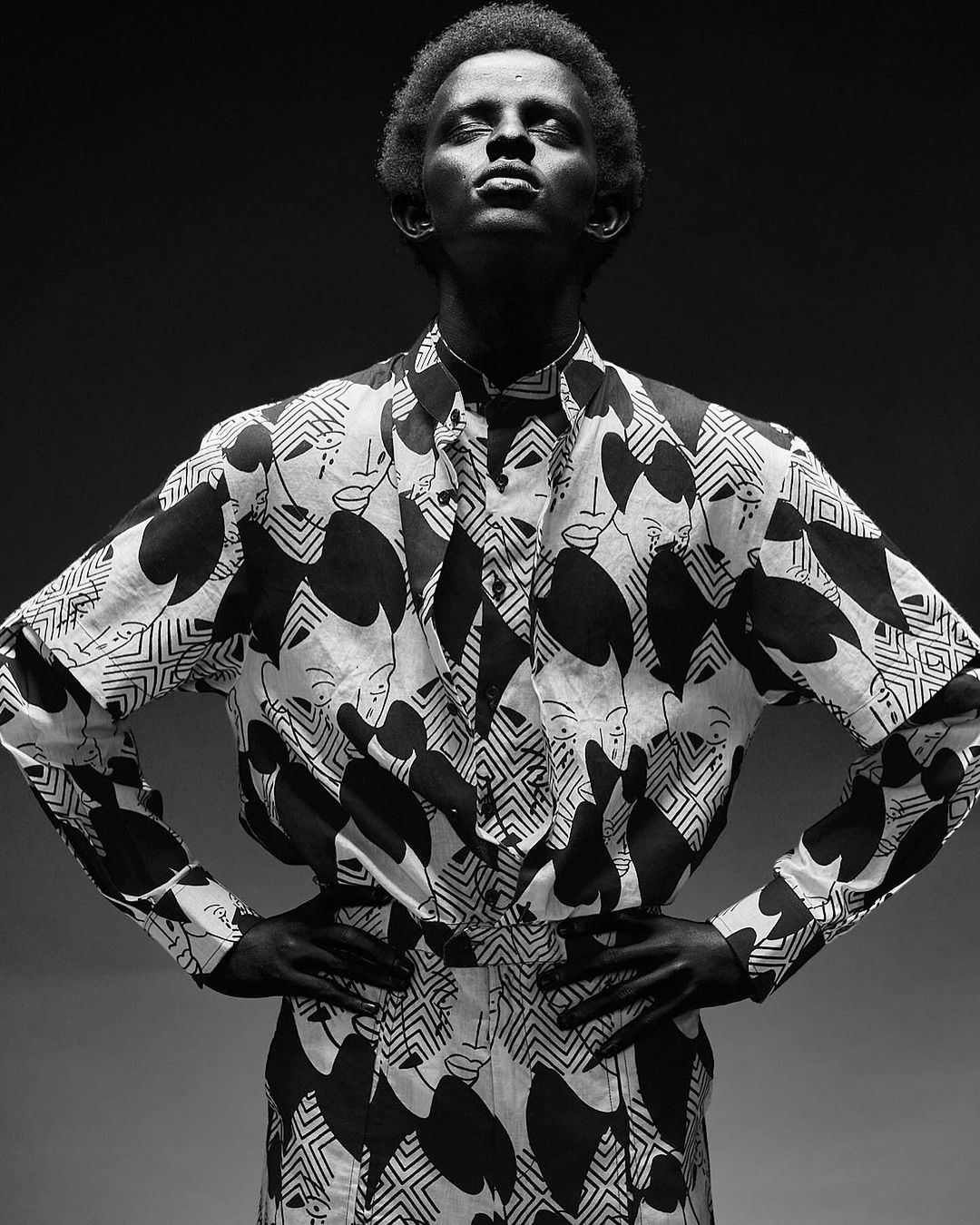 [PHOTO: New collection for the Inzozi Fashion Experience 2024, in Italy by Moshions]
[PHOTO: New collection for the Inzozi Fashion Experience 2024, in Italy by Moshions]
Who Will Win for the Miss, Mrs., and Mr. Heritage International Kenya 2024?
Two weeks ago was a busy period for the organizers of Miss, Mrs., and Mr. International Kenya 2024. Their main focus was finalizing the list of competitors, which was released six days ago. The finalists were selected from most counties across the country, resulting in 16 female and 9 male finalists.
"I encourage all Kenyans to come out and support our contestants, and I invite you to wear outfits made in Kenya. Together, let’s celebrate our diverse cultures through the attire we choose for the event. Preparations for the event are underway, and most details are in place. You can purchase tickets at Pamoja Voice Africa" says Immaculate Onyoni, Founder and Director of the Miss and Mrs. Heritage International Kenya.
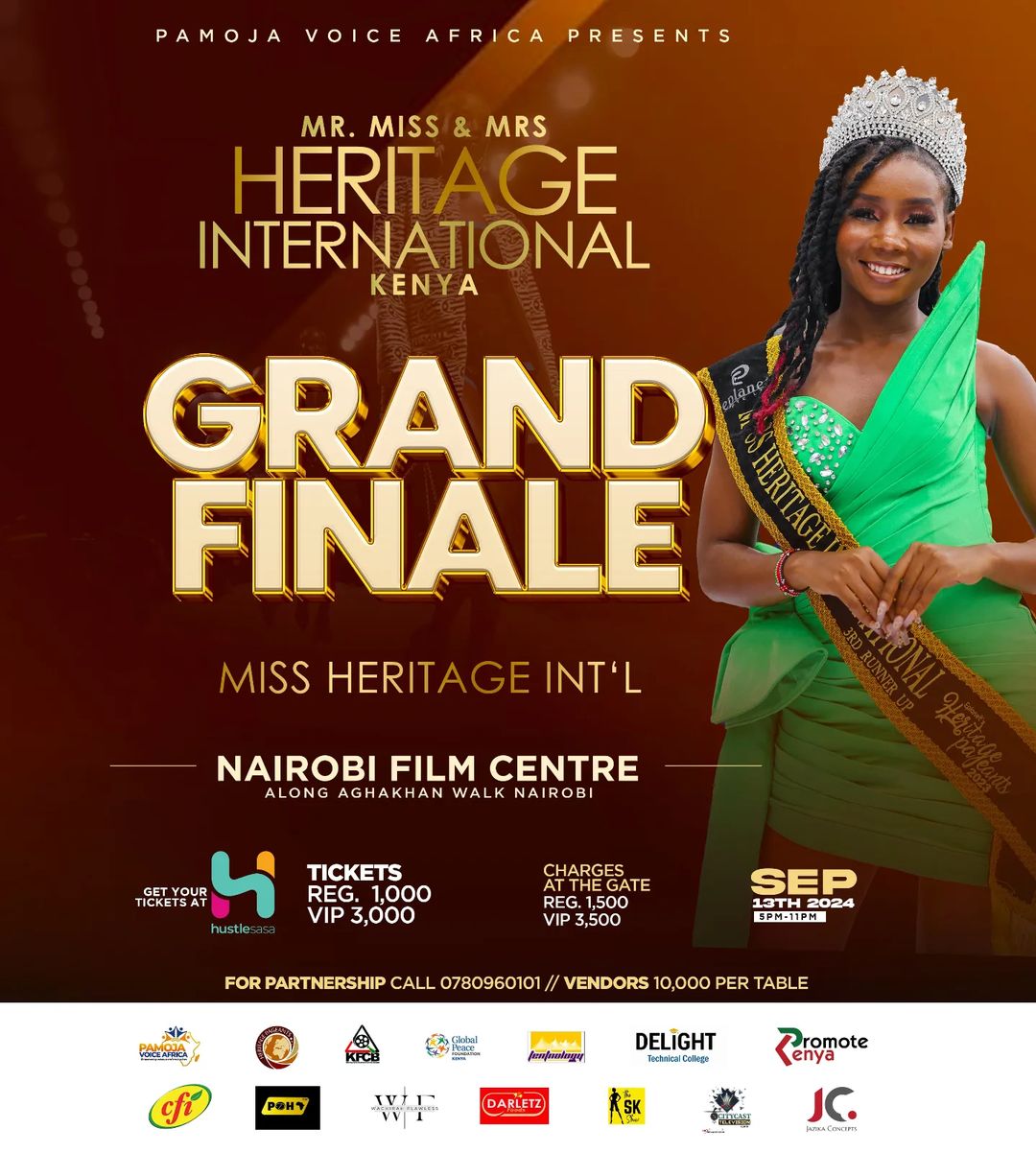 [POSTER: Miss, Mrs., and Mr. Heritage International Kenya is scheduled on 13th September at Nairobi Film Centre]
[POSTER: Miss, Mrs., and Mr. Heritage International Kenya is scheduled on 13th September at Nairobi Film Centre]
According to the organizers, everything is set for the final event, and all Kenyans are welcome. "We have finalists who are ready to compete for crowns. Everyone wants to win, but they know there can only be one winner in each category. We will crown Miss, Mrs., and Mr., with three crowns in total," Immaculate explains. "Each contestant will be competing, and of course, fashion matters in beauty pageants here in Kenya. We have asked every finalist to consider styles that will promote culture as well as made-in-Kenya fashion. We're also asking the audience to join us in promoting culture and Kenyan heritage through their attire."
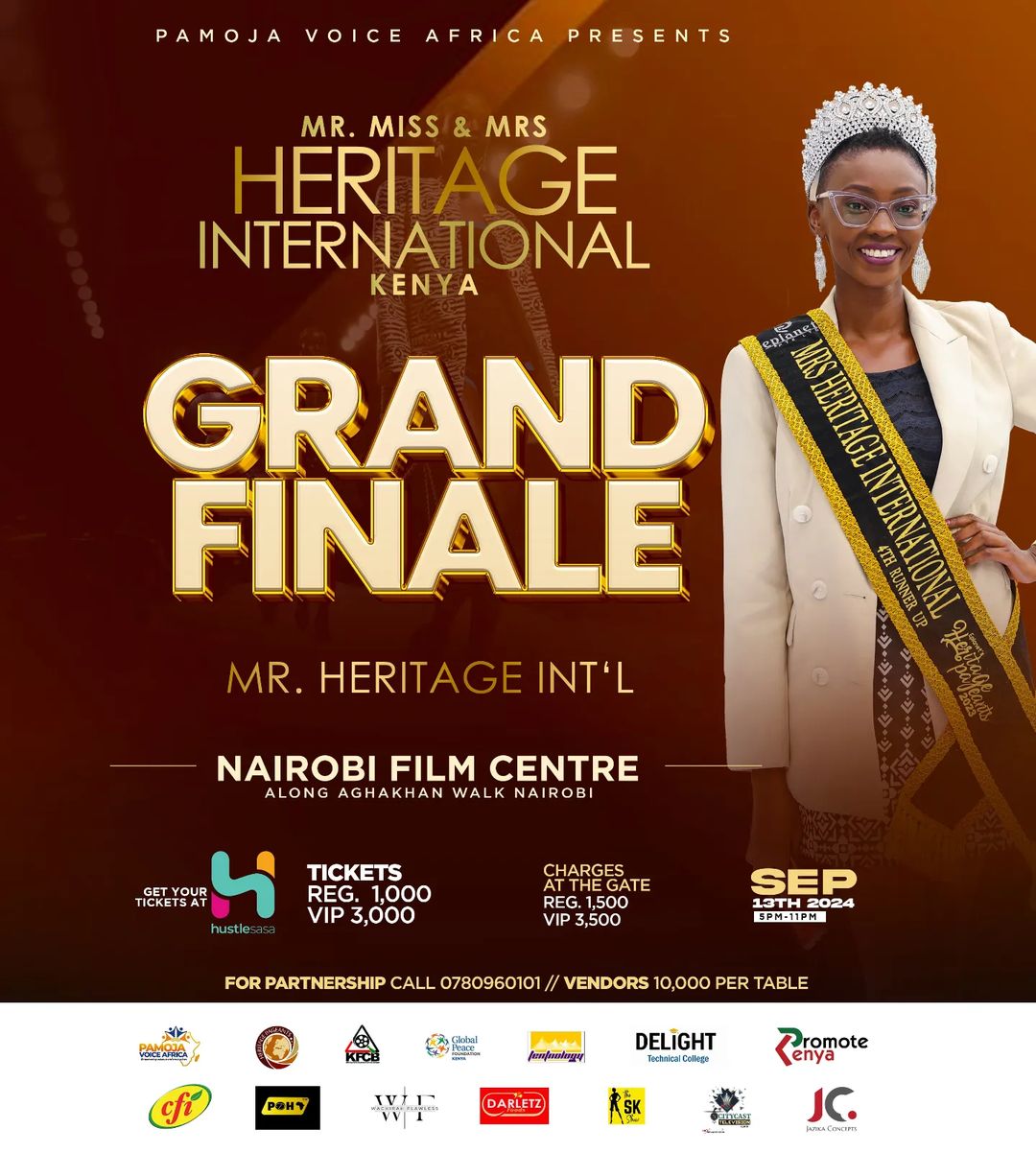 [POSTER: Miss, Mrs., and Mr. Heritage International Kenya is scheduled on 13th September at Nairobi Film Centre]
[POSTER: Miss, Mrs., and Mr. Heritage International Kenya is scheduled on 13th September at Nairobi Film Centre]
Miss, Mrs., and Mr. International Kenya aims to promote youth empowerment through this annual beauty pageant competition. The platform helps winners reach broader networks to promote their projects. "The winners represent our country in international competitions. It's crucial to train them to be unique, proudly Kenyan, and able to present their country on the international stage," Immaculate adds.
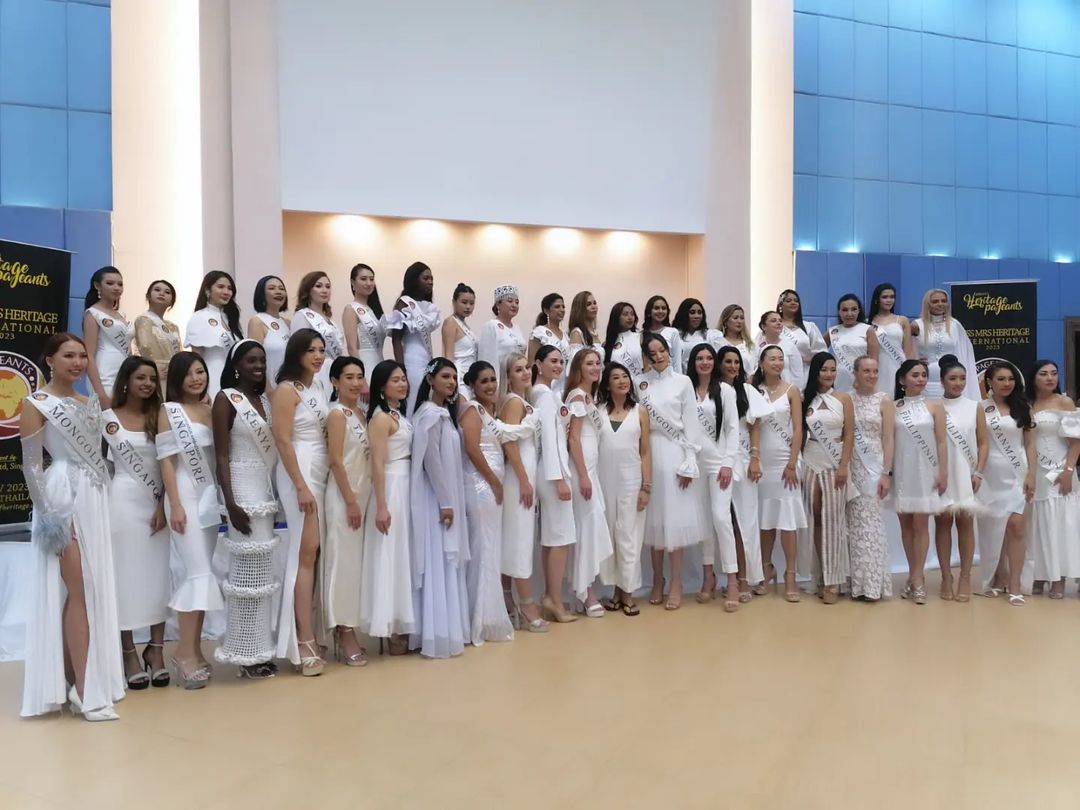 [PHOTO: Kenyans represented and won awards in Thailand at the Miss and Mrs. Heritage International 2023]
[PHOTO: Kenyans represented and won awards in Thailand at the Miss and Mrs. Heritage International 2023]
The main objectives of the competition are to promote culture, heritage, environment, and peace. Applicants must be creative in addressing these topics to win.
Natali Otieno, a 22-year-old finalist from Nairobi County, is passionate about literature, dance, swimming, and spending time with children. "Engaging in both pageantry and high fashion, I embody a spectrum of interests reflective of my dynamic personality," Natali says. "My decision to compete for the Miss Heritage International Kenya 2024 title is deeply rooted in my profound connections to cultural and ancestral heritage."
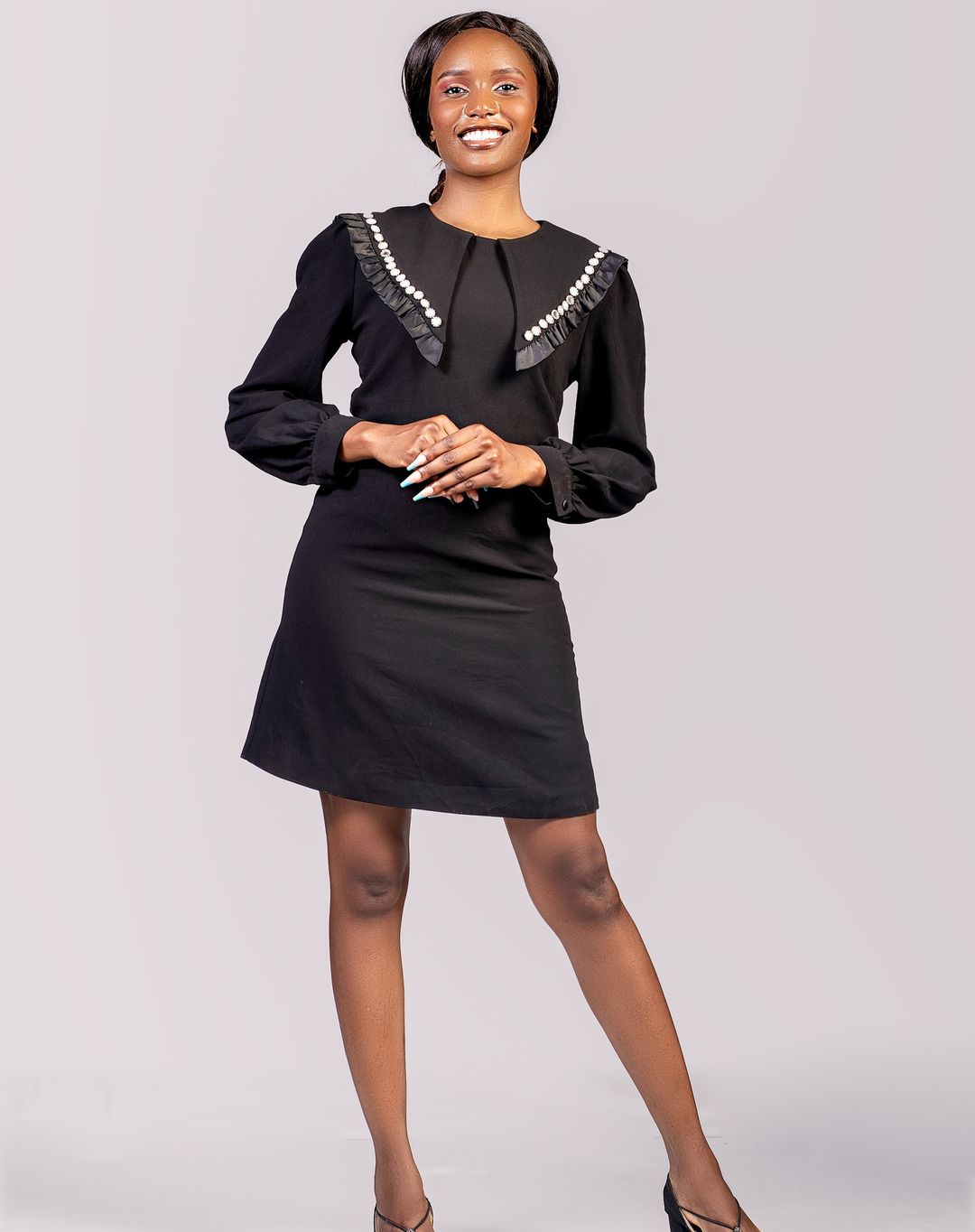 [PHOTO: Natali Otieno is among the finalists and she is hoping to win the Miss Heritage International Kenya 2024]
[PHOTO: Natali Otieno is among the finalists and she is hoping to win the Miss Heritage International Kenya 2024]
Born to a Kenyan Christian father and a Tanzanian Muslim mother, Natali personifies the harmonious amalgamation of identities, symbolizing unity and acceptance. "I'm confident I can win this. Through my participation in Miss Heritage, I aim to amplify my voice in celebrating the rich tapestry of cultural diversity and intergenerational heritage," she explains. Natali aspires to become a Miss Heritage International ambassador, envisioning herself as a catalyst for change dedicated to transcending cultural barriers and fostering mutual understanding and unity.
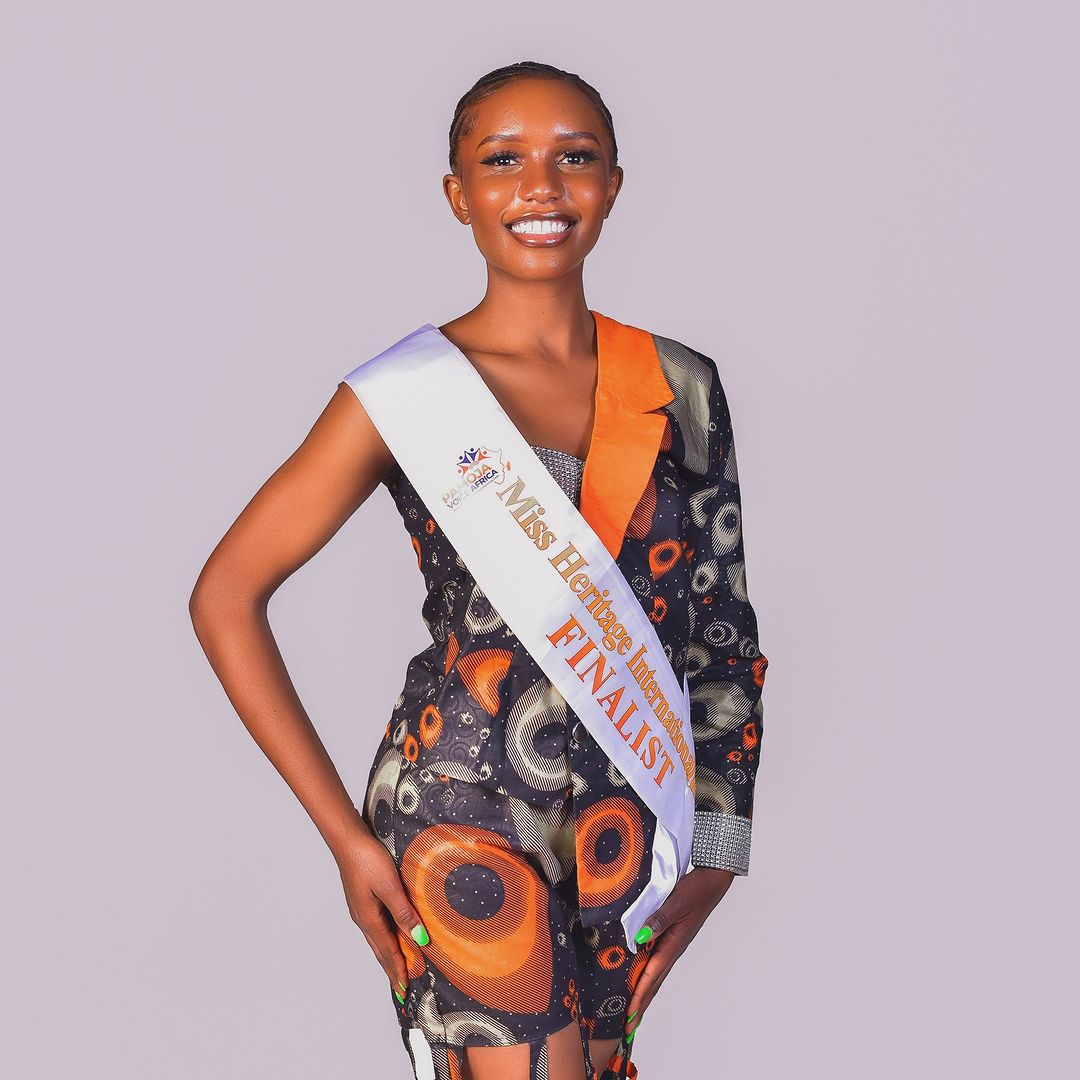 [PHOTO: Natali Otieno is among the finalists and she is hoping to win the Miss Heritage International Kenya 2024]
[PHOTO: Natali Otieno is among the finalists and she is hoping to win the Miss Heritage International Kenya 2024]
Warren Peter, a 21-year-old contestant representing Nairobi County and currently holding the Mr. Nairobi Crown, is another hopeful. "I'm deeply entrenched in a myriad of passions, from strumming melodies on the guitar and singing to the intricate artistry of modeling, fashion styling, and serving in my church community," he says. Warren is a versatile model who seamlessly navigates pageantry, high fashion, and commercial ventures. He finds inspiration in the rich tapestry of experiences that modeling has provided him in recent years. "The title of Mr. Heritage International Kenya bears immense honor and responsibility. Beyond the glitz and glamour, it beckons me to advocate for issues close to my heart such as gender-based violence, femicide, and the plight of the boy child," Warren explains.
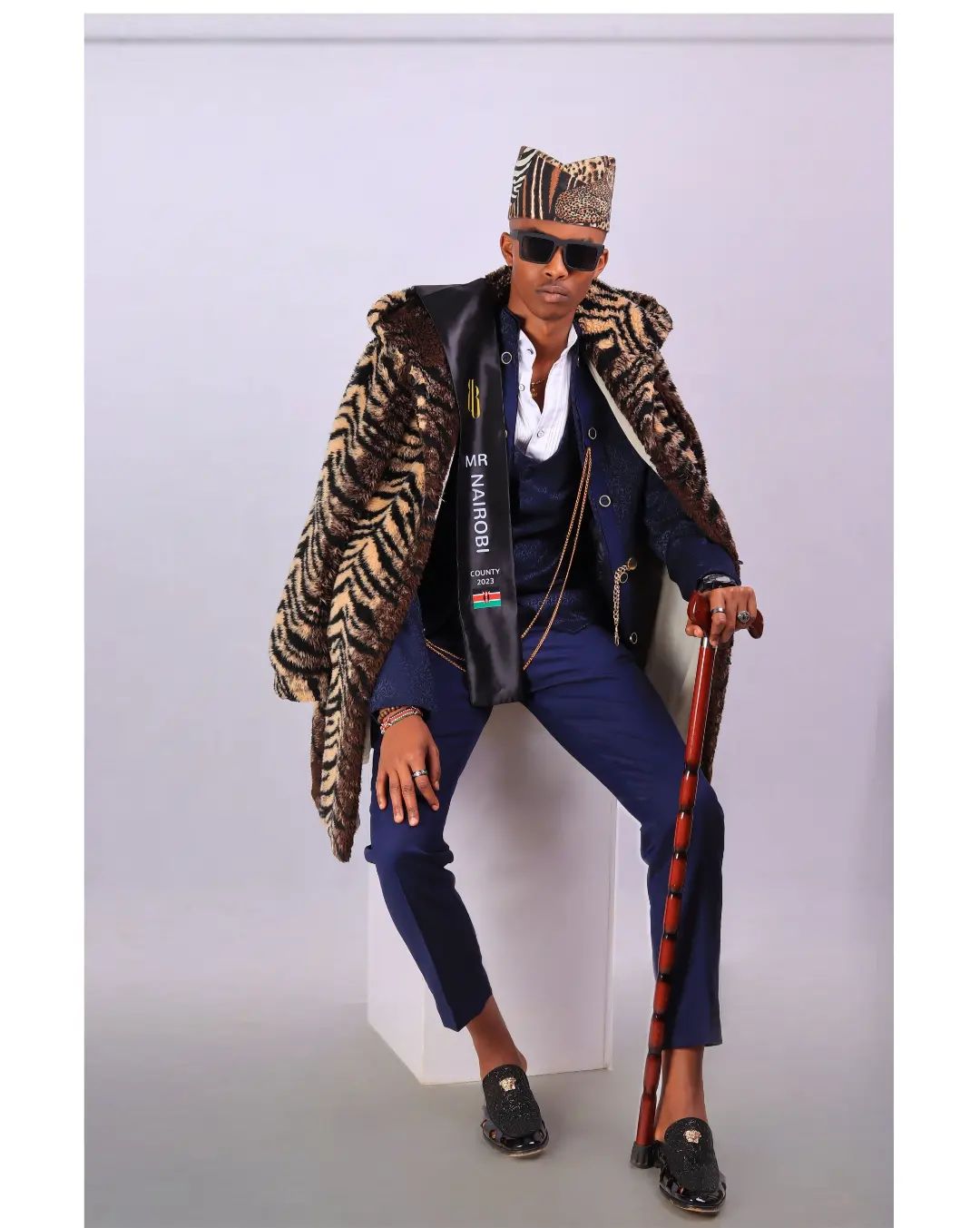 [PHOTO: Warren Peter, who is among the finalists of the Mr. Heritage International Kenya 2024, He is also holding Mr. Nairobi's crown]
[PHOTO: Warren Peter, who is among the finalists of the Mr. Heritage International Kenya 2024, He is also holding Mr. Nairobi's crown]
Nicole Otieno, a 21-year-old finalist from Kitengela, enjoys reading, writing, and exploring culinary arts. "I thrive on pushing my limits and embrace the belief that this opportunity will allow me to delve deeper into my love for modeling," Nicole says. "Competing for the title of Miss Heritage International Kenya promises not only connections with fellow models but also invaluable insights into the fashion industry." She adds, "Should I be honored with the crown, I am committed to utilizing my position to champion cultural preservation, celebrate diversity, and emphasize the significance of heritage conservation. My plan involves collaborating with various organizations and communities on a global scale to raise awareness about the necessity of safeguarding our cultural heritage for future generations."
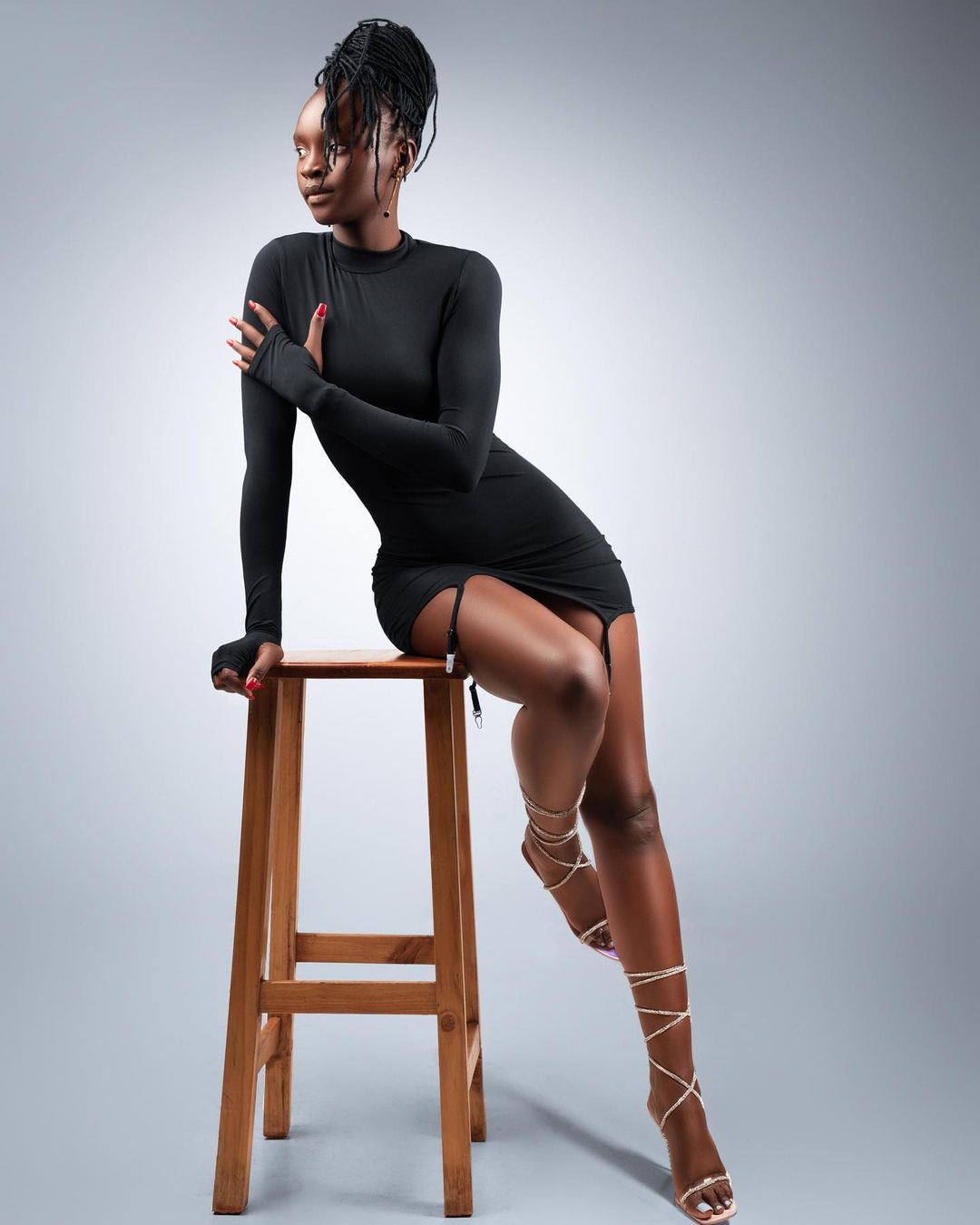 [PHOTO: Nicole Otieno hopes to win the Miss Heritage International Kenya 2024 ]
[PHOTO: Nicole Otieno hopes to win the Miss Heritage International Kenya 2024 ]
According to Immaculate, the winner will be chosen through a combination of voting and a panel of judges. Creativity and brain-based skills to understand the community will also play crucial roles in determining the winner. "All the finalists are aware that creativity matters when it comes to decision-making. Imagination and creativity are both very important in the current world, especially when it comes to helping others find solutions and even when you decide to become an entrepreneur," she explains.
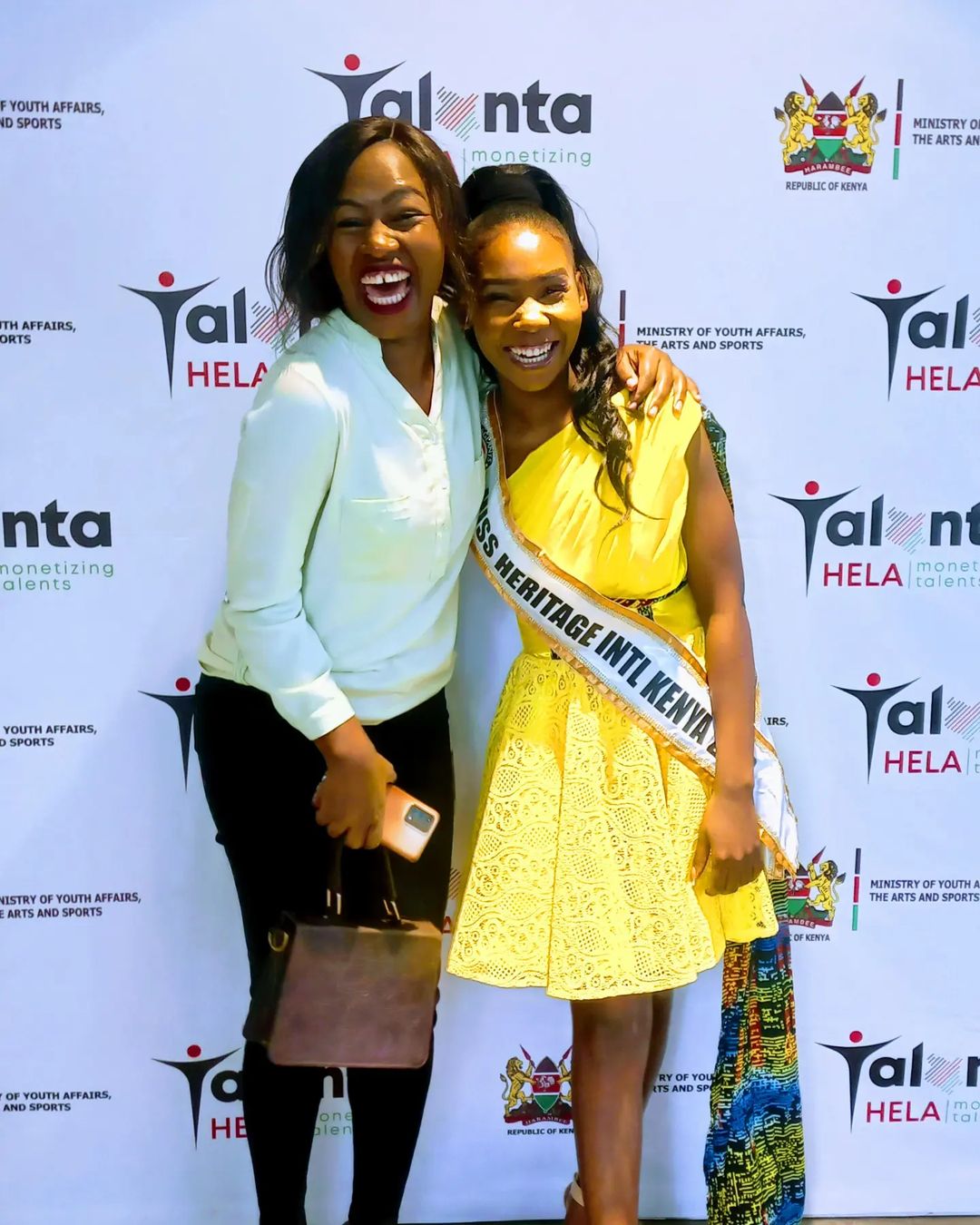 [PHOTO: Immaculate Onyoni founder and Director of the Miss, Mrs, and Mr. Heritage International Kenya]
[PHOTO: Immaculate Onyoni founder and Director of the Miss, Mrs, and Mr. Heritage International Kenya]
This edition is expected to bring together fashion enthusiasts, designers, models, and businesses. The audience will also have a chance to win prizes. "We will have time to identify the most fashionable audience member, and their fashion designer will gain promotion from our planned rewards," Immaculate says. "We invite fashion designers who want to showcase their products and exhibitors who want to do exhibitions. We will provide them with tables and spaces where they can meet with the audience as well as new clients attending our event" Immaculate continues "We will have guests from across the country, including government officials, corporate representatives, international delegates, media personnel, Artists, and many others! Our program promises to be more engaging for the audience than ever before! Join us as we celebrate Kenyan heritage"
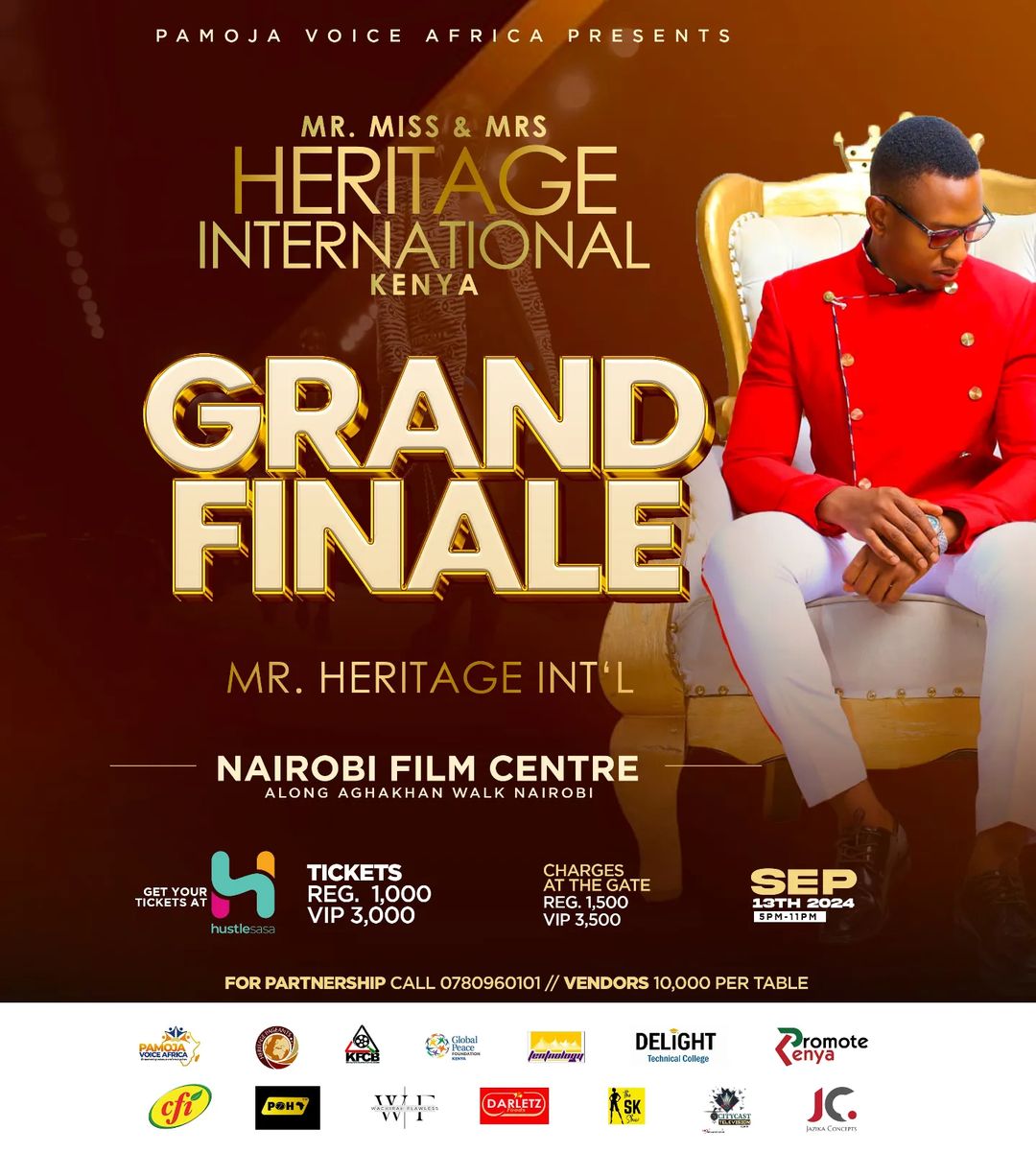
[POSTER: Miss, Mrs., and Mr. Heritage International Kenya is scheduled on 13th September at Nairobi Film Centre]
Miss, Mrs., and Mr. Heritage International Kenya is among the top pageants in the country, unique due to its concept. Currently, Tendwa holds the title of Miss Heritage International Kenya 2023, while Cynthia Kimathi is Mrs. Heritage International Kenya 2023.
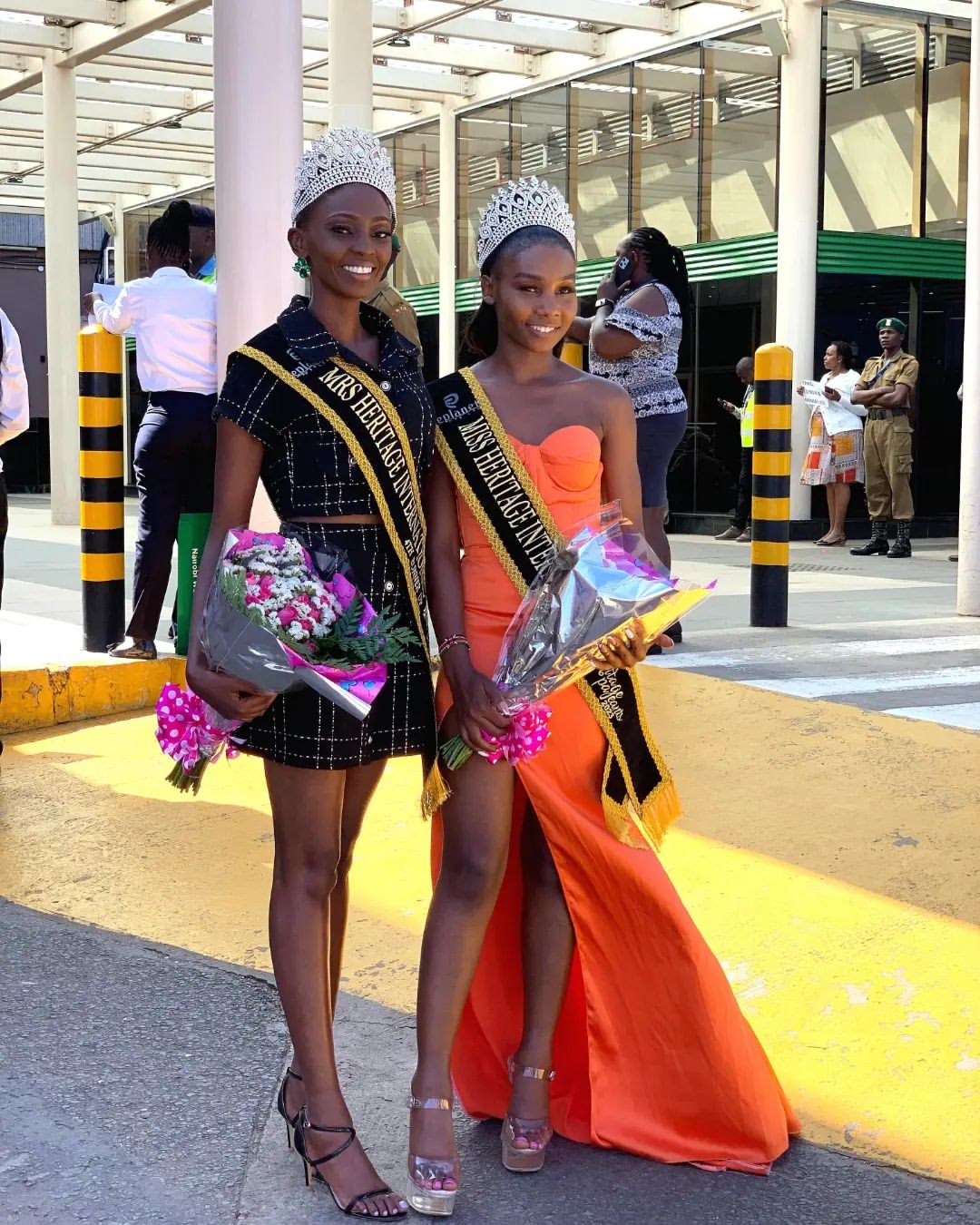 [PHOTO: From right Miss Tendwa holds the title of Miss Heritage International Kenya 2023, while Cynthia Kimathi is Mrs. Heritage International Kenya 2023]
[PHOTO: From right Miss Tendwa holds the title of Miss Heritage International Kenya 2023, while Cynthia Kimathi is Mrs. Heritage International Kenya 2023]
The event promises to be a celebration of Kenyan culture, fashion, and talent, bringing together contestants and spectators from across the nation. As the finalists prepare to showcase their creativity, intelligence, and cultural pride, the anticipation builds for who will be crowned the next Miss, Mrs., and Mr. Heritage International Kenya 2024.
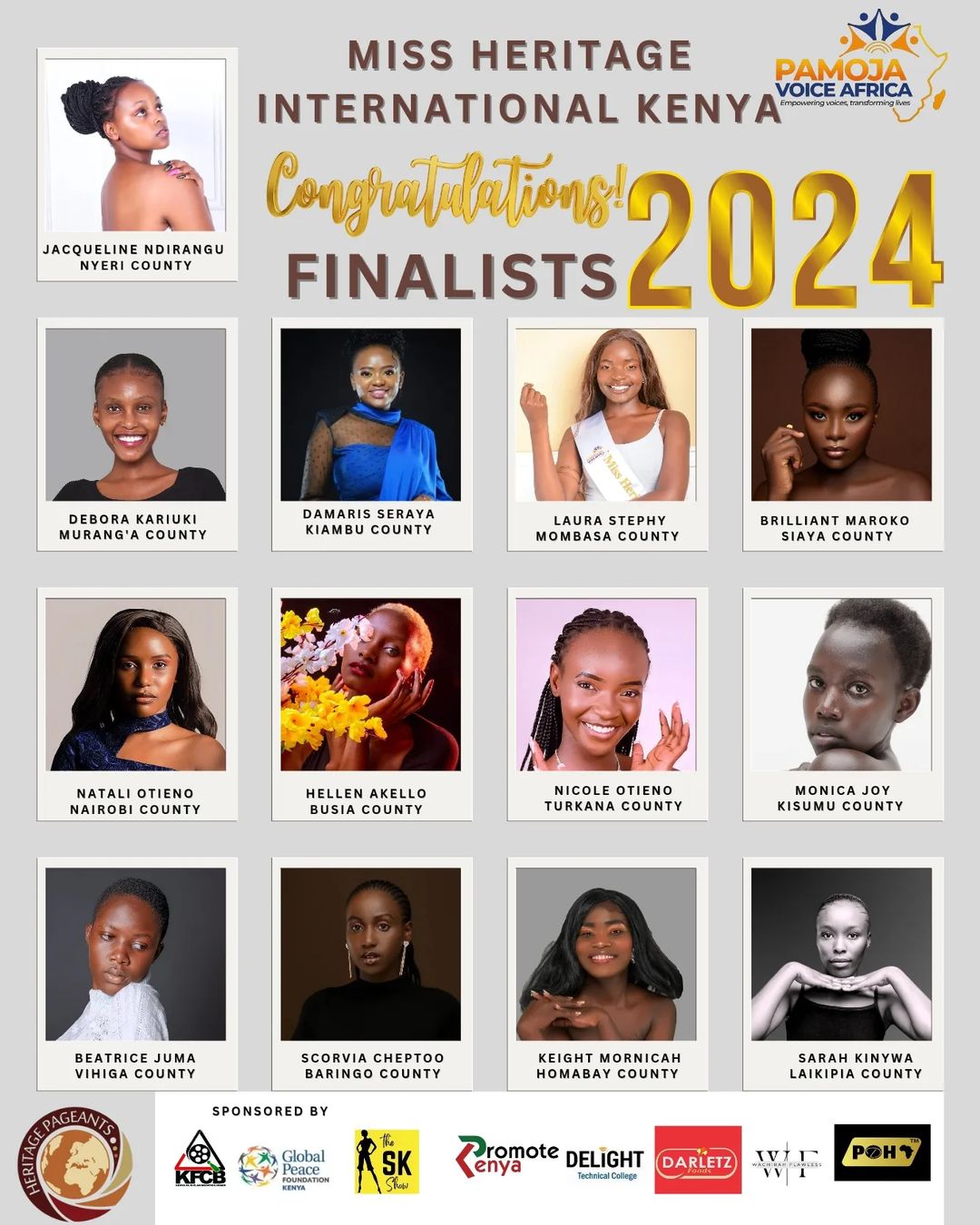 [PHOTOS: List of the finalists in Miss, Mrs, and Mr. Heritage International Kenya]
[PHOTOS: List of the finalists in Miss, Mrs, and Mr. Heritage International Kenya]
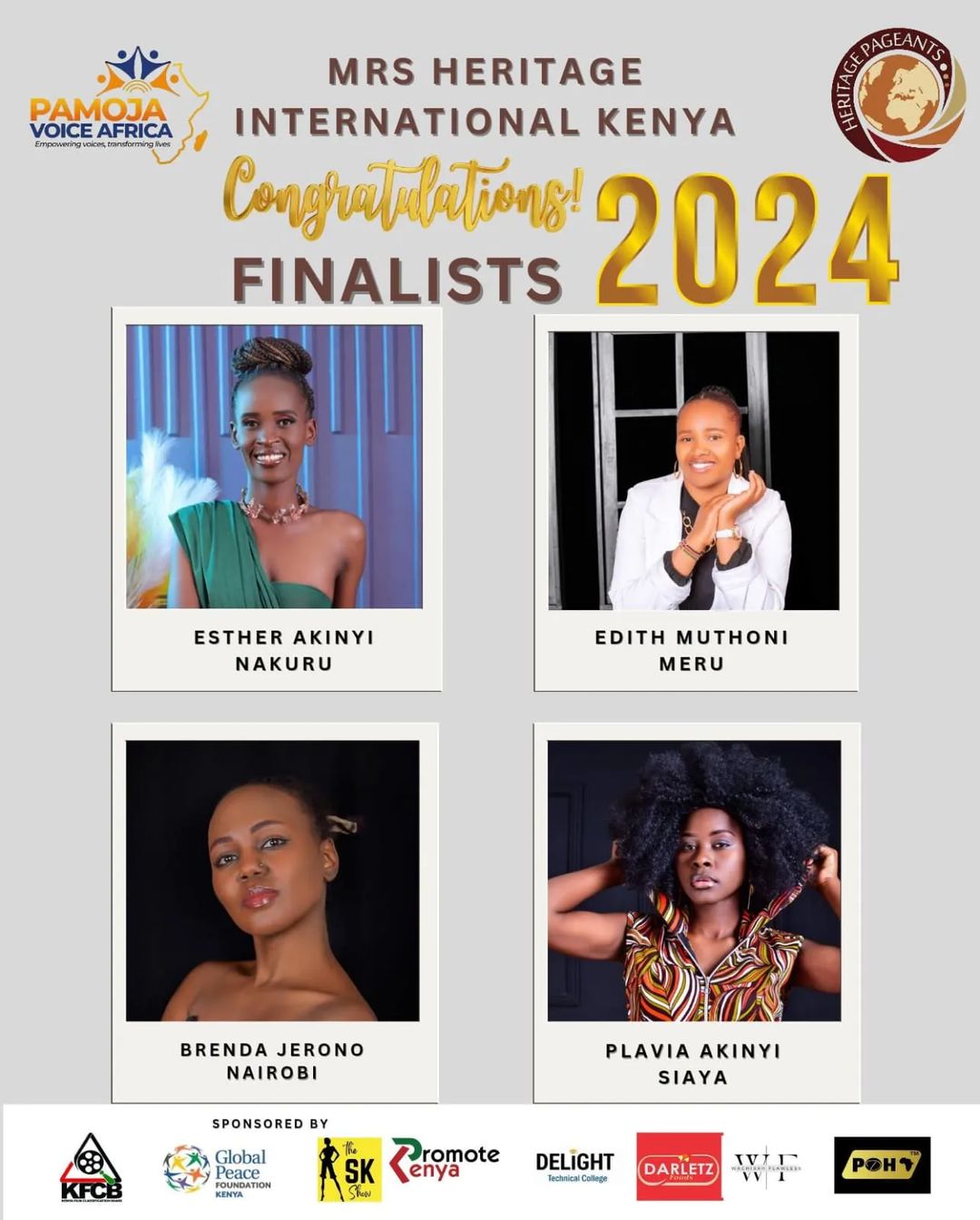 [PHOTOS: List of the finalists in Miss, Mrs, and Mr. Heritage International Kenya]
[PHOTOS: List of the finalists in Miss, Mrs, and Mr. Heritage International Kenya]
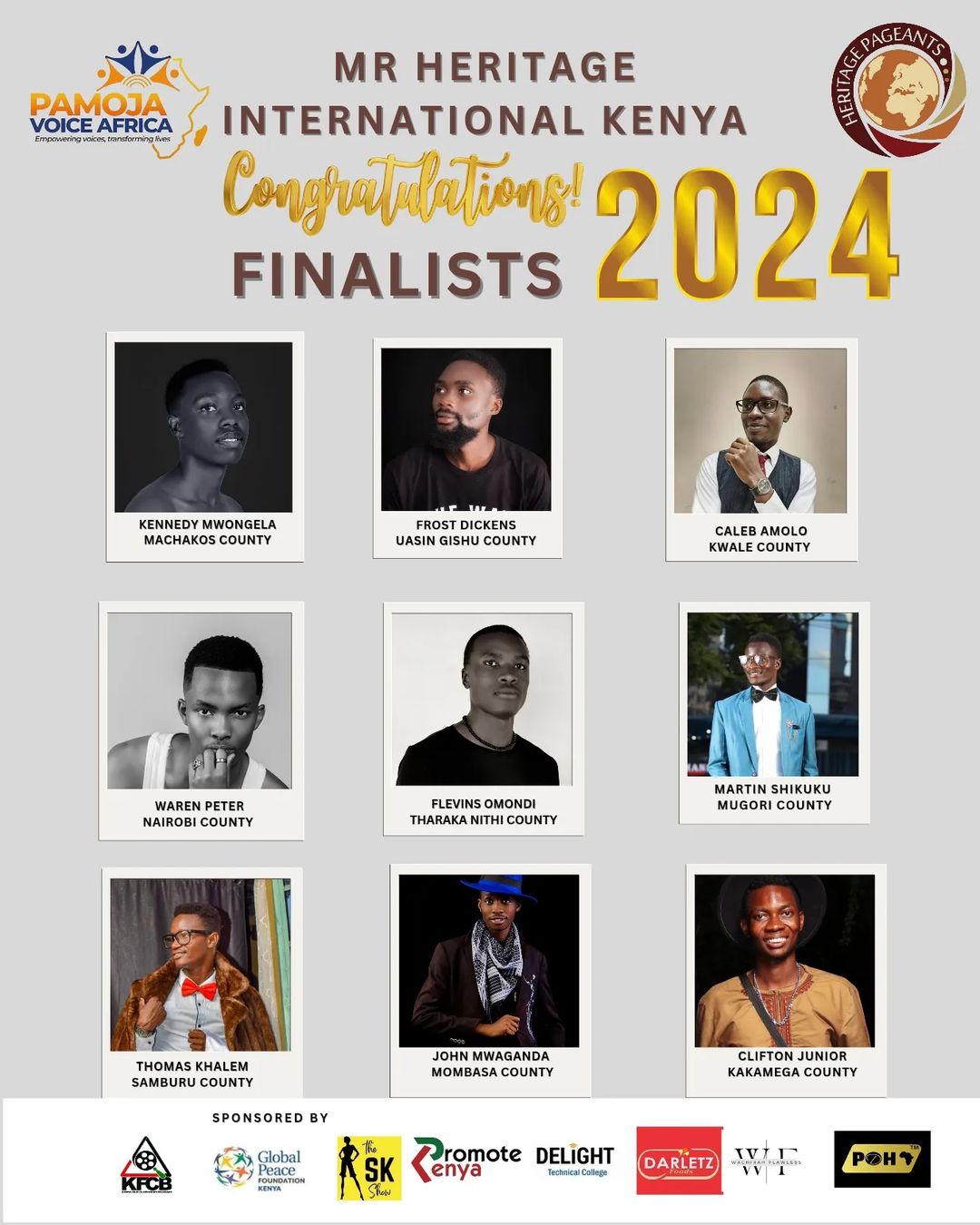 [PHOTOS: List of the finalists in Miss, Mrs, and Mr. Heritage International Kenya]
[PHOTOS: List of the finalists in Miss, Mrs, and Mr. Heritage International Kenya]
La Femme Fashion Show 2024: 4th Edition Takes Center Stage in Kinshasa
The vibrant city of Kinshasa is set to host the highly anticipated 4th edition of "LA FEMME FASHION SHOW" on September 7, 2024, at the prestigious Pullman Hotel. This annual fashion extravaganza, organized by international model Yuston Nessy, has become a cornerstone event in the Democratic Republic of Congo's cultural calendar, celebrating the beauty, creativity, and resilience of African women through the lens of fashion.
 [POSTER: La Femme Fashion Show 2024 is taking place in the capital city of DRC, Kinshasa
[POSTER: La Femme Fashion Show 2024 is taking place in the capital city of DRC, Kinshasa
A Platform for Empowerment and Creativity
At its core, the LA FEMME FASHION SHOW is more than just a runway event; it's a powerful statement on the role of women in African society. Yuston Nessy, the visionary behind this initiative, explains, "Valuing African women and their contributions to society through clothing is the main objective of the Femme Fashion Show." The event serves as a spotlight for the often-overlooked talents of African women in the fashion industry, providing them with a prestigious platform to showcase their designs and creativity.
 [PHOTO: Yuston Nessy CEO and founder of the La Femme Fashion Show during the models casting]
[PHOTO: Yuston Nessy CEO and founder of the La Femme Fashion Show during the models casting]
Beyond the Runway: Addressing Crucial Social Issues
While fashion takes center stage, the show's mission extends far beyond aesthetics. The Femme Fashion Show has positioned itself as a vocal advocate for gender equity and women's empowerment. It actively promotes "the fight against discrimination and violence against women," using the universal language of fashion to spark conversations about these critical issues.
Celebrating African Cultural Heritage
In African culture, particularly in the Congo, women have long been the custodians of clothing traditions. Yuston Nessy emphasizes this point, stating, "In African clothing culture in general and Congolese in particular, women occupy a main place. They create and make clothes to dress society, and to convey a message of love, unity, and dignity." The fashion show serves as a tribute to this rich heritage, bringing traditional designs into dialogue with contemporary styles.
 [PHOTO: Female runway models on the stage of the La Femme Fashion Show in the recent edition]
[PHOTO: Female runway models on the stage of the La Femme Fashion Show in the recent edition]
A Boost for Local Economies and Talent
The economic impact of LA FEMME FASHION SHOW cannot be overstated. Each edition provides income-generating opportunities to more than 150 women, from designers and models to event staff and local artisans. This injection of economic activity is particularly significant in a region where women often face barriers to financial independence.
Moreover, the show has become a launching pad for talent across East Africa. Yuston proudly notes, "It is not only fashion designers who are promoted through this event. Also, models from most of all countries in the East African Community attend the show." This regional focus helps to foster cultural exchange and cooperation among neighboring nations, using fashion as a unifying force.
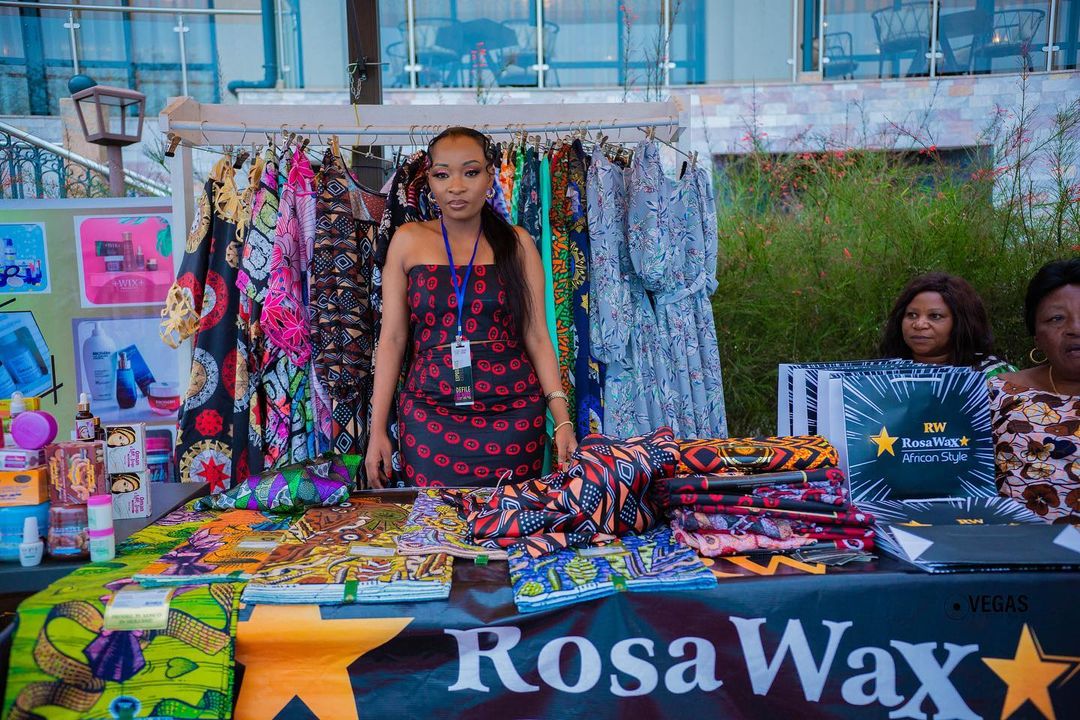 [PHOTO: Female exhibitor at the La Femme Fashion Show in the recent edition]
[PHOTO: Female exhibitor at the La Femme Fashion Show in the recent edition]
From Bukavu to Kinshasa: A Journey of Growth
The decision to bring the 4th edition to Kinshasa marks a significant milestone for the LA FEMME FASHION SHOW. After successful runs in Bukavu and Goma, the move to the capital city represents an expansion of the event's reach and influence. Kinshasa, known for its dynamic arts scene and fashion-forward population, provides the perfect backdrop for this celebration of African creativity.
The visionary behind the Show Yuston Nessy, the driving force behind LA FEMME FASHION SHOW, brings a wealth of experience and passion to the event. As a former Congolese model himself, Nessy understands firsthand the challenges and opportunities within the industry. His commitment to promoting locally made products, especially fashion styles, stems from a deep appreciation for the talent and craftsmanship found across the continent.
 [PHOTO: Female runway model on the stage of the La Femme Fashion Show in the recent edition]
[PHOTO: Female runway model on the stage of the La Femme Fashion Show in the recent edition]
As LA FEMME FASHION SHOW prepares for its 4th edition, the event stands as a testament to the growing influence of African fashion on the global stage. By providing a platform for designers to experiment with new ideas while honoring traditional techniques, the show is helping to shape the future of the industry.
The upcoming event in Kinshasa is expected to draw fashion enthusiasts, industry professionals, and media from across Africa and beyond. Attendees can look forward to a dazzling array of designs that blend traditional African textiles and patterns with contemporary silhouettes and techniques.
 [PHOTO: Female runway model on the stage of the La Femme Fashion Show in the recent edition]
[PHOTO: Female runway model on the stage of the La Femme Fashion Show in the recent edition]
A Call to Action
LA FEMME FASHION SHOW is more than just a night of glamour; it's a call to action for society to recognize and support the contributions of women in all spheres of life. As the event continues to grow, it serves as an inspiration for similar initiatives across the continent, encouraging a new generation of designers, models, and entrepreneurs to pursue their dreams.
 [PHOTO: Female runway model on the stage of the La Femme Fashion Show in the recent edition]
[PHOTO: Female runway model on the stage of the La Femme Fashion Show in the recent edition]
As September 7, 2024, approaches, all eyes will be on Kinshasa. The 4th edition of LA FEMME FASHION SHOW promises to be a spectacular celebration of African creativity, women's empowerment, and the enduring power of fashion to bring about positive social change. For those lucky enough to attend, it will be an unforgettable night of style, substance, and solidarity.
 [PHOTO: Female runway model on the stage of the La Femme Fashion Show in the recent edition]
[PHOTO: Female runway model on the stage of the La Femme Fashion Show in the recent edition]
 [PHOTO: Female runway model on the stage of the La Femme Fashion Show in the recent edition]
[PHOTO: Female runway model on the stage of the La Femme Fashion Show in the recent edition]
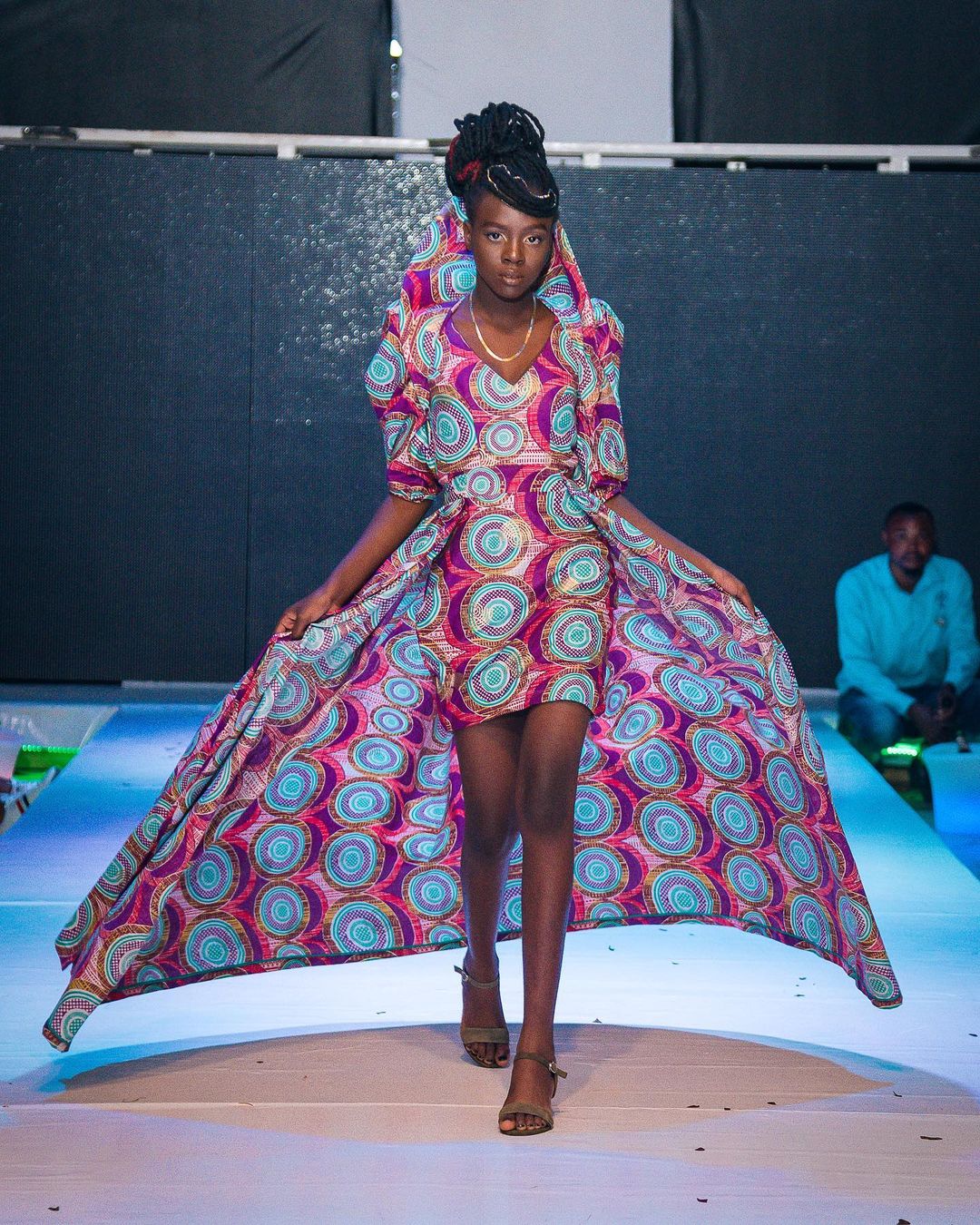 [PHOTO: Female runway model on the stage of the La Femme Fashion Show in the recent edition]
[PHOTO: Female runway model on the stage of the La Femme Fashion Show in the recent edition]
 [PHOTO: Female runway model on the stage of the La Femme Fashion Show in the recent edition]
[PHOTO: Female runway model on the stage of the La Femme Fashion Show in the recent edition]
 [PHOTO: Female runway model on the stage of the La Femme Fashion Show in the recent edition]
[PHOTO: Female runway model on the stage of the La Femme Fashion Show in the recent edition]
 [PHOTO: Guest at the La Femme Fashion Show in the recent edition]
[PHOTO: Guest at the La Femme Fashion Show in the recent edition]
Where Fashion Meets Opportunity: The ASFW 2024 Updates in Addis Ababa
As the Africa Sourcing and Fashion Week (ASFW) 2024 approaches, anticipation builds for what promises to be a landmark event in the world of Sub-Saharan fashion and textiles. Set to take place from November 8th to 11th at the Ethiopian Skylight Hotel in Addis Ababa, this year's exhibition marks a significant milestone—its 10th anniversary. ASFW has established itself as Africa's premier textile and leather showcase, bringing together top manufacturers, renowned brands, and industry innovators.
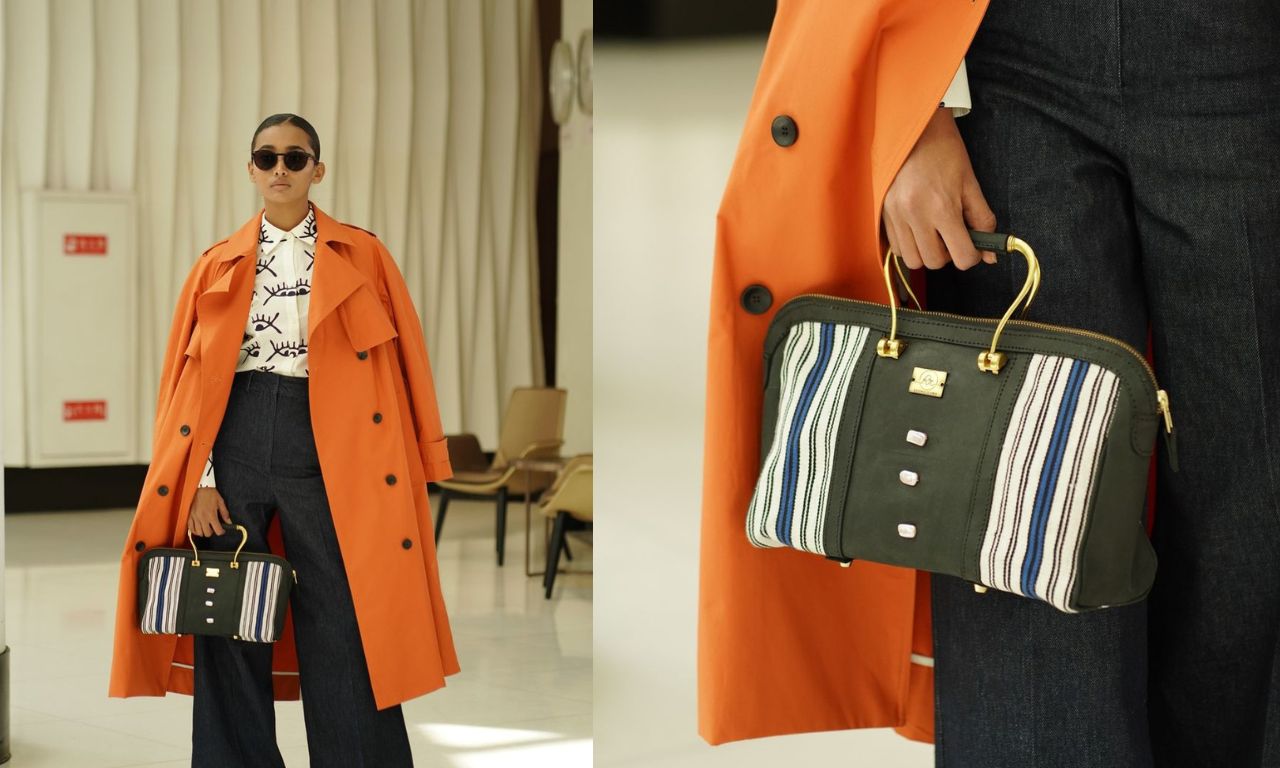 [PHOTO: Collection made by Asantii fashion brand from Kenya, Bag made by Radiance Leather from Kenya - Model: Selamawit Tsuruy]
[PHOTO: Collection made by Asantii fashion brand from Kenya, Bag made by Radiance Leather from Kenya - Model: Selamawit Tsuruy]
The organizers have already released exciting details about the event, centered around the theme "Fashion, Sourcing, Sustainability and Innovation." With an expected international visitor profile exceeding 7,000 and a high proportion of decision-makers in attendance, ASFW 2024 is poised to set trends for the entire value chain.
"We're bringing together the entire textile and leather value chain for an event unlike any other," the organizers announced. This year's ASFW is not just an exhibition; it's a comprehensive experience that promises to shape the future of the industry.
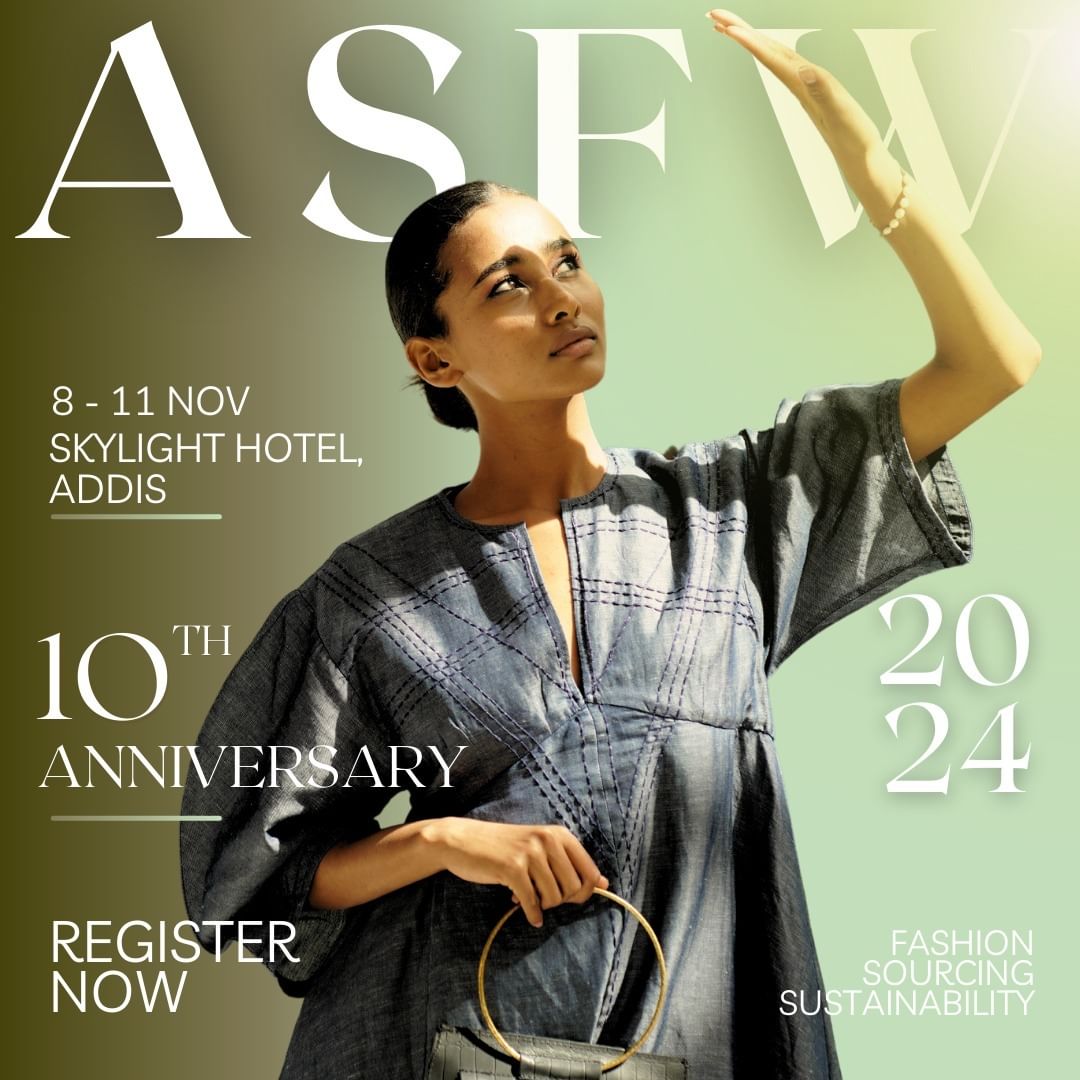 [POSTER: Collection made by Asantii fashion brand from Kenya]
[POSTER: Collection made by Asantii fashion brand from Kenya]
Conference Highlights
The conference program boasts an impressive array of topics that reflect the current challenges and opportunities in the African fashion industry. "Our newly released conference topics span everything from digital innovation in leather goods production to the challenges of a circular economy in fashion, sustainable sourcing, and the transformative impact of AI on design," the organizers stated.
Some of the key topics to be discussed include:
Circular Economy in Fashion: Challenges and Opportunities- Sustainable Sourcing and Supply Chain Transparency- Leather Craftsmanship and Artisanal Techniques in the East African Region- Fashion Retail Strategy in the Age of E-Commerce-Digital Transformation in Textile Manufacturing- Textile and Apparel Recycling and Upcycling Techniques- Impact of Artificial Intelligence on Fashion Design- Future of Fashion Retail: Omnichannel Experiences and Beyond.
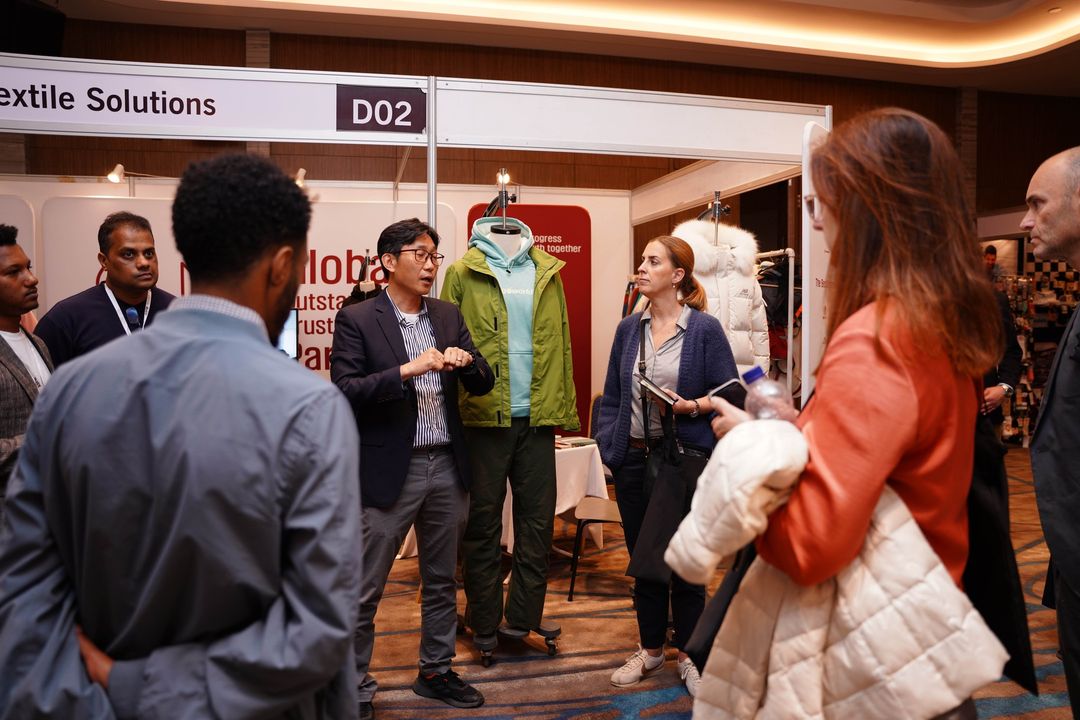 [PHOTO: ASFW 2023]
[PHOTO: ASFW 2023]
These discussions aim to boost the knowledge of participants and provide insights into the latest industry trends and innovations.
Exhibitor Showcase
ASFW 2024 will feature a diverse range of exhibitors showcasing their products, with attendees having the opportunity to purchase directly from designers and exhibitors. Among the confirmed exhibitors are:
AKILA Apparel: Described as "your go-to brand for quality and comfort, inspired by the vibrant spirit of Nairobi," AKILA Apparel empowers individuals through versatile and stylish apparel, ranging from gym wear to casual clothes.
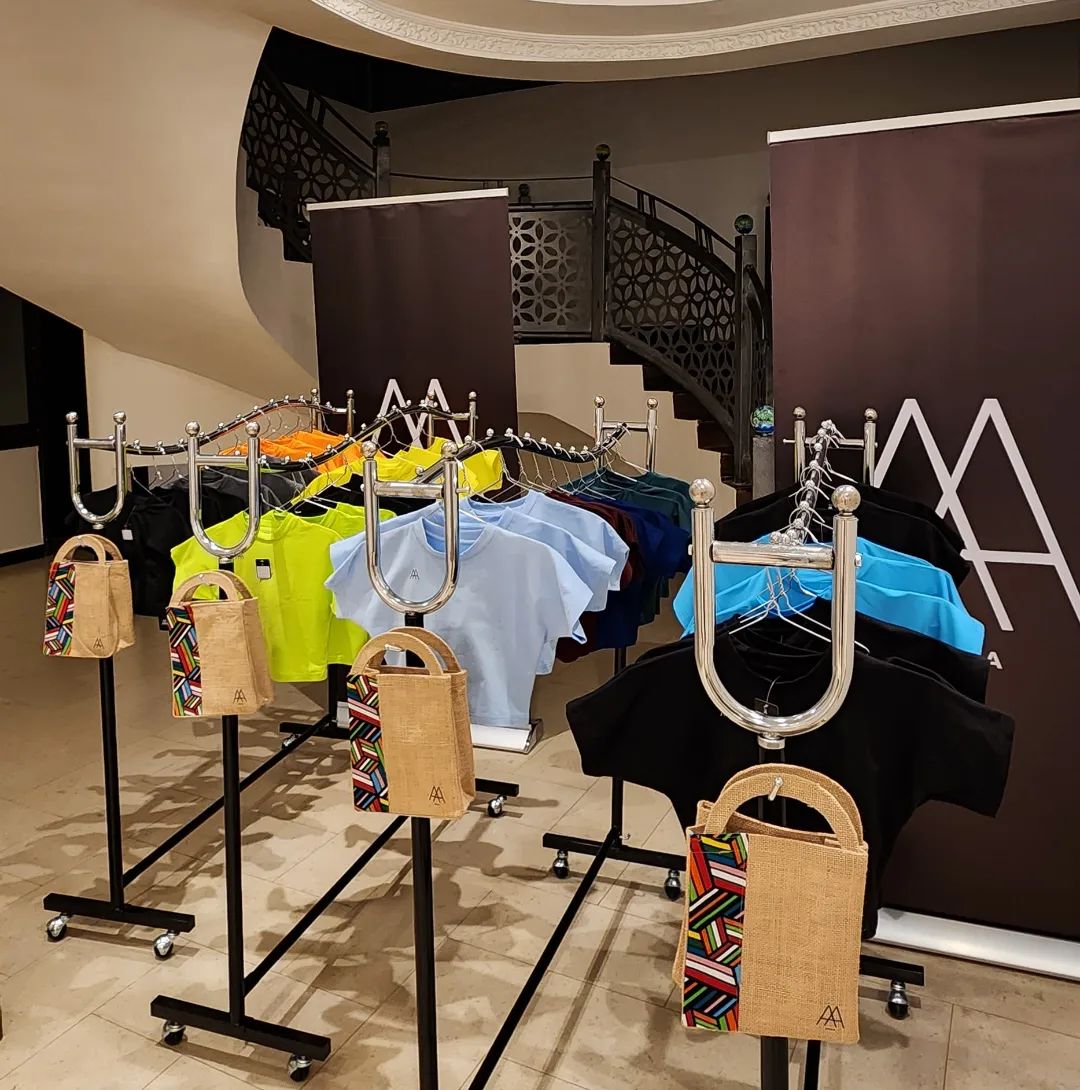 [PHOTO: Bag and outfits made by Akila Apparel from Kenya will be exhibited at the ASFW 2024]
[PHOTO: Bag and outfits made by Akila Apparel from Kenya will be exhibited at the ASFW 2024]
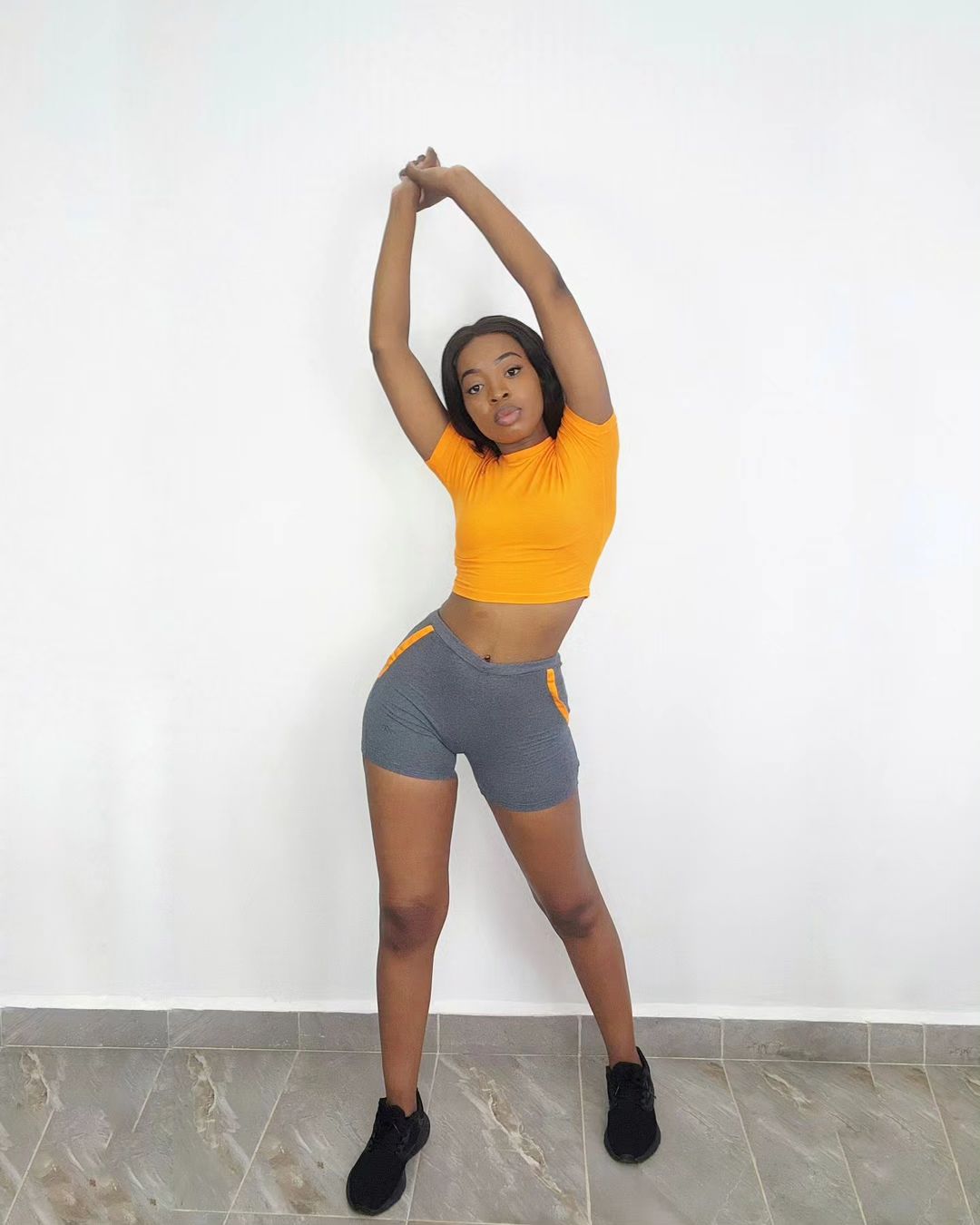 [PHOTO: sports outfit made by Akila Apparel from Kenya will be exhibited at the ASFW 2024]
[PHOTO: sports outfit made by Akila Apparel from Kenya will be exhibited at the ASFW 2024]
Assantii: This Kenyan fashion brand has garnered attention for creating the stunning outfits used to promote ASFW 2024.
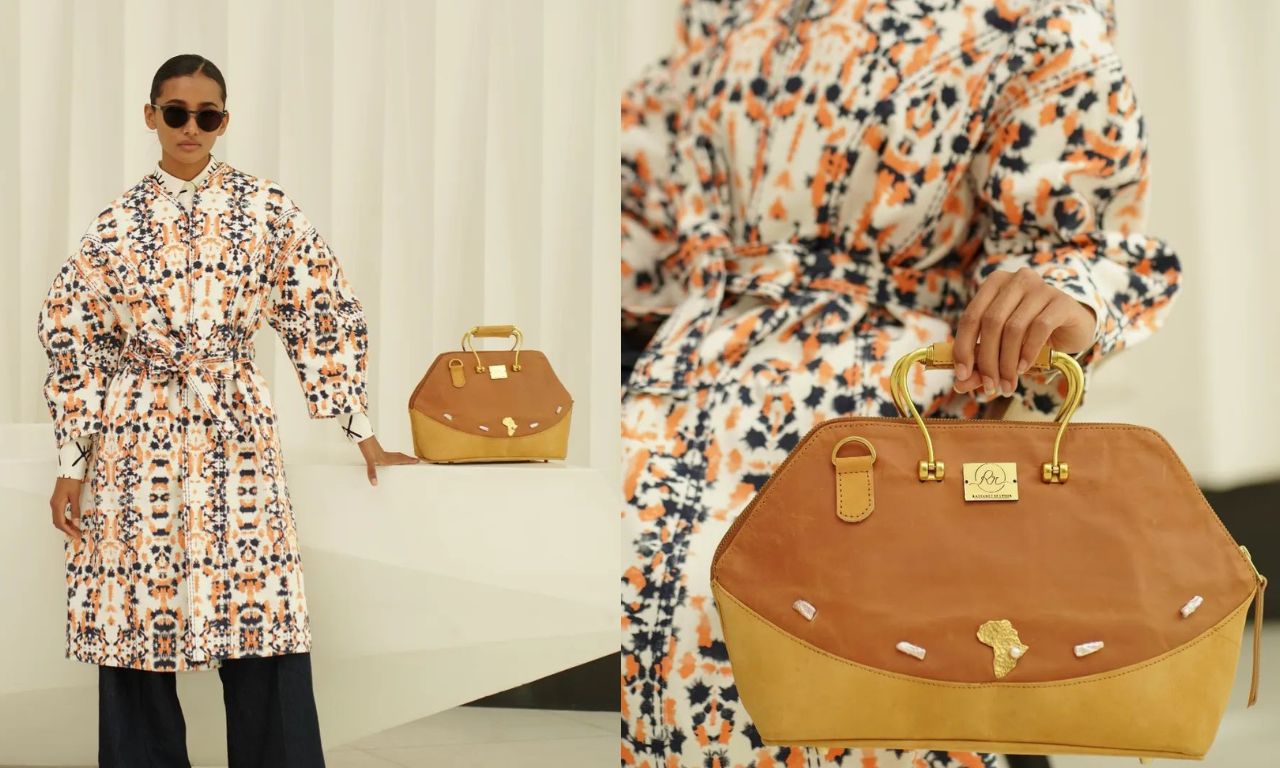 [PHOTO: Collection made by Asantii fashion brand from Kenya, Bag made by Credible Jewels from Kenya- Model: Selamawit Tsuruy]
[PHOTO: Collection made by Asantii fashion brand from Kenya, Bag made by Credible Jewels from Kenya- Model: Selamawit Tsuruy]
The exhibitor lineup promises to showcase the best of African fashion and textile manufacturing, offering a unique opportunity for buyers and industry professionals to engage directly with creators and innovators.
- B2B Opportunities and Networking
ASFW 2024 is not just about showcasing products; it's a vital platform for business connections and industry networking. "This year, we're bringing together top manufacturers showcasing their finest products, along with top buyers representing famous brands from Europe and the US. Experience exclusive B2B sessions and connect with industry leaders at our biggest event yet," the organizers announced.
These B2B sessions offer invaluable opportunities for manufacturers to connect with international buyers, potentially opening new markets and collaborations. For buyers, it's a chance to discover unique products and tap into the growing African fashion and textile industry.
- Leather Industry Focus
A significant aspect of ASFW 2024 is its focus on the leather industry. Attendees will have the opportunity to connect with the best in leather, gaining first-hand insights into the latest market trends and innovations in leather goods production. This segment of the event underscores the importance of the leather industry in Africa's fashion and textile landscape.
- Sustainability and Innovation
In line with global trends, sustainability and innovation are at the forefront of ASFW 2024. The conference will delve into crucial topics such as sustainable sourcing, supply chain transparency, and the challenges of implementing a circular economy in fashion. These discussions reflect the industry's growing commitment to environmentally conscious practices and the need for innovative solutions to address sustainability challenges in Africa.
- The Future of Fashion Retail
With sessions on e-commerce strategies and omnichannel experiences, ASFW 2024 acknowledges the rapidly changing landscape of fashion retail. These topics are particularly relevant as the industry navigates the post-pandemic world, where digital transformation has accelerated, and consumer behaviors have shifted significantly.
- Artificial Intelligence in Fashion
The inclusion of AI-related topics highlights the event's forward-thinking approach. Discussions on the impact of AI on fashion design and retail promise to offer valuable insights into how technology is reshaping the creative and commercial aspects of the industry.
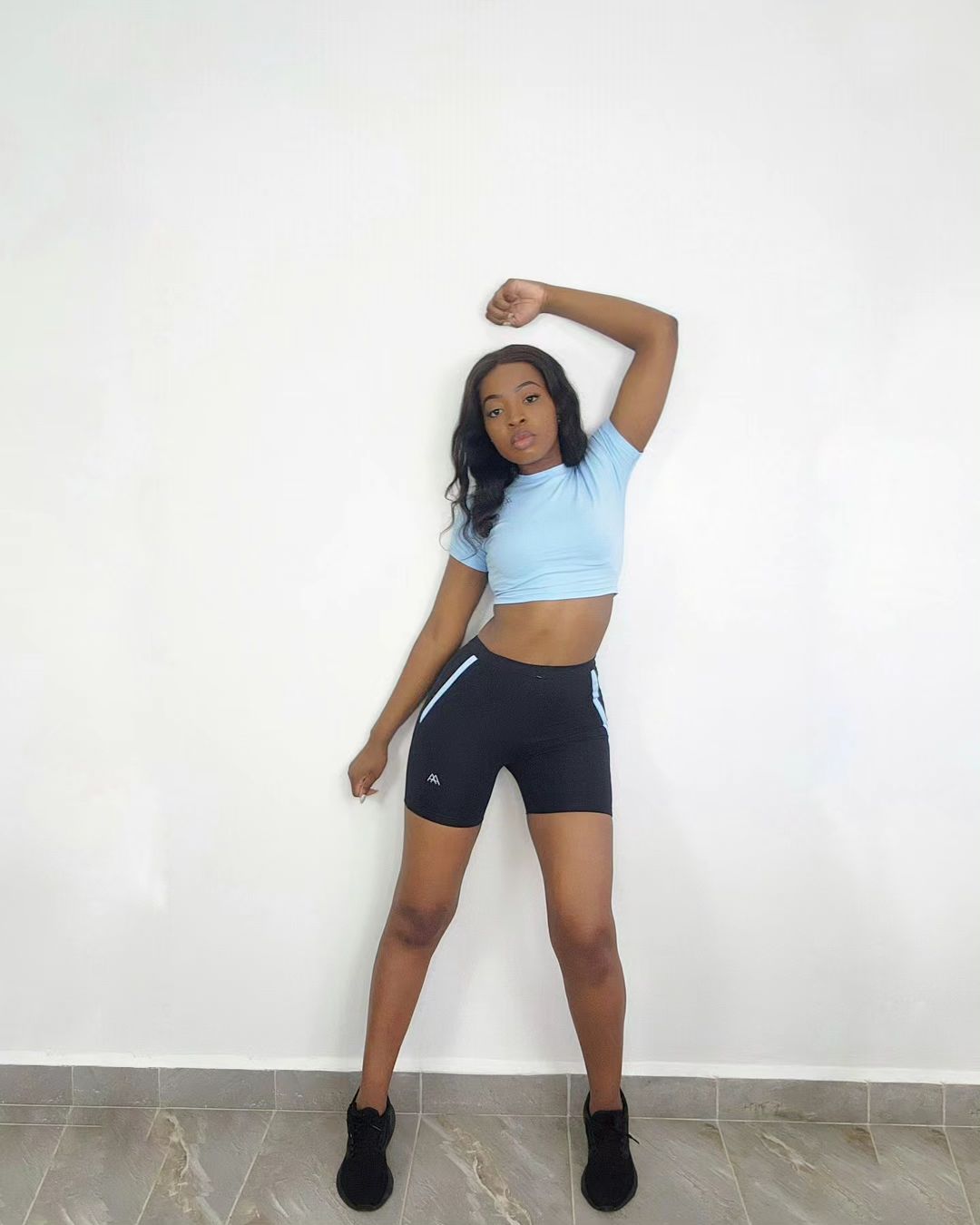 [PHOTO: sports outfit made by Akila Apparel from Kenya will be exhibited at the ASFW 2024]
[PHOTO: sports outfit made by Akila Apparel from Kenya will be exhibited at the ASFW 2024]
As ASFW 2024 prepares to open its doors, it stands as a testament to the dynamism and potential of the African fashion and textile industry. With its comprehensive program, diverse exhibitor lineup, and focus on crucial industry topics, the event offers something for everyone in the fashion value chain.
For attendees, ASFW 2024 presents an unparalleled opportunity to gain insights, make connections, and be part of the conversations shaping the future of the industry. As Africa continues to establish itself as a significant player in the global fashion and textile market, events like ASFW play a crucial role in showcasing the continent's creativity, craftsmanship, and business potential.
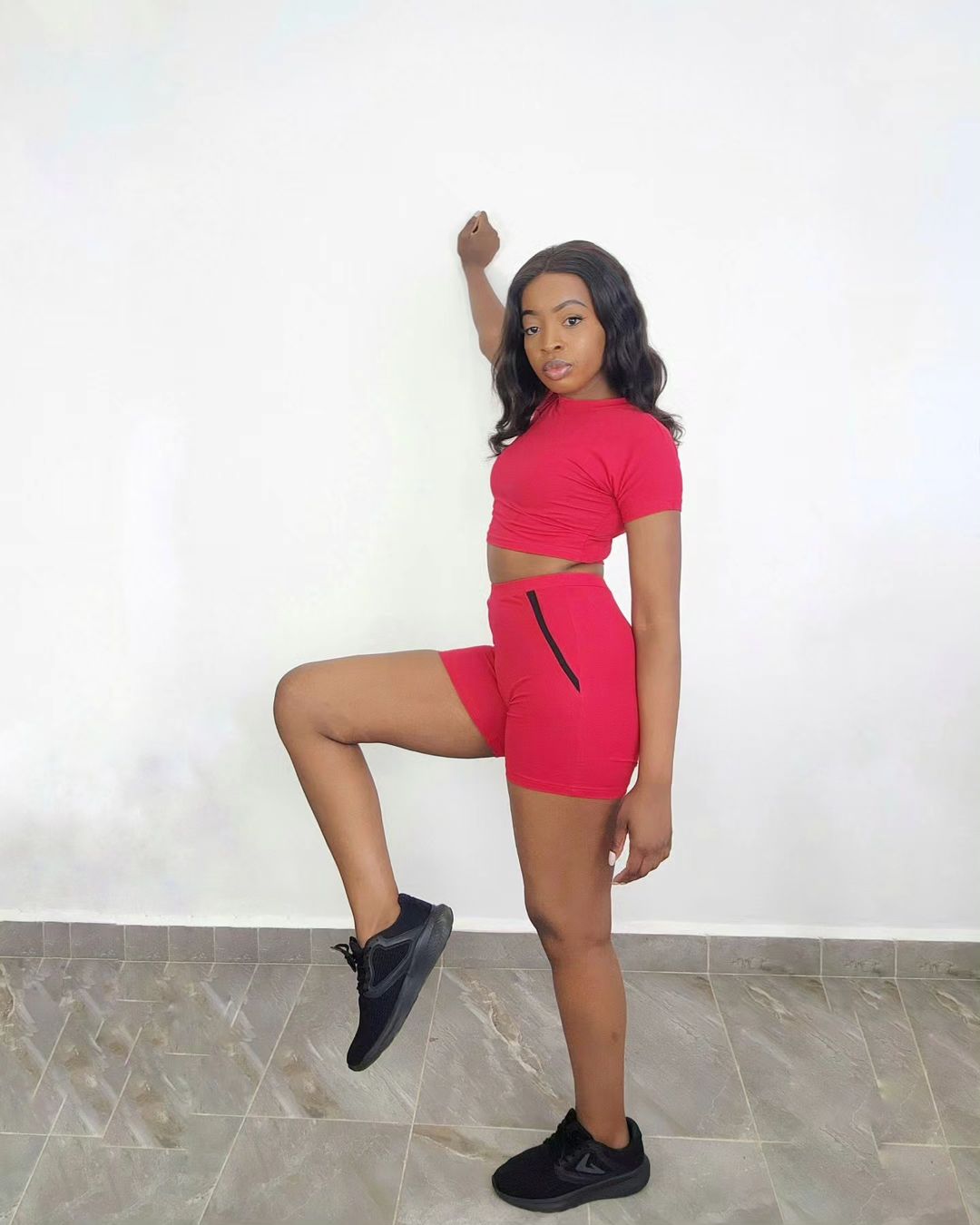 [PHOTO: sports outfit made by Akila Apparel from Kenya will be exhibited at the ASFW 2024]
[PHOTO: sports outfit made by Akila Apparel from Kenya will be exhibited at the ASFW 2024]
The 10th anniversary edition of ASFW promises to be a celebration of African fashion's past achievements and a bold step towards its future. For anyone involved in the fashion and textile industry, ASFW 2024 in Addis Ababa is an event not to be missed.
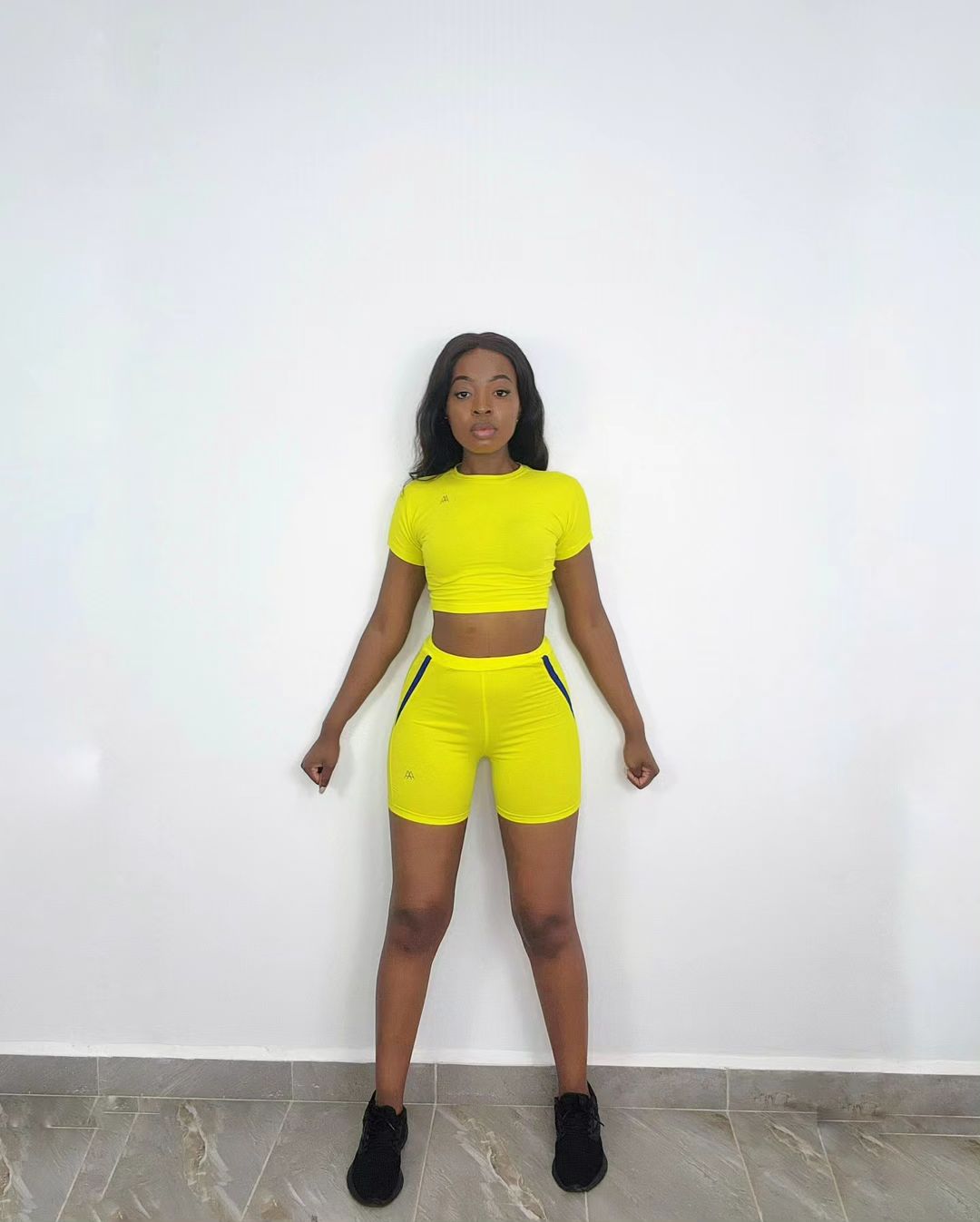 [PHOTO: sports outfit made by Akila Apparel from Kenya will be exhibited at the ASFW 2024]
[PHOTO: sports outfit made by Akila Apparel from Kenya will be exhibited at the ASFW 2024]
Where Fashion Meets Opportunity: The ASFW 2024 Updates in Addis Ababa
As the Africa Sourcing and Fashion Week (ASFW) 2024 approaches, anticipation builds for what promises to be a landmark event in the world of Sub-Saharan fashion and textiles. Set to take place from November 8th to 11th at the Ethiopian Skylight Hotel in Addis Ababa, this year's exhibition marks a significant milestone—its 10th anniversary. ASFW has established itself as Africa's premier textile and leather showcase, bringing together top manufacturers, renowned brands, and industry innovators.
 [PHOTO: Collection made by Asantii fashion brand from Kenya, Bag made by Radiance Leather from Kenya- Model: Selamawit Tsuruy]
[PHOTO: Collection made by Asantii fashion brand from Kenya, Bag made by Radiance Leather from Kenya- Model: Selamawit Tsuruy]
The organizers have already released exciting details about the event, centered around the theme "Fashion, Sourcing, Sustainability and Innovation." With an expected international visitor profile exceeding 7,000 and a high proportion of decision-makers in attendance, ASFW 2024 is poised to set trends for the entire value chain.
"We're bringing together the entire textile and leather value chain for an event unlike any other," the organizers announced. This year's ASFW is not just an exhibition; it's a comprehensive experience that promises to shape the future of the industry.
 [POSTER: Collection made by Asantii fashion brand from Kenya]
[POSTER: Collection made by Asantii fashion brand from Kenya]
Conference Highlights
The conference program boasts an impressive array of topics that reflect the current challenges and opportunities in the African fashion industry. "Our newly released conference topics span everything from digital innovation in leather goods production to the challenges of a circular economy in fashion, sustainable sourcing, and the transformative impact of AI on design," the organizers stated.
Some of the key topics to be discussed include:
Circular Economy in Fashion: Challenges and Opportunities- Sustainable Sourcing and Supply Chain Transparency- Leather Craftsmanship and Artisanal Techniques in the East African Region- Fashion Retail Strategy in the Age of E-Commerce-Digital Transformation in Textile Manufacturing- Textile and Apparel Recycling and Upcycling Techniques- Impact of Artificial Intelligence on Fashion Design- Future of Fashion Retail: Omnichannel Experiences and Beyond.
 [PHOTO: ASFW 2023]
[PHOTO: ASFW 2023]
These discussions aim to boost the knowledge of participants and provide insights into the latest industry trends and innovations.
Exhibitor Showcase
ASFW 2024 will feature a diverse range of exhibitors showcasing their products, with attendees having the opportunity to purchase directly from designers and exhibitors. Among the confirmed exhibitors are:
AKILA Apparel: Described as "your go-to brand for quality and comfort, inspired by the vibrant spirit of Nairobi," AKILA Apparel empowers individuals through versatile and stylish apparel, ranging from gym wear to casual clothes.
 [PHOTO: Bag and outfits made by Akila Apparel from Kenya will be exhibited at the ASFW 2024]
[PHOTO: Bag and outfits made by Akila Apparel from Kenya will be exhibited at the ASFW 2024]
 [PHOTO: sports outfit made by Akila Apparel from Kenya will be exhibited at the ASFW 2024]
[PHOTO: sports outfit made by Akila Apparel from Kenya will be exhibited at the ASFW 2024]
Assantii: This Kenyan fashion brand has garnered attention for creating the stunning outfits used to promote ASFW 2024.
 [PHOTO: Collection made by Asantii fashion brand from Kenya, Bag made by Credible Jewels from Kenya- Model: Selamawit Tsuruy]
[PHOTO: Collection made by Asantii fashion brand from Kenya, Bag made by Credible Jewels from Kenya- Model: Selamawit Tsuruy]
The exhibitor lineup promises to showcase the best of African fashion and textile manufacturing, offering a unique opportunity for buyers and industry professionals to engage directly with creators and innovators.
- B2B Opportunities and Networking
ASFW 2024 is not just about showcasing products; it's a vital platform for business connections and industry networking. "This year, we're bringing together top manufacturers showcasing their finest products, along with top buyers representing famous brands from Europe and the US. Experience exclusive B2B sessions and connect with industry leaders at our biggest event yet," the organizers announced.
These B2B sessions offer invaluable opportunities for manufacturers to connect with international buyers, potentially opening new markets and collaborations. For buyers, it's a chance to discover unique products and tap into the growing African fashion and textile industry.
- Leather Industry Focus
A significant aspect of ASFW 2024 is its focus on the leather industry. Attendees will have the opportunity to connect with the best in leather, gaining first-hand insights into the latest market trends and innovations in leather goods production. This segment of the event underscores the importance of the leather industry in Africa's fashion and textile landscape.
- Sustainability and Innovation
In line with global trends, sustainability and innovation are at the forefront of ASFW 2024. The conference will delve into crucial topics such as sustainable sourcing, supply chain transparency, and the challenges of implementing a circular economy in fashion. These discussions reflect the industry's growing commitment to environmentally conscious practices and the need for innovative solutions to address sustainability challenges in Africa.
- The Future of Fashion Retail
With sessions on e-commerce strategies and omnichannel experiences, ASFW 2024 acknowledges the rapidly changing landscape of fashion retail. These topics are particularly relevant as the industry navigates the post-pandemic world, where digital transformation has accelerated, and consumer behaviors have shifted significantly.
- Artificial Intelligence in Fashion
The inclusion of AI-related topics highlights the event's forward-thinking approach. Discussions on the impact of AI on fashion design and retail promise to offer valuable insights into how technology is reshaping the creative and commercial aspects of the industry.
 [PHOTO: sports outfit made by Akila Apparel from Kenya will be exhibited at the ASFW 2024]
[PHOTO: sports outfit made by Akila Apparel from Kenya will be exhibited at the ASFW 2024]
As ASFW 2024 prepares to open its doors, it stands as a testament to the dynamism and potential of the African fashion and textile industry. With its comprehensive program, diverse exhibitor lineup, and focus on crucial industry topics, the event offers something for everyone in the fashion value chain.
For attendees, ASFW 2024 presents an unparalleled opportunity to gain insights, make connections, and be part of the conversations shaping the future of the industry. As Africa continues to establish itself as a significant player in the global fashion and textile market, events like ASFW play a crucial role in showcasing the continent's creativity, craftsmanship, and business potential.
 [PHOTO: sports outfit made by Akila Apparel from Kenya will be exhibited at the ASFW 2024]
[PHOTO: sports outfit made by Akila Apparel from Kenya will be exhibited at the ASFW 2024]
The 10th anniversary edition of ASFW promises to be a celebration of African fashion's past achievements and a bold step towards its future. For anyone involved in the fashion and textile industry, ASFW 2024 in Addis Ababa is an event not to be missed.
 [PHOTO: sports outfit made by Akila Apparel from Kenya will be exhibited at the ASFW 2024]
[PHOTO: sports outfit made by Akila Apparel from Kenya will be exhibited at the ASFW 2024]
All Set for the Novelty Fashion Week 2024, 6th September
The vibrant city of Kigali is buzzing with anticipation as the countdown begins for the highly anticipated Novelty Fashion Week 2024. Following the resounding success of its inaugural event last year, this fashion extravaganza is set to return with an expanded format, promising three days of sartorial splendor that will showcase the beauty and creations of Rwandan fashion design.
Scheduled from September 4th to 7th, 2024, this year's event is poised to be a melting pot of creativity, innovation, and style. The concept behind Novelty Fashion Week remains both simple and powerful: to create a platform where emerging designers, fresh graduates from the Integrated Polytechnic Regional College (IPRC), can work alongside established professionals in the industry. This collaborative approach fosters a unique environment of mentorship, learning, and mutual growth that benefits both seasoned veterans and up-and-coming talents.
 [PHOTO: Collection made by Brand Eight that will be showcased at the Novelty Fashion Week 2024]
[PHOTO: Collection made by Brand Eight that will be showcased at the Novelty Fashion Week 2024]
ALSO READ: What to Expect in the Kigali Novelty Fashion Experience 2024
While the 2023 edition focused primarily on nurturing local talent, the 2024 incarnation is casting a wider net, embracing a more diverse roster of designers. Fashion enthusiasts can look forward to a thrilling mix of familiar faces and fresh discoveries. Returning favorites like MATHEO and SHEMA GAETAN, who captivated audiences last year with their innovative designs, will share the runway with exciting new local talents. Adding an international flavor to the proceedings, the organizers have also invited designers from abroad, eager to make their mark on Kigali's burgeoning fashion scene. This infusion of global perspectives promises to spark exciting cross-cultural collaborations and push the boundaries of fashion in Rwanda.
The event kicks off on Wednesday, September 4th, with a thought-provoking panel discussion at the Institut Français de Kigali. Industry experts, designers, and fashion critics will convene to explore current trends, challenges, and opportunities in the Rwandan fashion landscape. Topics may include sustainability in fashion, the integration of traditional craftsmanship with modern design, and strategies for taking Rwandan fashion to the global stage. This intellectual discourse will set the tone for the days to follow, providing context and depth to the visual feast that awaits.
 [PHOTO: Collection made by Shema Gaetan will showcase at the Novelty Fashion Week 2024]
[PHOTO: Collection made by Shema Gaetan will showcase at the Novelty Fashion Week 2024]
Following the panel, the opening fashion show will take place at the same venue, offering a tantalizing preview of what's to come. This showcase will likely feature a carefully curated selection of designs, whetting the appetite of fashion aficionados and setting the bar high for the main event.
The highlight of the Novelty Fashion Week undoubtedly falls on Friday, September 6th. The main fashion show will unfold in the unexpected yet inspiring setting of the Akagera Cars Motors showroom. This unconventional choice of venue reflects the event's commitment to thinking outside the box and creating memorable experiences. The juxtaposition of sleek automobiles and avant-garde fashion promises to create a visually stunning backdrop for the designers' creations.
As the last model leaves the runway and the applause fades, the celebration will continue into the night with an exclusive after-party at ATELIER DU VIN. This sophisticated venue, known for its extensive wine selection and elegant ambiance, provides the perfect setting for designers, models, industry insiders, and fashion enthusiasts to mingle, network, and toast to the success of Rwandan fashion.
 [PHOTO: Collection made by Matheo will showcase at the Novelty Fashion Week 2024]
[PHOTO: Collection made by Matheo will showcase at the Novelty Fashion Week 2024]
The Novelty Fashion Week will conclude on Saturday, September 7th, with an exhibition and pop-up shop at the Institut Français de Kigali. This final day offers a more intimate and interactive experience for attendees. Fashion lovers will have the opportunity to get up close and personal with the designs they admired on the runway, speak directly with the designers, and even purchase pieces to add to their own wardrobes. This direct-to-consumer approach not only provides valuable feedback for the designers but also helps to bridge the gap between high fashion and everyday wear.
Throughout the three-day event, attendees can expect to see a wide range of styles and influences. From contemporary interpretations of traditional Rwandan textiles and patterns to cutting-edge designs that push the boundaries of fashion, the Novelty Fashion Week 2024 promises to offer something for every taste. Sustainable and ethical fashion practices are likely to feature prominently, reflecting the growing global consciousness around these issues.
 [PHOTO: Collection made by Koni Clothing will showcase at the Novelty Fashion Week 2024]
[PHOTO: Collection made by Koni Clothing will showcase at the Novelty Fashion Week 2024]
The organizers have expressed their excitement about the growth of the event in just its second year. They see the Novelty Fashion Week as more than just a showcase; it's a catalyst for the development of Rwanda's fashion industry. By providing a platform for collaboration between established and emerging designers, and by attracting international attention, the event aims to position Kigali as a rising star in the African fashion firmament.
As September 6th approaches, the fashion community in Rwanda and beyond is holding its breath in anticipation. The Novelty Fashion Week 2024 is not just a series of runway shows; it's a celebration of creativity, a launchpad for new talents, and a bold statement about the future of Rwandan fashion. Whether you're a dedicated fashionista or simply curious about the creative pulse of Kigali, this is one event you won't want to miss. Mark your calendars and prepare to be dazzled by the style, innovation, and sheer artistry that will be on display at the Novelty Fashion Week 2024.
I Can Win This: Stunning Model Nshogoza Jean in the Stage Fashion Showcase 2024 Boot Camp
The Stage Fashion Showcase 2024 model boot camp has entered its second phase, with participants vying for coveted prizes in this highly competitive event. Eighty selected models are undergoing rigorous training with professional coaches, aiming to refine their skills and stand out from the crowd.
The competition follows an elimination format, with models being cut at each stage until the winners emerge. According to the organizers, the top male and female models will each receive a prize of 800,000 Rwandan Francs. Additionally, successful participants will have the opportunity to showcase their talents at the second edition of the Stage Fashion Showcase, scheduled for October 19th at the Kigali Convention Center.
 [PHOTO: In the middle is Sandrine Mucyo CEO and founder of the Stage Fashion Showcase with the Model coach Mr. Ganza from the RIGHT During the boot camp]
[PHOTO: In the middle is Sandrine Mucyo CEO and founder of the Stage Fashion Showcase with the Model coach Mr. Ganza from the RIGHT During the boot camp]
For the second phase of training and boot camp, the selected models were gathered at the Mundi Center in Kigali, Rwanda's capital city. The organizers emphasize that this intensive program is designed to hone the models' skills, perfect their runway walks, and immerse them in the art of fashion.
"This boot camp is all about pushing boundaries, embracing creativity, discovering the best male and female models, and preparing to set the stage for unforgettable performances in our second edition," the organizers state.
 [PHOTO: From Left- Ms. Sandrine Mucyo CEO and founder of the Stage Fashion Showcase during the boot camp]
[PHOTO: From Left- Ms. Sandrine Mucyo CEO and founder of the Stage Fashion Showcase during the boot camp]
ALSO READ: Is the Rwanda Fashion Industry Isolated in the Region?: Challenges and Opportunities
Among the confident participants is Nshogoza Jean, a prominent Rwandan model who believes he has what it takes to win the competition. In an interview with RCFS'SMEDIA, Nshogoza expressed his determination to maintain the legacy he has built in Rwanda's modeling industry.
Nshogoza's career began in 2018, and he is currently managed by RIFI Fashion Agency. His talent and presence have already made significant waves in the fashion world, earning him prestigious accolades such as Rwanda Global Top Model 2023 at the Global Top Models Awards and Best Male Model of the Year 2023 at Karisimbi Events.
"The boot camp is going well, and every model wants to win," Nshogoza says. "Personally, I know I can beat them. I have enough confidence that I can win this competition. I've proven my talent as a model by winning Rwanda Global Top Model 2023, which was also a tough competition. So, I've got this."
 [PHOTO: Mr Nshogoza Jean during the Photoshoot by the Matheo clothing brand ]
[PHOTO: Mr Nshogoza Jean during the Photoshoot by the Matheo clothing brand ]
Nshogoza also expresses his trust in the competition organizers, praising their respect for models' rights. "I've worked in many different events in Dubai and Nigeria with various modeling companies, but the uniqueness of the Stage Fashion Showcase is that they know and respect models' rights. It's like having a mentor, a parent, and an inspirer all in one. I consider it family."
While Nshogoza is optimistic, not all participants share his enthusiasm about the prize money. An anonymous female model argues that the rewards don't match the effort and expenses involved in reaching the final stages. "Models pay more in transport, snacks, and water just to reach the final of every competition we've had here in Rwanda," she explains. "The money that the Stage Fashion Showcase will award the winners is better than nothing, but it's not enough for these professionals." She suggests that with future sponsorships, the organizers should aim to increase the prize value to between 2,500,000 and 5,000,000 Rwandan Francs.
 [PHOTO: Models during the Stage Fashion Showcase 2024 boot camp]
[PHOTO: Models during the Stage Fashion Showcase 2024 boot camp]
Despite the concerns about prize money, Nshogoza believes that participants gain valuable experience from the Stage Fashion Showcase beyond financial rewards. He praises the founder, Sandrine Mucyo, for her understanding of models' needs and her generous approach to the casting call, which attracted over 350 models and provided food and water – a rarity in Rwanda, according to Nshogoza.
 [PHOTO: Models during the Stage Fashion Showcase 2024 boot camp]
[PHOTO: Models during the Stage Fashion Showcase 2024 boot camp]
Nshogoza's trust in the Stage Fashion Showcase stems partly from past disappointments with other companies. "I won other contests and modeling competitions in the past, but some owners failed to pay the promised prizes," he reveals. "I even have a case still pending with the Rwanda Investigation Bureau where one failed to pay 1,000,000 Rwandan Francs."
He commends the Stage Fashion Showcase for its commitment to time management, fair judging, and honesty in agreements with models. Nshogoza participated in the first edition last year at the Marriott Hotel, which he credits with boosting his visibility and connecting him with fashion enthusiasts and media.
Comparing the Stage to other modeling companies in Rwanda, Nshogoza is critical of some practices he's encountered. "Some of them are scammers. They ask for money from models before even doing anything for them. And they have corrupt judging teams," he says. "But the Stage Fashion Showcase never asked anyone for money. Instead, they give money, like transportation allowances, to the models."
 [PHOTO: Mr Nshogoza Jean during the Photoshoot by the Matheo clothing brand]
[PHOTO: Mr Nshogoza Jean during the Photoshoot by the Matheo clothing brand]
The Stage Fashion Showcase was founded by Sandrine Mucyo, a former model born and raised in Rwanda. With over a decade of experience as a high fashion and commercial model for global clients, Sandrine aims to promote Rwandan models and designers, helping to elevate the country's fashion industry on the international stage. Through her registered business, Ssanduina Ltd, Sandrine seeks to nurture Rwandan talent across various artistic fields, with a particular focus on fashion and related industries.
Nshogoza also praises the quality of training provided at the boot camp, singling out Mr. Ganza as an experienced and understanding coach. "Mr. Ganza has been a top model for many years. He's not just training but also communicating with new models, which is invaluable," Nshogoza explains.
 [PHOTO: Mr. Ganza former model and model coach at the Stage Fashion Showcase boot camp]
[PHOTO: Mr. Ganza former model and model coach at the Stage Fashion Showcase boot camp]
As he looks to the future, Nshogoza sees the Stage Fashion Showcase as a stepping stone towards his ultimate goal. "My dream is to become an international model, and that's what I'm striving for," he says. "I know that the Stage will play a role in achieving this dream. I pray to God and ask for blessings. I want to become an international model, and I believe my dreams will come true."
 [PHOTO: Mr Nshogoza Jean during the Stage Fashion Showcase 2023 at Marriott Hotel]
[PHOTO: Mr Nshogoza Jean during the Stage Fashion Showcase 2023 at Marriott Hotel]
The Stage Fashion Showcase 2024 continues to unfold, offering a platform for aspiring models like Nshogoza Jean to showcase their talents, gain valuable experience, and potentially launch international careers. As the competition progresses, all eyes will be on these talented individuals as they vie for the top spots and the opportunity to grace the runway at the grand finale on October 19th at the Kigali Convention Center.
 [PHOTO: Mr. Nshogoza Jean during the RIFI Fashion Agency photoshoot]
[PHOTO: Mr. Nshogoza Jean during the RIFI Fashion Agency photoshoot]
ALSO READ: Kigali Fashion Week Founder Addresses Money Allegations
Kigali Fashion Week Founder Addresses Money Allegations
After three weeks of silence, Mr. John Bunyeshuli has finally responded to questions that have been circulating in the fashion community about him and his projects, the Kigali Fashion Week (KFW), and the Kigali International Fashion Week. The controversy began when a woman named Gisele Kamanzi accused Mr. Bunyeshuli of failing to repay the money she allegedly loaned to KFW.
Ms. Kamanzi claims that ten years ago, she provided approximately 5,000,000 Rwandan Francs to KFW with the promise of becoming a business partner in the project. "Before I gave the money to KFW, I was promised to become one of the business partners," she stated during a recent Twitter space discussion. She added that both parties were supposed to share profits from KFW event sales.
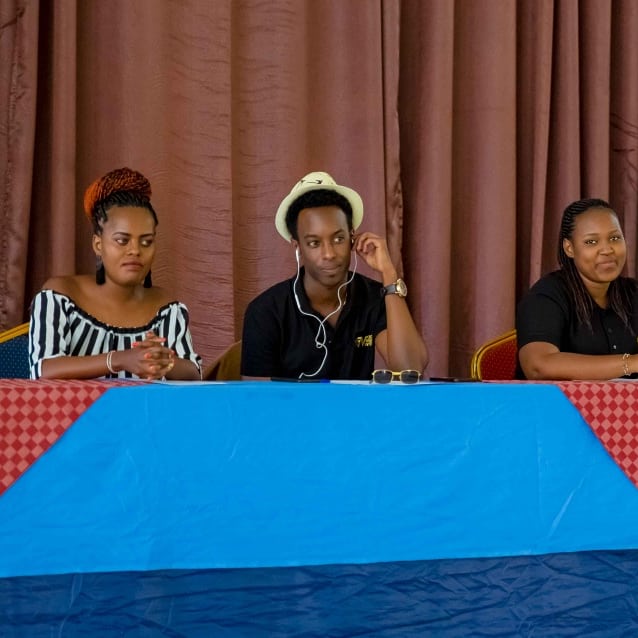 [PHOTO: Gisele Kamanzi from left during the model casting in KFW 2019, in Kigali City]
[PHOTO: Gisele Kamanzi from left during the model casting in KFW 2019, in Kigali City]
After reportedly being refused repayment by KFW, Ms. Kamanzi decided to take her case to social media, seeking public support to recover her funds. This move has sparked varied reactions within the fashion community.
Mrs. Rosa, a fashion industry insider, questioned the timing and approach of Ms. Kamanzi's allegations. "She was working with KFW for 10 years. Why didn't she ask for the money during all those years?" Mrs. Rosa pondered. "Also, going to social media is not professional. Rwanda has institutions that could help resolve this matter. I don't understand why she chose this route and what she hoped to gain from those influencers."
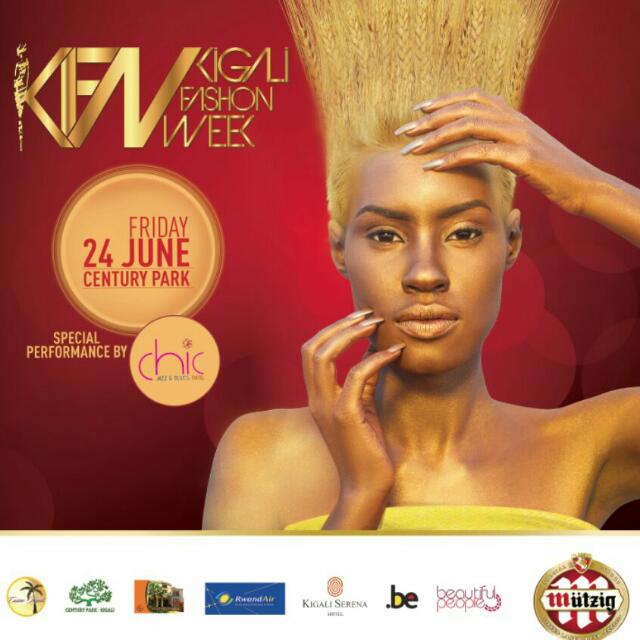 [PHOTO: A poster of the past edition of the Kigali Fashion Week]
[PHOTO: A poster of the past edition of the Kigali Fashion Week]
ALSO READ: Kigali Fashion Week is Still Running": Interview with the CEO and Founder John Bunyeshuli
The Twitter space was organized by a user under the GODFATHER account, and some other influencers attracted about 400 attendees. However, the discussion quickly derailed, with some speakers delving into Mr. Bunyeshuli's personal life rather than focusing on the financial dispute.
An entertainment journalist based in Kigali commented on the situation: "Some participants were talking about food and cooking, while others were confusing stories about Mr. Bunyeshuli with those of Daddy de Maximo, which are entirely different matters. I don't think fashion designers and models remember Mr. Maximo as they do Mr. Bunyeshuli. Compare the number of fashion shows Maximo did in Rwanda to the number of KFW editions."
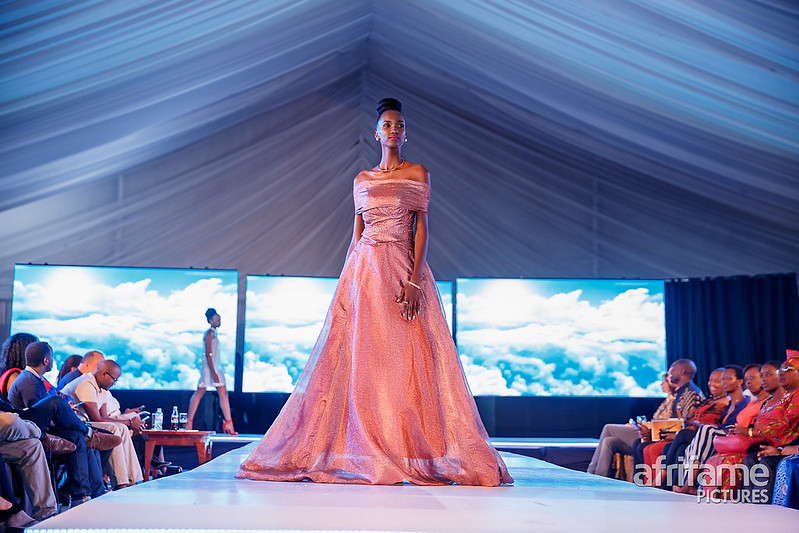 [PHOTO: Model on the runway during the Kigali Fashion Week's editon]
[PHOTO: Model on the runway during the Kigali Fashion Week's editon]
Mrs. Rosa suggested that the organizers of the Twitter space aimed to tarnish Mr. Bunyeshuli's reputation. "I was in that Twitter space. If you look closely at what people said about Mr. Bunyeshuli, it was very personal. Surprisingly, people I used to respect in the fashion industry were mixing up stories instead of being honest about what they know about Mr. Bunyeshuli and KFW."
To address these allegations, RCFS's MEDIA interviewed Mr. Bunyeshuli. Here are his responses to five key questions:
- Regarding the recent allegations:
Mr. Bunyeshuli dismissed the claims as "fabricated lies" meant to damage his reputation. He stated, "I know what I'm worth, and I will not defend myself over something that's not true. I'm in Kigali, and if there's any truth to what they said after 10 years of working with me, I suggest they use proper channels and authorities."
- On the current state of Rwanda's fashion industry:
"Rwanda fashion is dead and buried," Mr. Bunyeshuli declared. He emphasized the importance of acknowledging the industry's roots and respecting those who contributed to its growth.
- Advice for young fashion promoters:
Mr. Bunyeshuli urged young people to "open their minds and eyes" to discern who truly supports their development. He cautioned against aligning with those who resort to character assassination.
- Message to KFW supporters:
He revealed that Kigali International Fashion Week continues to run internationally, focusing on developing fashion in other countries. As for Rwanda, he stated, "I put a stop until haters learn that abusing me is not only insulting but also degrading the industry in the country."
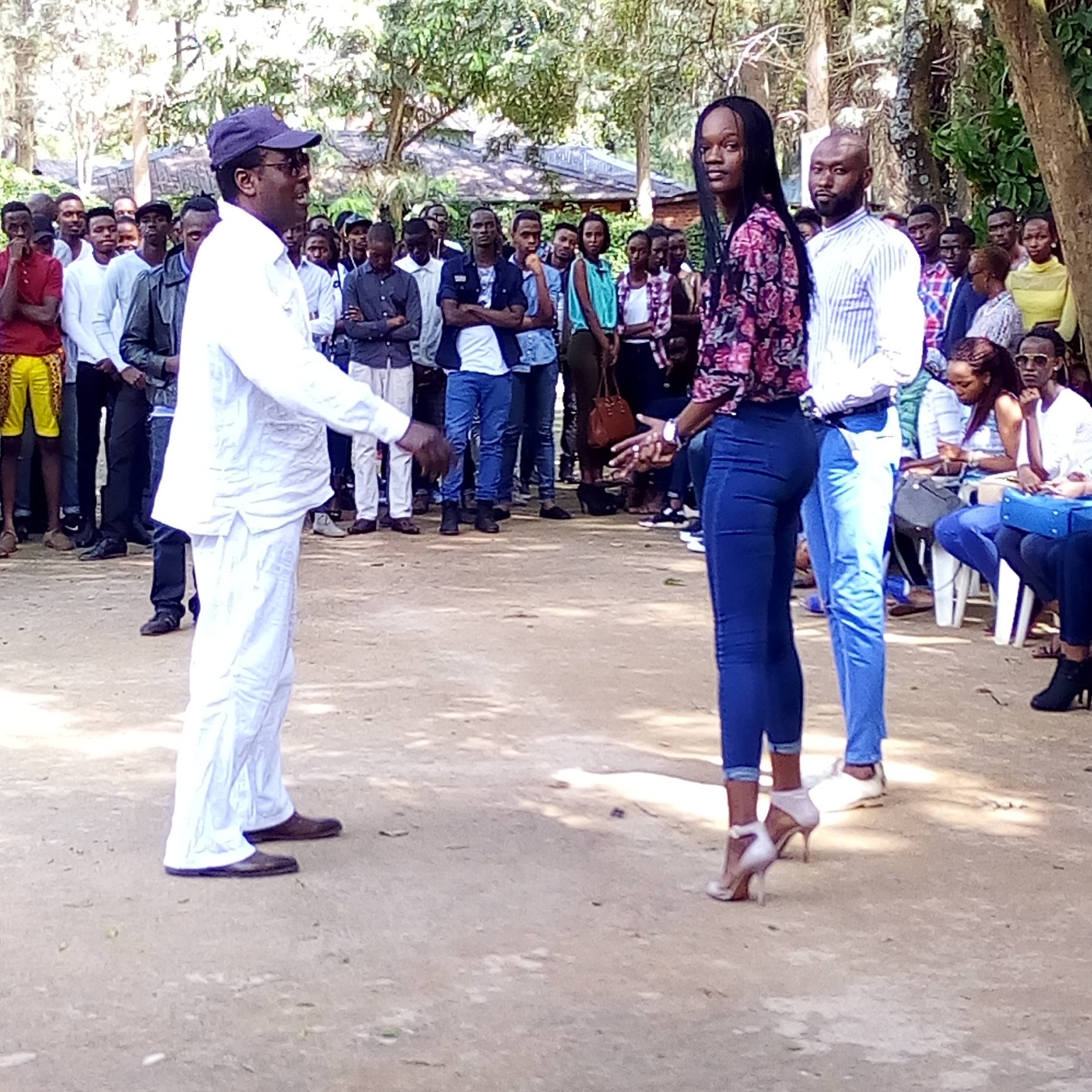 PHOTO: Mr. Bunyeshuli in a white, during the model casting in Kigali]
PHOTO: Mr. Bunyeshuli in a white, during the model casting in Kigali]
Mr. Bunyeshuli concluded with a philosophical note on life's impermanence and the importance of humility and good deeds. "Let's be humble, love others and ourselves, and do good on earth until that time comes to leave this physical world for the spiritual. That's my principle on earth."
This controversy has undoubtedly stirred the Rwandan fashion community, raising questions about professional conduct, the proper channels for dispute resolution, and the long-term impact on the industry's growth and reputation.
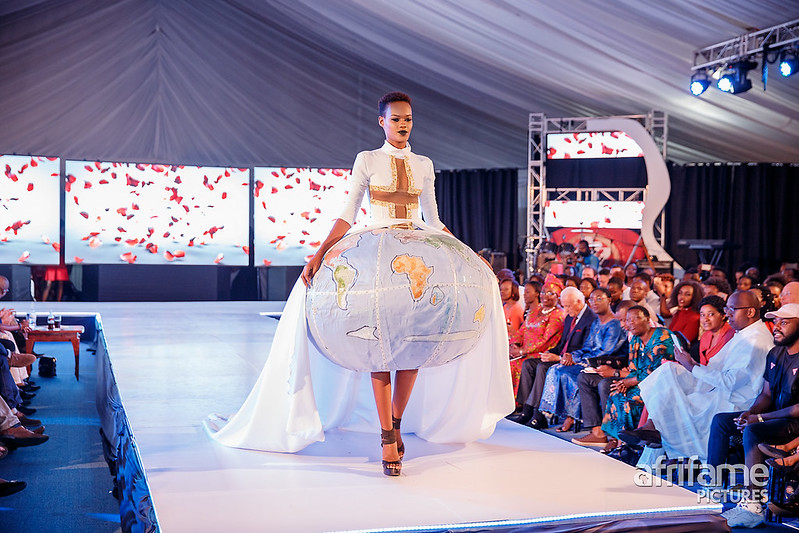 [PHOTO: Model on the runway during the Kigali Fashion Week's editon]
[PHOTO: Model on the runway during the Kigali Fashion Week's editon]
LATEST NEWS
What Fashion Entrepreneurs Will Benefit from the Kuza Africa and RP-IPRC Kigali Partnership?
26 September 2024 233 hitsWhat Fashion Entrepreneurs Will Benefit from the Kuza Africa and RP-IPRC Kigali Partnership? In a significant move for Rwanda's fashion…
Who are the 10 Confirmed Fashion Designers at the 17th Edition of Swahili Fashion Week & Awards 2024?
25 September 2024 422 hitsWho are 10 Confirmed Fashion Designers at the 17th Edition of Swahili Fashion Week & Awards 2024? The 17th Edition…
9 Rwanda's Female Models Continue to Shine on International Fashion Stage 2024: Here's Why
23 September 2024 557 hits9 Rwanda's Female Models Continue to Shine on International Fashion Stage 2024: Here's Why In recent years, Rwanda's female models…
What is Working and What Needs to Change in Rwanda's Fashion Scene?
20 September 2024 485 hitsWhat is Working and What Needs to Change in Rwanda's Fashion Scene? Rwanda's fashion industry encompasses a broader perspective than…
Turning Locals into the Next Sustainable Fashion Designers in Kenya: Maisha by Nisria
16 September 2024 671 hitsTurning Locals into the Next Sustainable Fashion Designers in Kenya: Maisha by Nisria When Nur M'Nasria, a TV film producer,…
Tanga Designs Wins Best Dressed Male at The Silver Gala 2024: Interview with CEO Olivier Niyitanga
11 September 2024 1108 hitsTanga Designs Wins Best Dressed Male at The Silver Gala 2024: Interview with CEO Olivier Niyitanga Tanga Designs has become…
FASHION SHOPS
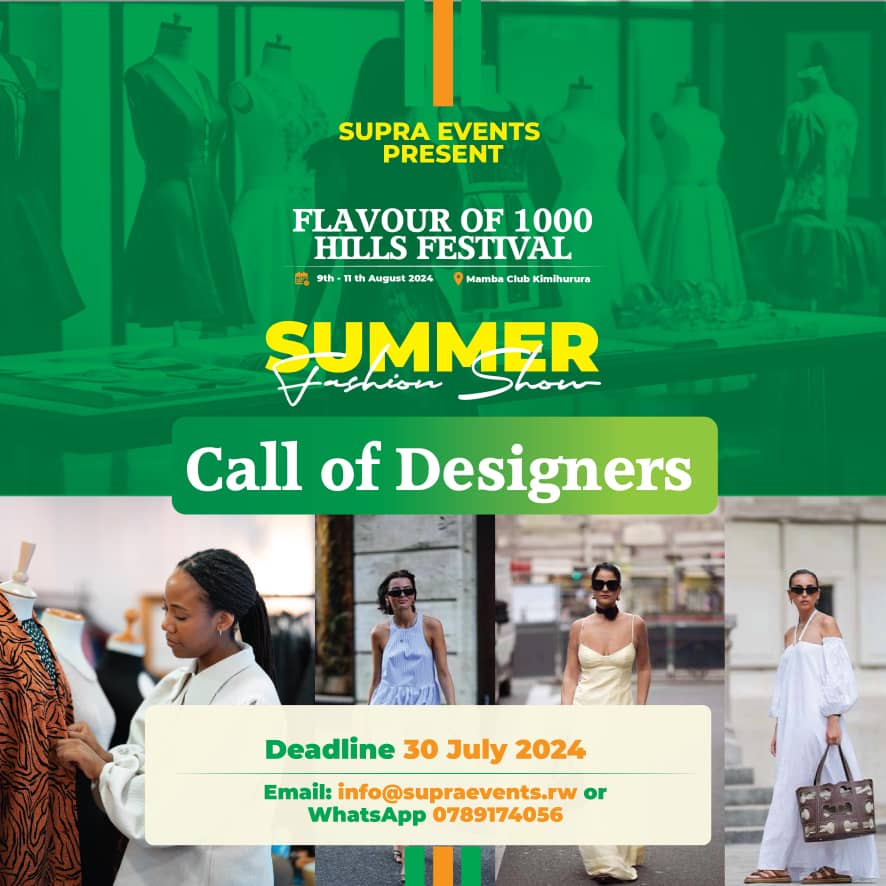



![[PHOTO: Summer bag made by Cesta Collective and 100 % hand woven bag by women in Rwanda, and the finish is made in Italy]](/media/k2/items/cache/bc61c35998920c79a57e03ad91265e8b_Generic.jpg)
![[PHOTO: Summer bag made by Cesta Collective and 100 % hand woven bag by women in Rwanda, and the finish is made in Italy]](/media/k2/items/cache/64f7b8990be2d94add5152c155ac4915_Generic.jpg)
![[PHOTO: From right -In all black, Moses Turahirwa CEO and founder of the Moshions clothing brand based in Rwanda]](/media/k2/items/cache/73c564de315ae81db9aaa50a11f02581_Generic.jpg)
![[PHOTO: From left, Mrs Heritage International Kenya 2023 Cynthia Kimathi, Ambassador of Kenya to Thailand H.E Kimwole Kiptiness and Miss Heritage International Kenya 2023 Prudence Tendwa]](/media/k2/items/cache/f203d630ce0c3265f9c9461092194e6b_Generic.jpg)
![[PHOTO: Female runway model on the stage of the La Femme Fashion Show in the recent edition]](/media/k2/items/cache/391d45802a606be64095bd7b66c67316_Generic.jpg)
![[PHOTO: Collection made by Asantii fashion brand from Kenya- Model: Selamawit Tsuruy]](/media/k2/items/cache/dca6745fdbb9da5b038270324f6ced2f_Generic.jpg)
![[PHOTO: Collection made by Asantii fashion brand from Kenya- Model: Selamawit Tsuruy]](/media/k2/items/cache/71601b6fd7fc74a9f4eea8e6c1b43d35_Generic.jpg)
![[PHOTO: Second edition of the Novelty Fashion Week is expected to be an amazing show]](/media/k2/items/cache/bbdd9bab523659f72e79235cef0a8565_Generic.jpg)
![[PHOTO: Mr. Jean Nshogoza during the boot camp of the Stage Fashion Showcase 2024 at Mundi Center, in Kigali City]](/media/k2/items/cache/bd9435f235cb4005045f2e6c43e9346a_Generic.jpg)
![[PHOTO: John Bunyeshuli CEO and founder of the Kigali Fashion Week]](/media/k2/items/cache/d7a332411e14769f300879cf8b1d4da6_Generic.jpg)
